

GAME ON!
Y oung P rofessionals 2025
Have

Navigating
For

1
Max Gross Editor in Chief
Cathy Cunningham
Executive Editor
Tom Acitelli
Deputy Editor
Greg Cornfield
Associate Editor
Skip Card
Copy Editor
Andrew Coen, Isabelle Durso, Julia Echikson, Mark Hallum, Brian Pascus, Amanda Schiavo, Nick Trombola
Staff Writers
Josh Rozbruch
Social Media Editor
SALES
Brigitte Baron
Senior Partnerships Director
Sona Hacherian
Strategic Account Director
Mark Rossman, Olivia Cottrell Partnerships Director
MARKETING & EVENTS
Samantha Stahlman Director of Audience
Faith Akinboyewa
Senior Events Manager
DESIGN, PHOTO & PRODUCTION
Jeffrey Cuyubamba
Art Director
Rohini Chatterjee
Senior Visual Designer
Jim Sewastynowicz
Photo Editor
Eliot Pierce
SVP, Product & Operations
Francesca Johnson Director, Revenue Operations
Brianna Scottino
Account Coordinator
Ramon Encarnacion IT Manager
OBSERVER MEDIA
Joseph Meyer Chairman
HUSTLE PLAY: BKREA’s Ryan Candel, Gensler’s Tyler Winograd and Blackstone’s Aliza Herz are making it rain every single day in commercial real estate. (Photographs taken at The Dime Residences in Williamsburg, Brooklyn.)
























































News
Planning Commission OKs
Adams’s
Midtown South Plan
The Midtown South Mixed-Use Plan is on its way to the next stage of approval after the New York City Planning Commission gave it the green light.
The city agency led by Dan Garodnick approved the plan, which could clear the way for 9,700 new housing units across 42 blocks of Midtown South through a rezoning that allows for taller residential buildings in the area. The plan has been updated since the latest version was submitted in October 2024
The neighborhood plan aims to lift the allowable floor area ratio (FAR) — a calculation of the amount of floor space that can be built vertically in relation to the size of the lot on which the building stands
— from 12 FAR to either 15 or 18.
Up to 2,900 of the 9,700 units must be deemed affordable under Mandatory Inclusionary Housing, which requires that developers of any project over 10 units must set aside 20 to 30 percent of those homes for low-income New Yorkers.
“With commercial vacancies too high and housing vacancies at historically low levels, it’s a perfect time to seize this opportunity to create a 24/7, mixed-use neighborhood. This plan will bring forth a vibrant mix of commercial, manufacturing and residential uses, creating a truly dynamic community here,” Garodnick said in a statement.

The original draft of the plan was introduced by Garodnick, under the direction of Mayor Eric Adams, in March 2024 with the original aim of creating 4,000 new homes in the target area. That has since been expanded to the current figure.
The Midtown South Mixed-Use Plan is expected to supplement the City of Yes for Housing Opportunity, a series of zoning reforms that were formally adopted by the New York City Council in December 2024
and is similar to the citywide approach to zoning that is projected to create 80,000 new housing units over 15 years.
The Adams administration may be facing a deadline to get the new plan through the finish line in the City Council, as Adams faces intense political opposition in his bid for re-election. Adams dropped out of this month’s Democratic primary and is running as an independent in the November election.—Mark Hallum
Mayor Announces Partners to Build Housing on Coney Island
Mayor Eric Adams has announced new partners to build roughly 1,100 homes in Brooklyn’s Coney Island.
As part of Adams’s broader housing plan for the summer tourist spot, the city will partner with BFC Partners Development to complete Coney Island Phase III, which will bring 420 affordable apartments, roughly 10,700 square feet of commercial space and roughly 9,700 square feet of community facility space to the area, according to an announcement on June 17.
Coney Island Phase I was completed in 2023 and created 446 affordable housing units, as well as 15,000 square feet of retail space and 66,000 square feet of office space for the New York City Housing Resources Administration Coney Island Phase II created another 376 housing units, 20,000 square feet of retail and community space, and a 2,500-squarefoot NYC Health + Hospitals facility, the announcement said.
The Phase III development at 1709 Surf Avenue will be supported by more than $90 million in subsidy from the Adams administration, as well as a $116 million construction loan supported by the New York City Housing Development Corporation (HDC).
“At BFC Partners, we remain committed to building and preserving high-quality affordable housing,” Win Wharton, principal at BFC Partners, said in a statement. “We are especially proud of our work in Coney Island, where projects like this play a vital role in strengthening and stabilizing New York City’s neighborhoods.”
In addition, the city will partner with Settlement Housing Fund to build another 178 affordable units as
part of the nearby Coney Landing Project at 2952 West 28th Street, according to the announcement.
“With 60 percent of units dedicated to supportive housing for formerly homeless individuals and families, and additional affordable apartments ranging from 30 percent to 60 percent of the area median
“Finding a home in Coney Island should not be a roller coaster ride.”
income, this project stands as a powerful response to the strong need for more affordable housing across New York City,” Judy Herbstman, president of Settlement Housing Fund, said in a statement.
The two partnerships come after the New York City Economic Development Corporation (EDC) issued a request for proposals in February for an 80,000-square-foot, city-owned site on Surf Avenue between West 21st and West 22nd streets for a project called Coney Island West, which is set to create more than 500 mixed-income homes, 25 percent of which
will be affordable, as Commercial Observer previously reported
The EDC will select a developer for Coney Island West by the end of the year, the announcement said. Combined, all three projects will deliver roughly 1,100 new homes across Coney Island over the next three years.
“Finding a home in Coney Island should not be a roller coaster ride,” Adams said in a statement. “That’s why we’re creating 1,100 new homes in this neighborhood so that more families can live in this iconic New York City community.
“But we’re not stopping with Brooklyn — our administration is shattering affordable housing records, year after year, and advancing generational projects across all five boroughs to make New York City the best place to raise a family,” Adams added.
Adams’s plans for Coney Island also include a renovation of the Riegelmann Boardwalk, a $42 million renovation of the Abe Stark Sports Center and improvements to the neighborhood’s streets and sewers, according to the announcement.
Meanwhile, plans for a shiny new casino on Coney Island are also moving forward.
Last month, Thor Equities, Saratoga Casino Holdings, the Chickasaw Nation and Legends finalized their plans for a proposed $3 billion casino development in the neighborhood, which would include a 500-room hotel, a 2,500-seat concert venue, 70,000 square feet of retail space, and 90,000 square feet of meeting and event space, as CO previously reported.— Isabelle Durso
SOUTHERN EXPOSURE: Reforms could add 9,700 housing units to 42 blocks in Midtown South
DAN WITH THE PLAN
Invesco Real Estate Credit Solutions congratulates Andrew Kim and the class of 2025

and local insights.
Invesco Real Estate Credit Solutions — Powered by global expertise
Fulton Street
Brooklyn Developer Plans 120-Unit Residential Project at 1445

A developer has big plans for new housing in Brooklyn’s Bedford-Stuyvesant neighborhood.
Brooklyn-based developer Jacob Fulop has filed an application to build a new 12-story, 76,268-square-foot residential property at 1445 Fulton Street with a total of 120 apartment units, according to a filing last week with the New York City Department of Buildings
Fulop bought the building and its neighboring 1439 Fulton Street and 484 Tompkins Avenue in May 2024 for a combined total of roughly $5.5 million, records show. Fulop filed demolition permits in February for all three buildings, but 1445 Fulton Street is the only property he has filed a new building application for, so far, and the only one that has been demolished.
The filing submitted last week shows plans for 80 residential units, and retail space on the ground floor of 1445 Fulton Street.
However, the filing also shows that
U.S. Office Supply Set to Shrink Due to Conversions and Demolitions
For the first time in roughly 25 years, the overall supply of office space in the U.S. is set to shrink, with office-to-residential conversions playing a big part.
Over the past few decades, developers — incentivized by low interest rates and federal tax breaks — built a gluttonous amount of office towers in U.S. cities. This caused a stark oversupply of empty space, especially after the COVID-19 pandemic created an unprecedented spike in hybrid and remote work.
But an end to the oversupply is finally in sight as conversions and demolitions — as well as developer uncertainty as a result of tariffs — all finally take their toll on office inventory nationwide.
About 23.3 million square feet of office space is on track to be converted to non office uses or demolished this year, significantly outpacing the 12.7 million square feet of expected new office supply, according to a recent report from CBRE, which gathered data from the 58 markets tracked by the firm.
A spokesperson for CBRE did not immediately respond to a request for comment.
Since the pandemic, both demolition and conversion activity have accelerated, with the U.S. office conversion pipeline reaching 81 million square feet of planned projects across 44 markets as of May, up from 71 million square feet across 42 markets six months ago, the report found.
In addition, an annual record of 94 conversion projects totaling 13.1 million square feet were completed in the U.S. in 2024, compared to the average 58 annual office conversions completed from 2018 to 2023, according to CBRE. In 2025, the country is expected to see approximately 68 conversions totaling 12.8 million square feet.
More than 70 percent of the planned and ongoing conversion projects are set to become multifamily properties, with 28,500 housing units already delivered since 2018 and another 43,500 planned, CBRE said. Most conversion activity is taking place in major U.S. cities, including New York City, Los Angeles and Washington, D.C.
New York City is leading the conversion push with 8,310 new housing units in the pipeline as of February, a large chunk of which will come from major projects such as Apollo Global Management, SL Green Realty and RXR’s conversion of the 1.1 million-squarefoot office building at 5 Times Square into as many as 1,250 housing

units, and Metro Loft Management and David Werner Real Estate Investments’ plan to turn the former Pfizer headquarters at 235 East 42nd Street into a total of 1,600 units. Meanwhile, D.C. is planning 6,533 new housing units and L.A. is expected to see 4,388, as Commercial Observer previously reported In D.C., private equity firm Henderson Park and L.A.-based real estate investment and development company Lowe are converting the 536,000-square-foot office building at 1250 Maryland Avenue SW into an 11-story, 658,000-square-foot apartment complex with 428 units and 53,000 square feet of retail and commercial space, as CO reported
And in L.A., multifamily developer Jamison Properties leads the way with a growing slate of office-to resi projects, including its plan to turn the former Pierce National Life Building at 3807 Wilshire Boulevard into 210 apartments, CO reported.—I.D.
Fulop intends to ultimately build a total of 120 apartment units on the lot. It’s unclear whether all 120 units will be included in one building or within multiple buildings on the site.
Fulop and a spokesperson for Kao Hwa Lee Architects, which is listed as the architect on the project, did not immediately respond to requests for comment.
News of the project comes after Fulop bought the office building at 545 Broadway in Williamsburg in June 2022 for $23 million, according to Crain’s New York Business
His project is also one of many new residential developments planned in Brooklyn, with a total of 3,080 new apartments proposed in the borough during the first quarter of 2025, Crain’s reported. Those developments include Goose Property Management’s 163-unit project at 570 Fulton Street in Downtown Brooklyn and Thorobird’s 213-unit affordable apartment building at 581 Grant Avenue in Cypress Hills.—I.D.
Skyline Developers’ Orin Wilf has sold off the office portion of his family’s properties at 9-11 West 54th Street, according to property records.
Greenwich, Conn.-based Interlaken Capital purchased 9-11 West 54th Street from the Wilf family for $38 million. The family had bought two Gilded Age buildings — the office building at 9-11 West 54th Street, and a residential property at 10 West 55th Street — for $75 million in 2019, with $20 million of that going toward the 54th Street property. The family had no particular plans for the investment, Wilf told The Real Deal at the time.
Skyline backed the acquisitions with a $91 million loan from Goldman Sachs
Interlaken Capital was founded in 1979 by William Robert Berkley and the deed is co-signed with the William R. Berkley Foundation, according to property records. Interlaken Capital could not be reached for comment. Skyline Developers did not immediately respond to a request for comment.
McKim, Mead & White, the architecture firm that designed the original Pennsylvania Station, which was famously demolished in the 1960s, was the outfit behind the look of 9-11 West 54th Street. It was built sometime between 1896 and 1898 for New York City businessman James Junius Goodwin, and is known to the New York City Landmarks Preservation Commission as the James J. Goodwin Residence — M.H.
IN THE MIX: Plans for 1445 Fulton Street include housing and retail.
TURNING OFFICE OFF: Office supply is shrinking in the U.S. as conversions gain in popularity.

THE MOST BRILLIANT IDEAS ONLY MATTER WHEN YOU CAN BRING THEM TO LIFE.
Congratulations to Benjamin Bouganim, Cecelia Galligan, Sam Hoffman and Patrick O’Rourke for being recognized on Commercial Observer’s 2025 Top Young Professionals List.

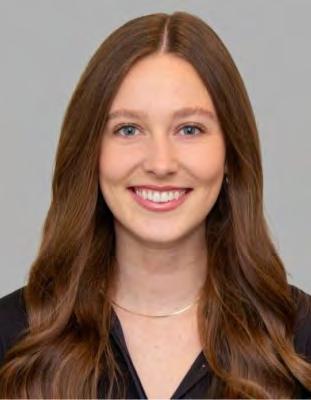
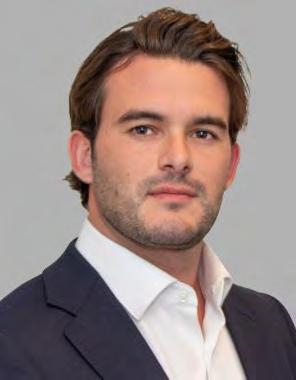

Benjamin Bouganim
Cecelia Galligan
Sam Hoffman
Patrick O’Rourke
Lease Deals of the Week





A New York City public school is staying at The Factory in Long Island City, Queens, awhile longer, Commercial Observer has learned.
The New York City School Construction Authority (NYCSCA) has signed a 15-year renewal on behalf of New York City Public Schools for the 75,000-square-foot Robert F. Wagner Jr. Secondary School for Arts and Technology on part of the ground and second floors of Atlas Capital Group’s 30-30 47th Avenue, according to a source with knowledge of the deal. Asking rent was $45 per square foot.
The NYCSCA is responsible for building new public schools and managing the design and construction of existing schools in the city, according to its website
Robert F. Wagner has been a tenant of the building between 30th Place and 31st Street since 1995, the SCA said.
Newmark’s Brian Waterman, Jordan Gosin and Alex Rosenblum brokered the deal for the landlord, while the NYCSCA represented itself.
Newmark declined to comment, while a spokesperson for Atlas did not respond to a request for comment.
Other tenants of the 10-story, 1.2 million-square-foot building on 47th Avenue include toy company Cardinal Industries, contracting firm TEI Group, promotional products distributor Halo Branded Solutions and apparel brand Ralph Lauren, which expanded its photo studio at The Factory to 54,602 square feet in March 2023. — I.D.
It’s 11:30 (somewhere) and the club is jumpin’, jumpin’.
Trampoline park Sky Zone is setting up its first New York City location at 2350 East 69th Street in Brooklyn’s Mill Basin neighborhood, having signed a 52,100-square-foot, long-term lease at the property, Crain’s New York Business first reported.
Landlord Turnbridge Equities represented itself in the deal. Turnbridge did not respond to Commercial Observer’s request for comment. Josh Gosin and Jordan Gosin from Newmark represented Sky Zone in the deal. Newmark didn’t respond to a request for comment.
Asking rent was not available, but the average asking rent for industrial space in Brooklyn runs between $15 and $40 per square foot, according to Cushman & Wakefield data.
Turnbridge Equities acquired the one-story warehouse for $8.9 million in January of last year. The space is currently occupied by the fitness club MatchPoint.
“Expanding in Brooklyn is an exciting step forward in our mission to make active play more accessible to families nationwide,” Mike Revak, chief operating officer of Sky Zone, told CO via email. “Brooklyn, and the greater New York City area, remains a key focus as we continue to grow the Sky Zone brand on our path to 500 parks.”
The Mill Basin location is scheduled to open during the fourth quarter, a source close to the deal told CO via email. — Amanda Schiavo
Gymnastics studio NYC Elite, which provides gymnastics programs and coaching instruction for people of all ages, signed a 20-year renewal for its 20,908-square-foot studio at 40 Worth Street, a Tribeca building owned by Jeffrey Gural’s GFP Real Estate
The gymnastics company moved into the 16-story building between Church Street and West Broadway — also known as the Merchants Square Building — in January 2015, as Commercial Observer previously reported NYC Elite’s space at the property comprises 10,987 square feet of ground-level space, 2,761 square feet of mezzanine space, and 7,160 square feet of lower-level space, according to GFP.
“We are beyond excited to renew our lease and not only continue to work alongside the Gural family, but also to have the opportunity to continue bringing joy and confidence to the kids in our community through gymnastics,” Tina Ferriola, founder and president of NYC Elite, said in a statement.
The asking rent was not provided, but when NYC Elite signed its lease at 40 Worth in 2015, asking rents for the space were $95 per square foot on the ground floor and $45 per square foot on the sublower level, CO reported. GFP’s Roy Lapidus brokered the deal for both the tenant and the landlord.
NYC Elite’s Tribeca spot is its third location in Manhattan, joining 421 East 91st Street on the Upper East Side and 200 Riverside Boulevard on the Upper West Side, according to its website. — I.D.
What would you find in “a playground for the intellectually adventurous?”
Darwin’s monkey bars? A slide into relativity? The see-saw between Stoicism and hedonism?
Because that is the slogan for a new social club from Lightning Society, a 20-year-old social organization that just signed a 19,000-square-foot lease for a members-only club at Chetrit Organization’s cast-iron 45 Howard Street (also known as 427 Broadway) in SoHo, at the corner of Broadway and Howard Street. 45 Howard Street will host the club’s entrance, while 427 Broadway is the building’s retail entrance.
The new club, backed by executives from WeWork, Soho House and Burning Man, will be Lightning Society’s first permanent home.
Lightning Society founder and CEO Timothy Phillips wouldn’t disclose the exact terms of the lease, but said it was “a very, very long lease,” and called the rent “substantial, but below market.”
Aaron Ellison at Newmark represented Lightning Society. The Chetrit Organization was repped by Newmark’s Howard Kesseler Jr., according to Phillips.
The new club will occupy the building’s top four floors and the rooftop terrace, which constitutes the entire building except the lowerlevel retail. The new endeavor replaces a museum called The House of Cannabis. News of the lease was first reported by The Real Deal. — Larry Getlen
Retail real estate owner, operator and developer Macerich is moving its New York City office to a new location.
The firm has inked a 13-year, 12,000-square-foot lease at 825 Third Avenue, landlord The Durst Organization announced. Asking rent was $96 per squarefoot for the Midtown East space. Macerich’s website lists its current New York City office at 500 Fifth Avenue
It is unclear when the firm will make the move to Third Avenue. Macerich did not respond to a request for comment.
The Durst Organization was represented in house by Tom Bow, Ashlea Aaron, Bailey Caliban and Sayo Kamara. Macerich was represented by Gordon Ogden and James Hart of Bradford Allen
“Macerich joins an esteemed and growing roster of firms who have moved to 825 Third Avenue looking for a modern, sustainable workplace and convenient amenities, including our retailers and indoor-outdoor [amenity space called] Well& by Durst that acts as an extension of their office,” Jody Durst, president of The Durst Organization, said in a statement. Bow, Aaron, Caliban and Kamara were unavailable to provide a comment.
“Macerich is pleased with their move to 825 Third Avenue and the building’s recent upgrades which suits their growing business,” Ogden told Commercial Observer via email. The company will occupy an entire floor of the Third Avenue building. — A.S.







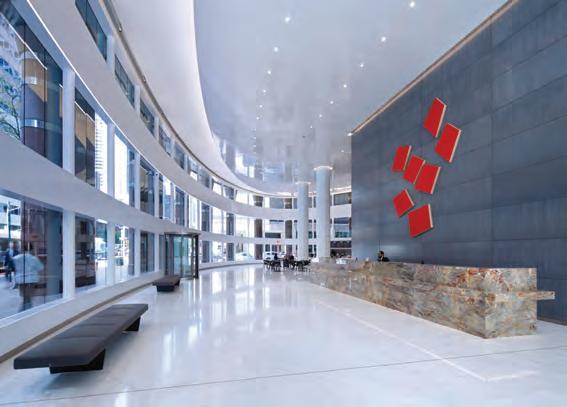






Lease Deals of the Week





An arts and crafts goods retailer is sticking to its knitting in Brooklyn after taking space in Industry City
Artist & Craftsman Supply signed a 10-year, 10,101-squarefoot lease in the complex owned in a joint venture by Jamestown, Belvedere Capital, Cammeby’s International, FBE Limited, and TPG Angelo Gordon, according to the landlords.
The tenant will relocate from 307 Second Street in Park Slope, Brooklyn, to Building 4 of the converted industrial complex in Sunset Park.
Representatives for the landlord did not disclose the asking rent in the deal, but industrial space in Industry City ranged from low- to mid-$20s per square foot as recently as March
“Industry City’s expansive and renowned hub of artists and creatives makes for the perfect home for Artist & Craftsman Supply,” Industry City Senior Vice President of Leasing Jeff Fein said. “Adding a leading art supply store like Artist & Craftsman Supply reflects our mission to build an ecosystem where creative businesses can both make and sell, prototype and scale — all on the same campus.”
Nick Shears, vice president of leasing at Industry City, represented the landlord in-house.
Other tenants in the complex include biotechnology company Cresilon, cycling organization Bike New York, and design studio Staged To Sell Home
— Mark Hallum
Crypto firm Artemis is taking over some office space in SoHo, Commercial Observer has learned.
Artemis, which provides data and analytics for digital assets, has signed a five-year sublease for 5,539 square feet on the ninth floor of Northwood Investors’ 520 Broadway, according to broker Current Real Estate Advisors Asking rent was $110 per square foot.
Artemis subleased the space from crypto investment firm Paradigm, said Current. It’s unclear whether this is a new location or a relocation for Artemis, which has a current address at 141 East Houston Street
“These deals underscore the sustained strong demand for crypto and Web3 spaces, particularly here in SoHo,” Current’s Adam Henick, who brokered the deal for the tenant along with Rob Kluge, said in a statement to CO.
“We’re proud to continue facilitating the majority of transactions in this vibrant sector.”
It’s unclear who represented the landlord in the deal.
Spokespeople for Artemis, Northwood and Cushman & Wakefield, which is listed as the leasing contact for the property, did not immediately respond to requests for comment.
News of the deal comes after a few other new leases at the 11-story 520 Broadway, including crypto firm MoonPay’s deal in April to lease more than 5,000 square feet on the eighth floor, and a health care company’s recent lease on the seventh floor, Current said.— I.D.
Department store chain Nordstrom will open its third retail service hub in New York City, this one in Williamsburg, Brooklyn.
Nordstrom Local, Nordstrom’s sister brand, has signed a lease for 3,000 square feet at 154 North Seventh Street, according to a Monday announcement from the company.
Nordstrom’s store at the base of the four-story building between Bedford Avenue and Berry Street, which is owned by Williamsburgh Square LLC, will open June 26, the announcement said.
“New York is one of our largest markets, and we’re looking forward to opening Nordstrom Local Williamsburg to offer Brooklyn customers even more opportunities to engage with our services closer to where they live and work,” Fanya Chandler, president of Nordstrom stores, said in a statement.
The length of the lease and asking rent were unclear, but a report from the Real Estate Board of New York found retail rents in Williamsburg averaged $250 per square foot in 2024 (the most recent data available).
It’s also unclear who brokered the deal. A spokesperson for Nordstrom did not respond to a request for further comment, while the landlord could not be reached for comment.
The brand’s new Williamsburg store represents its third Nordstrom Local outpost in the city, following openings at 13 Seventh Avenue in the West Village and 1273 Third Avenue on the Upper East Side, according to its website. — I.D.
It’s not stretching the truth to say this flexibility service is catching on.
StretchLab, a mobility-improving studio known for its musclestretching treatments, has taken 1,300 square feet of retail space at the 499-unit residential building the Jasper, located at 2-33 50th Avenue in Long Island City, Queens, landlord representative Igloo announced.
Retail space at the Jasper — owned by residential developer The Domain Companies — is now 100 percent occupied, and spans 35,000 square feet across the building’s ground floor. The space also houses 10 other businesses including grocers, restaurants, and wellness service providers.
“The lease-up at Jasper is a great example of the value-proposition of the Igloo platform,” Adam Joly, principal at Igloo, said in a statement. “The project will benefit from a wide range of retail activations which will enhance the resident experience and deliver impactful business offerings to the LIC area.”
StretchLab was represented by Ripco’s Peter Yoon. Ripco did not immediately respond to a request for comment.
Asking rent and the length of the lease were not disclosed, but average asking rent for retail space in Queens is $49.04 per square foot, according to PropertyShark
Other retailers occupying ground-floor space at the Jasper include children’s clothing store Peanut and Honey, and restaurant Frankie’s Brooklyn Pizza. — A.S.
Studio Pilates International is extending its presence in New York City.
The 23-year-old Australianborn fitness services brand inked a five-year, 1,126-square-foot lease at 301 West 110th Street in Harlem. The lease deal includes a five-year renewal option.
The Harlem outpost be the brand’s first Manhattan location, tenant broker Norma Ashkenazi of KSR told Commercial Observer. Ashkenazi brokered the deal alongside Eli Yadid. It is not clear who brokered the deal for landlord Argo, which did not respond to CO’s request for comment.
The New York Business Journal first reported this lease. Asking rent for the space was not available, but previous Commercial Observer reporting noted asking rent of $85 per square foot for retail space in Harlem.
“It was a pleasure representing Studio Pilates in their first Manhattan lease,” Ashkenazi said via email. “Their upscale, boutique concept will add real value to the neighborhood.”
The building at 301 West 110th Street is a 47,533-square-foot condominium building with 599 residential units, according to Property Shark.
Studio Pilates International was founded in 2002 by husband and wife Jade and Tanya Winter. This latest Studio Pilates International location is set to open on July 12, while the company’s first New York City location opened in Brooklyn in 2021. — A.S.

















ANAGRAM TURTLE BAY













RUBY






Congratulations to on being named one of Commercial Observer’s 2025 Top Young Professionals. Here's to what you've built and what's still to come. Adam Freindlich
MABEL
FINANCE
Debt Deals of the Week

Wells Fargo Provides $460M Refi for Hell’s Kitchen Multifamily Development
Gotham Organization has sealed a $460 million debt package to refinance a 1,238unit multifamily development in Manhattan’s Hell’s Kitchen neighborhood.
Wells Fargo’s multifamily capital group, led by Peter Cannava, closed the direct bond purchase facility for the developer’s Gotham West property that consists of 555 market-rate apartments along with 683 units designated as affordable or middle income, according to the lender.
The deal comprises $260 million of fixed-rate debt and $200 million of floating-rate debt, with Wells Fargo also obtaining a credit enhancement for the deal from Fannie Mae. It refinances an existing 10-year direct purchase that Wells Fargo has held since 2011 when it co-led a construction facility for the project.
Located at 550 West 45th Street, the 2013-built Gotham West was financed with 100 percent taxexempt bonds issued by the New York State Housing Finance Agency in exchange for setting aside roughly half of the apartments as affordable or middle income. Its amenities include two fitness centers, an outdoor courtyard, a roof deck, coworking space and two children’s playrooms.
Officials at Gotham Organization did not return a request for comment. —A.C.
Meridian Arranges $173M Loan for UES Apartments in First Agency Deal Since 2023 Freddie Mac Ban
Meridian Capital Group is officially back in the agency financing game.
The brokerage giant closed a $173.1 million Freddie Mac-backed loan originated by NewPoint Real Estate Capital on behalf of investor Rubin Schron to refinance the Monterey luxury apartment building on Manhattan’s Upper East Side in a deal that closed Monday, Commercial Observer can first report.
The 10-year loan, which was arranged by Meridian’s Matt Texler, carries a 5.07 percent interest rate with eight years of interest-only payments and a 35-year amortization schedule.
The deal marked the first agency deal for the firm since Freddie Mac and Fannie Mae placed restrictions on Meridian-brokered loans in November 2023 when a loan it negotiated was called into question.
“It shows to the market that we’re not just technically back in the agency market, we are really back in a big way, “ Meridian CEO Brian Brooks told CO in an interview last week. “It’s not just that somebody said we can do it, we are executing on it.”
Brooks said it took about three months to “find the right deal,” and a sponsor who would be an ideal fit to announce a relaunch of Meridian’s agency-lending business. He said there were unknowns about whether agency debt would even be the right fit for the loan given the volatile market conditions early this year, but more recent market conditions allowed Meridian to lock in an attractive interest rate for the financing.
NewPoint and Schron did not immediately return requests for comment.
The transaction closed on the heels of Freddie
Invesco
Mac lifting its ban late last year and Fannie Mae easing restrictions in April. Meridian also implemented new underwriting procedures with a screening process for all brokeraged transactions to ensure compliance, and also formed a management credit approval committee to review large loans as part of its enhanced procedures to end the bans.
The improved processes for GSE loans was spearheaded by Brooks, a former acting controller of the currency and general counsel at
“It shows to the market that we’re not just technically back in the agency market, we are really back in a big way.”
Fannie Mae, who replaced founding Meridian CEO Ralph Herzka as CEO in March 2024. Brooks credited Melissa Martinez, who he hired in June 2024 from CoreLogic as the company’s first chief risk officer, with paving the way for the company’s agency brokering relaunch.
“I brought her on because I’ve worked with her and known her for almost 20 years at this point. and she and I have done turnarounds together,” Brooks said of Martinez. The two
worked on OneWest Bank Group’s takeover of IndyMac 2009 when Brooks was vice chairman of the bank.
“She was a huge chief player in this and is very respected by the agencies since she used to have the senior multifamily risk role at Fannie Mae years ago,” Brooks said.
Brooks said Meridian will soon be arranging its first Fannie Mae deal since its suspension was lifted, and that the brokerage has several other agency transactions in the pipeline for 2025. He projects that by the end of the year Meridian will have executed around $500 million of agency loans.
Meridian was greenlighted to work again with Freddie Mac and Fannie Mae amid uncertainty about privatization of both GSEs after President Donald Trump’s appointment of private equity veteran Bill Pulte as chair of the Federal Housing Finance Agency.
Ending the conservatorship of Fannie and Freddie for the first time since the 2008 Global Financial Crisis has the potential to open up more deal flow, according to Brooks, with the addition of private capital and without the restrictions of annual caps.
While Meridian’s half-billion dollars of projected agency volume this year pales in comparison to the roughly $10 billion the brokerage achieved in 2021, Brooks said it represents a strong signal of a return to a crucial part of its capital markets business.
“There’s a line in startup land where they talk about how zero to one is a lot harder than one to 10,” Brooks said. “This is our zero to one loan. We took a year in the penalty box, and now we’re out. This is our first goal, and once you’re scoring you’re scoring.”—Andrew Coen
Real Estate Closes $355M Refi for 24-Asset Industrial Portfolio
A Bridge Investment Group subsidiary has secured a $354.6 million loan to refinance a portfolio of 24 industrial assets, spanning more than 2.4 million square feet across six states, Commercial Observer can first report.
Invesco Commercial Real Estate Finance Trust (INCREF), the private credit real estate investment trust owned by Invesco Real Estate, provided the financing to Bridge Logistics Properties, a real estate investment manager under the umbrella of its $49 billion alternative asset management parent firm.
The loan carries a loan-to-value ratio of less than 70 percent, while the entire infill industrial portfolio is currently “well-leased, cash-flowing,” according to Charlie Rose, global head of credit for Invesco Real Estate.
“This loan is complementary to our existing
portfolio of moderate leverage loans made to the highest quality institutional sponsors in the industry,” Rose added.
Matt Berger, chief financial officer at Bridge Logistics Properties, said in a statement that the new capital from Invesco strengthens his firm’s ability to execute a core logistics investment strategy across U.S. markets.
“We are proud to partner with Invesco in supporting long-term performance for this high-quality portfolio,” he added.
The 24-property portfolio spans a total of 2.45 million square feet across California, Washington, Texas, New Jersey, New York and Florida, according to Invesco.
Yorick Starr, managing director for Invesco Real Estate, noted in a statement that the $354.6
million loan goes hand in hand with INCREF’s strategy to originate income-generating loans secured by the best possible assets in what his firm considers to be “the most liquid markets” across the U.S. and Europe.
“Bridge Logistics Properties are exceptional investors and operators in these key logistics markets,” Starr added.
Rose, who also serves as the lead portfolio manager of INCREF, emphasized that the firm’s private credit real estate investment trust now carries a portfolio of 61 loans totaling $3.6 billion in commitments.
“Each loan we have closed this year has been representative of our consistent focus on the highest-quality segment of the floating-rate real estate credit market,” he said.
Brian Pascus
Wells Fargo’s Peter Cannava.
FINANCE

Miami Design District Owners
Land $125M to Build Multifamily Rental Tower
The owners of the Miami Design District are adding rental housing as part of an expansion of the 30-acre luxury shopping mall.
Amerant Bank and Bank Hapoalim provided $125 million to finance the construction of Cassi, a 107-unit multifamily tower at 91 Northeast 36th Street, just south of the Miami Design District and Interstate 195. Besides the housing component, the 20-story development will include 23,000 square feet of retail space on a half-acre site. Units will average 1,509 square feet.
The outdoor mall is also set to further expand. In 2022, Craig Robins’s Dacra, alongside partners, bought a collection of retail buildings along Northeast 39th Street for $166 million, with plans to add more retail, a hotel and possibly condos, which architect David Chipperfield will master design. Chipperfield won the prestigious Pritzker Architecture Prize in 2023.
The development team for Cassi consists of the Miami Design District Associates, Michigan-based Hunter Pasteur, and Palm Beach Gardens-based The Forbes Company. Miami Design District Associates — a partnership between Dacra and LVMH-backed L Catterton — developed most of the Miami Design District, which today is home to Chanel, Dior and Hermes boutiques.
Walker & Dunlop’s Sean Reimer, Aaron Appel, Keith Kurland, Jonathan Schwartz, Adam Schwartz, Jordan Casella and Michael Stepniewski represented the developers in securing the loan package.
Representatives for Dacra did not respond to requests for comment.
—Julia Echikson
Madison Realty Capital Lends $57M on 195-Unit Binghamton University Student
An Aptitude Development affiliate has landed a $57 million debt package for the purchase and construction of a student housing project serving Binghamton University, Commercial Observer has learned.
Madison Realty Capital (MRC) originated a senior mortgage and mezzanine loan for the 195-unit project that will sit 500 feet from the main entrance to Binghamton University’s main campus in Vestal, N.Y. where a Quality Inn & Suites now sits. Aptitude is slated to commence construction of the 516-bed The Marshall building in the third quarter and complete the complex ahead of the 2027-2028 academic year.
“Aptitude Development is an experienced developer of high-quality, pedestrian-to-campus student housing, and we look forward to delivering a highly amenitized and geographically desirable accommodation that will serve Binghamton University students for

Housing Project
years to come, Josh Zegen, principal and co-founder of MRC, said in a statement.
Binghamton currently enrolls 18,332 students with around half living on campus where supply is constrained, according to MRC.
The Broome County IDA approved a 20-year payment in lieu of taxes (PILOT) agreement for the student housing project in March, despite objections from the Vestal Town Board which claimed that the PILOT would cost it more than $10 million of lost tax revenue over the next two decades, The Press & Sun-Bulletin previously reported
The five-story development will consist of studio, one-, two- and four-bedroom apartments. Community amenities will include a fitness center, a sauna, a hot tub, a yoga studio, a meditation room, tanning beds, study rooms and a community clubhouse lounge.
Officials at Aptitude Development did not return a request for comment.—A.C.
Urban Standard Capital Provides $60M Loan for East Hartford Apartments
A joint venture between Jasko Development and Zelman Real Estate has nabbed $60 million of construction financing to repurpose of a former movie theater in East Hartford, Conn., into a multifamily property, Commercial Observer has learned.
Urban Standard Capital supplied the loan for the co-developer’s entity, Jasko Zelman 1, to facilitate the planned transformation of a vacant site that previously housed a Showcase Cinemas theater into a 300-unit apartment community called Concourse Park
“We are excited to support this transformative project that will bring much-needed housing to East Hartford,” Seth Weissman, founder and managing partner of Urban Standard Capital, said in a statement.
Paradigm CRE’s Adrian Edery arranged the transaction.
“The joint venture between Jasko Development and Zelman Real Estate brought together experienced, well-capitalized developers with a proven track record in multifamily,” Edery said in a statement. “That gave us confidence in their ability to execute at scale.”
The Town of East Hartford sold the long-vacant 25.6-acre parcel to Jasko Zelman in 2019 for $3.3 million. The sale was finalized this month after Zelman agreed to $10 million in public infrastructure funding for the project, according to Connecticut Insider.
Avner Krohn, chairman and CEO of Jasko Development, said public support for the project will enable rents to be “highly competitive”

and is hoping it can fill a housing need for an area with many large employers.
“We think it will help retain and attract some of the many workers in the area,” Krohn told CO. “This area hasn’t seen a new market-rate Class A product in decades.”
Krohn said the project is slated to break ground in a few months, with an estimated completion date in late 2027. The building will have community amenities that include an outdoor pool, a cabana area, grill stations and a fitness center.
Brian Zelman, principal of Zelman Real
Estate, said Concourse Park will mark the first market-rate apartment project for East Hartford in nearly 50 years. He credited local lawmakers with allocating necessary funding to enable the project to get off the ground.
“The development would not be possible without a public-private partnership with the Town of East Hartford, State of Connecticut and the Capital Region Development Authority,” Zelman said. “The location with significant frontage on I-84 and a few miles from the I-91/ I-84 junction is arguably the best situated site in the region.”—A.C.
The Marshall building at Binghamton University.
A rendering of Concourse Park at the former Showcase Cinemas location.
Dacra’s Craig Robins.
Chart Finance
CRE CLO Distress Rates Seesaw Back Above 13%
By Mike Haas
Following a dramatic reduction, the commercial real estate collateralized loan obligation (CRE CLO) market saw its distress rate rise by 80 basis points (bps) to 13.2 percent in May, according to CRED iQ’s latest data. Originations in the sector continue to be robust, so the picture is murky at best.
Investors hoping for a third consecutive reduction in the CRE CLO distress rate were left a bit disappointed as the benchmark added 80 bps to close at 13.2 percent in the May report. The underlying metrics were mixed, with the special serving rate shaving off 30 bps to 7.1 percent while the all-important delinquency rate added 130 bps, bringing
it to 11 percent.
Similar to last month’s data, our research team widened the aperture a bit to examine the velocity of the CRE CLO sector over the past year.
Total year-to-date CRE CLO issuance totals $10.5 billion across 11 deals. As a comparison, during the first four months in 2024, CRE CLO volume totaled only $2.2 billion (across three deals), meaning CRE CLO issuance velocities have increased 377 percent compared to last year. (Indeed, as we approach summer, it could be argued that CRE CLO issuance is already hot.)
Looking across a wider analysis of payment status reveals ongoing challenges. 64.4 percent of CRE CLO loans have surpassed their maturity date (up from 63.1 percent last month). More than a third (36.6 percent) are classified as “performing

matured” — down from 37.3 percent. This suggests that many borrowers are exercising extension options or negotiating month-to-month arrangements to avoid default.
Precisely half (50 percent) of CRE CLO loans have surpassed their maturity date and are not performing, which is a record. This metric was 25.6 percent in our January print. May’s data showed that 14.3 percent of CRE CLO loans are current — down from 16.8 percent last month. Delinquent Loans (pre-maturity) account for 21.3 percent, which is the third consecutive monthover-month increase.
These figures reflect a market grappling with the aftermath of loans originated in 2021 and 2022, when cap rates were compressed, valuations were elevated, and interest rates were historically low. Many
of these loans, structured with floating rates and three-year terms, are now hitting maturity walls in a dramatically different economic environment.
Case study: Norterra Canyon Apartments
A real-world example illustrates the pressures facing CRE CLO borrowers. The $58.6 million Norterra Canyon Apartments loan, backed by a 426-unit multifamily property in Las Vegas, highlights maturity-related challenges. The loan was added to the servicer’s watchlist in November 2024 due to pending loan maturity. Set to mature in May 2025, the loan transitioned to non- performing mature status in May 2025.
Mike Haas is the founder and CEO of CRED iQ
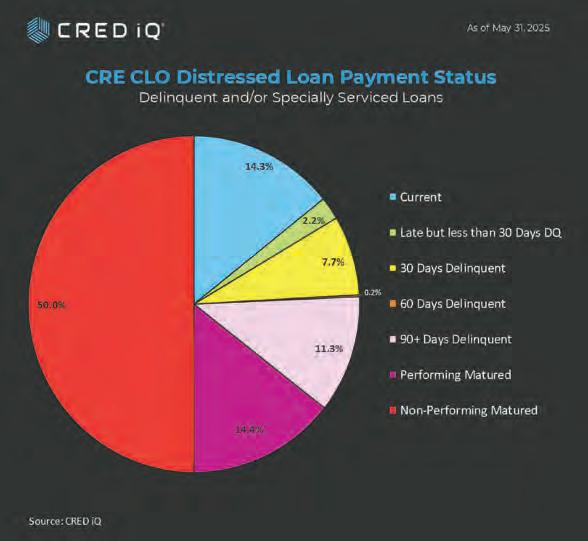

2025 EVENTS

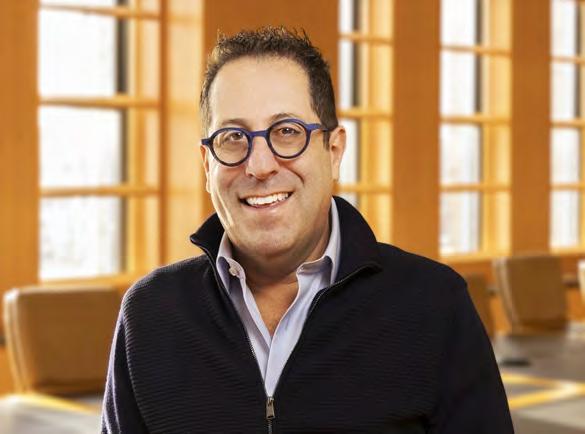


t’s a big roster, but each of these young pros have come to play.
For instance, consider L&L’s Giannina Brancato, who, at 29, has been doing leasing for 425 Park Avenue, one of the hottest (and most highly priced) office properties in all of Manhattan.
Then there’s Marc D. Smouha, who founded his own firm earlier this year and has already personally completed $165 million in industrial transaction volume. (Did we mention that Smouha is all of 22 years old?)
Tom Bentsen is hardly long in the tooth at 29, yet he’s currently directing the engineering work on one of the most anticipated adaptive reuse projects in New York City: SL Green’s One Madison Avenue.
Then there’s Erkan Kilic, 30, a principal at Blackstone, whose signature can be found on the, well, Signature deal that dominated headlines in December 2023 — the $17 billion loan portfolio that Blackstone, CPPIB, Rialto and the FDIC picked up from the failed bank of the same name.
Oh, and don’t forget Amir Abdu, 34, who is leading BGO’s Core Plus Fund, which in addition to being BGO’s top-performing multifamily asset class also saw a 50 percent uptick in its rental income in three short years.
One can feel the excitement of a scout on a trip to a Davidson College basketball game, and encountering Stephen Curry effortlessly hitting three-pointers from well beyond the arc.
Commercial Observer looks for Young Professionals who are smart, patient, quick to learn — and who want the ball right now, and know what to do with it. While we received a record number of submissions this year (hurrah!) we were disappointed when we received only four submissions for women (out of 80) in the finance category. We hope to see far more in 2026.
But that doesn’t change the fact that our class of 2025 — made up of people who were dropped into real estate’s existential crisis of COVID when some of them were still in school — had little choice but to play hard, right from the start.
Sit back. Enjoy. Because these brokers, architects, lenders, designers and engineers have got game. —M.G.
By Tom Acitelli, Isabelle Durso, Max Gross, Larry Getlen, Mark Hallum, Aaron Short, Patrick Sisson, Nicholas Trombola and Celia Young | Photograph by Chris Sorensen
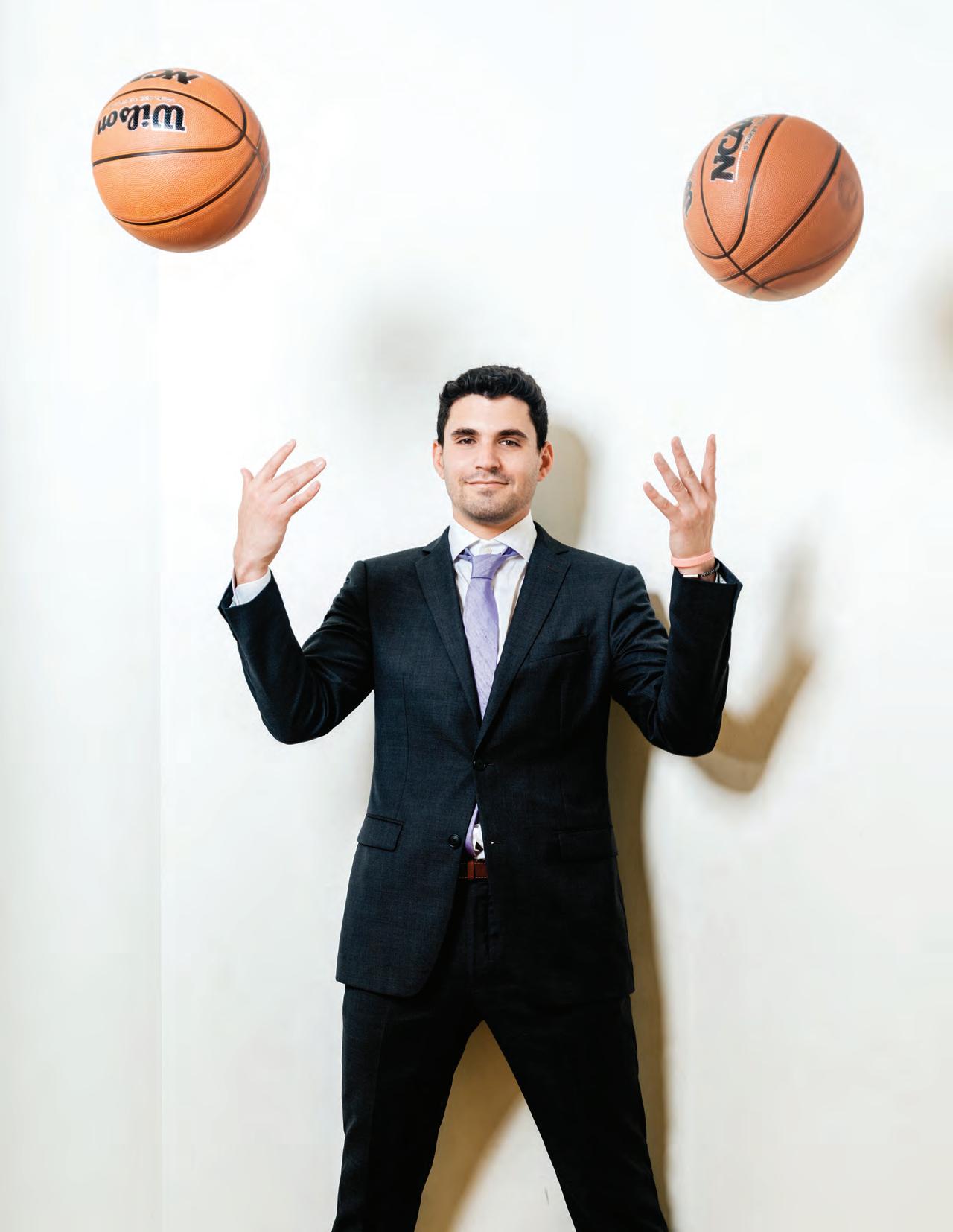
Ryan Candel.
Keaton Baum, 29
Associate in acquisition and asset management at Time Equities
Growing up in Pittsburgh, Keaton Baum saw firsthand the way real estate can combine theoretical and practical business realities. While interning with a friend’s father at a development firm, he observed the way business plans became tangible when he toured tenant spaces, got out in the field, and saw how market predictions met market realities.
Years later, after graduating from New York University and working at Time Equities, he’s replicating that experience as part of a team that buys and manages assets across the globe. His team sources and underwrites new acquisition opportunities, crafts detailed business plans, and conducts market- and property-level due diligence — and then oversees management and operations. Since joining Time Equities seven years ago, he’s been involved in $1 billion in acquisitions.
From his first big deal in 2022, repositioning a nearly 270,000-square-foot office building in Phoenix next to the Paradise Valley Mall after buying it for $43 million, to recent work on a $40 million multifamily deal in Ohio, Baum has become familiar with redeveloping and reimagining office space, cementing partnerships across the firm’s wide portfolio. A deal for a 40,000-squarefoot apartment in Seattle’s North Lake Union area, for instance, positioned the firm to benefit from the city’s continued tech industry expansion.
He’s currently working on overseas projects in Scotland, after closing a series of deals for Time Equities in the Netherlands as part of a 35-plus property portfolio worth 100 million euros.
“I’ve gotten that analytical knowledge over the last six years working here, and the ability to fly across the country — or fly to Europe — and sit and have meetings with people who have been in the business for 30 years and feel super comfortable,” Baum said, “I think that’s a strength that I have.” —P.S.
Benjamin Bouganim, 27
Senior associate at Cushman & Wakefield
Growing up in Sunny Island Beach, Fla., just north of Miami, Benjamin Bouganim found himself drawn to real estate, interning and working for both residential and commercial shops during his time at the University of Florida. But the pull of Manhattan was undeniable. When rumors of a gig in New York reached him in 2019, he coldcalled brokers at Cushman & Wakefield, sold himself, and has been working up North ever since.
Focused on office leasing, Bouganim was drawn to the analytical side of the work. There’s emotion in commercial leasing, like in any area of real estate — but, for him, it comes down to advising clients and thinking five or six steps ahead to fashion a long-term strategy.
He’s recently signed a number of deals in the Financial District and for law firms and coworking companies. That includes working with colleagues to close a number of deals for flex provider Industrious, landing them new boutique space post-CBRE acquisition, including 20,000 square feet at 560 Lexington Avenue in March, 27,630 square feet at 860 Broadway in April, and a 24,000-square-foot deal at Trinity Church in May,
Bouganim has taken to negotiating like some of the lawyers he’s found offices for. He said during one negotiation for the firm Cole Schotz, which led to a 32,128-squarefoot lease at 1325 Sixth Avenue, he played hardball to
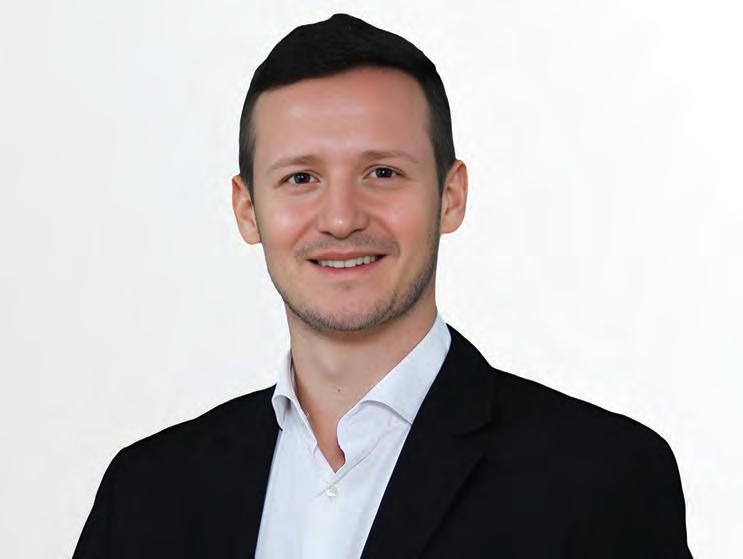

convince the landlord to come to the table and make a deal — one that eventually included concessions and tenant improvement packages.
While Bouganim has started to advance in his career, he remembers starting out in June of 2020, when he was traversing the eerie, empty, pandemic-cleared streets. He feels like he’s still in the trenches today.
“Even as I progress, I relate to the guys starting out who are bright-eyed and bushy-tailed, and eager and excited,” he said. “And I think that’s a beautiful thing.” —P.S.
Giannina Brancato, 29
Assistant vice president of leasing at L&L Holding
Growing up as an architect’s daughter, Giannina Brancato was fascinated with real estate from a young age. Brancato attended the University of Maryland for a business degree, but ultimately returned to her home turf in New York City to chase her real estate dreams. She landed a rotational internship with SL Green Realty in 2016.
After doing a surprise “Shark Tank”-style pitch at the
Benjamin Bouganim.
Keaton Baum.

end of the internship and being the only intern chosen for a full-time job, Brancato started at SL Green in 2018, working on the operations side for office buildings that included 11 Madison Avenue and One Vanderbilt.
“The experience gave me a deep understanding of how buildings actually function, not just from the top floor, but from the boiler room up,” Brancato said. “I saw firsthand what it takes to deliver a best-in-class experience to tenants, which gave me a unique lens on what drives retention value and long-term performance.”
In 2021, Brancato started at L&L Holding as an assistant property manager and began her current position of assistant vice president of leasing in March 2024. In this role, she handles lease negotiations and develops marketing strategies for L&L’s 5 million-square-foot New York City portfolio.
At L&L’s 425 Park Avenue, Brancato helped complete the leasing, and leased the remaining retail portion to Ferrari, which took 7,629 square feet in April. But her biggest deal to date was at L&L’s 114 Fifth Avenue, where Brancato and her team negotiated a lease with Capital One in February to expand its footprint at the building by 96,606 square feet.
As for her most complex deal so far, Brancato helped to secure a multiparty lease restructuring at 195 Broadway, transitioning out a legacy tenant while simultaneously securing a 41,854-square-foot deal with new tenant Orchestra.
And after finishing a master’s degree in real estate development at New York University this year, Brancato is ready for plenty more complex deals.
“I want to continue to do deals with new developments and stay curious, stay driven, and help shape a more resilient, beautiful New York,” Brancato said. —I.D.
Sofia Bruno, 26
Vice president at JLL
Some people might say that beginning one’s career in the midst of a society-altering pandemic is unfortunate
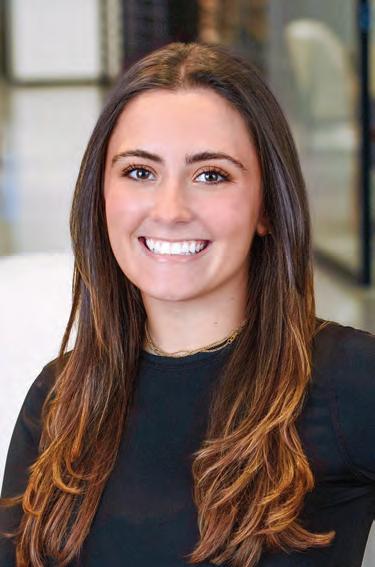
timing. But Sofia Bruno found opportunity. Bruno joined JLL’s New York leasing division after graduating from the University of Georgia in 2021. COVID had injected so much disruption into the commercial real estate industry by that point — the meteoric rise of remote work, for starters — the viability of a career in the space wasn’t necessarily a given.
“When I was first looking into getting into it, I had a lot of people say, ‘You’re kind of nuts,’ ” Bruno said. “Like, ‘Are you sure that that’s really what you want to do?’ ”
Yet Bruno quickly realized, with the help of her mentors, that she was entering an industry that was reorienting itself in the wake of massive societal change. An exciting dynamic formed between her and those mentors, Bruno said, because they would sometimes need to find fresh solutions to certain challenges together in real time.
“Most of it was a typical mentorship relationship, but there was maybe 10 to 15 percent of the time where it was like, ‘All right, we’re in COVID — what are our clients interested in hearing? What can we tell them? How do we find solutions?’ ” she said.
“So that allowed me to be a part of that thought process. … You’re picking up on all of their habits and what they’re teaching you. But, at the same time, really kind of allowing you to think for yourself in a scheme where they’re not so comfortable either.”
Highlights from Bruno’s career thus far — which have helped earn her recognition as a JLL Brokerage Top Achiever in 2022 and 2023, and as a Gold Achiever in 2024 — demonstrate that dynamism.
In early 2024, Bruno’s team represented State Street Bank’s relocation to 30,000 square feet at BXP’s Citigroup Center tower in Midtown, in a move that coincided with the bank’s brand relaunch and to “meet the post-pandemic needs of its workforce,” per JLL. A few months later, Bruno’s team reconfigured a roughly 42,400-square-foot lease for Faegre Drinker Biddle & Reath at Silverstein’s 1177 Avenue of the Americas, to provide the law firm a more collaborative space. —N.T.

Nora Caliban, 27 Commercial leasing associate at Durst Organization
Nora Caliban is right at home with the Durst Organization, where she handles leasing for the firm’s office and retail portfolio on Manhattan’s West Side.
The native New Yorker began her career at Durst as an intern, leasing apartments and then going to work for Tishman Speyer for three years before Durst called her back to help lease up its Class A office buildings on Sixth Avenue such as 1155 Avenue of the Americas.
But getting into real estate when she did was hardly an easy path — though it tempered her in a unique way.
“Leasing apartments was scary at the peak of the pandemic. And then coming to Durst and seeing real estate shift in all these different directions, it’s been really interesting,” Caliban said. “I feel lucky to be able to experience all these different sides of it at a young age.”
One of the deals that stands out over the last two and a half years at Durst was insurance firm Everest taking 66,444 square feet across the seventh through ninth floors of 1155 Avenue of the Americas in April 2024.
“Being the youngest person on the team and being trusted with the leasing efforts at 1155 was really exciting,” Caliban said. “That deal started the momentum for us, and now 1155 is almost 94 percent leased.”
Another memorable deal for Caliban involved the company responsible for the concept of sushi restaurant Momoya, which signed a 5,000-square-foot lease at the ground level of One Bryant Park in February for an as-yet unnamed venture.
“I remember when the Momoya team came through to look at [the space],” Caliban said. “We were like, ‘This is totally the right fit, these are the right operators, they have vision.’ ”
Caliban isn’t the first in her family to work at Durst, nor is she the first on Commercial Observer’s Young Professionals list: Her older brother Bailey, who made the list in 2023, handles leasing for the company’s portfolio on the East Side. —M.H.
Sofia Bruno.
Nora Caliban.
Giannina Brancato.
Ryan Candel, 26
Senior vice president at BKREA
Ask Ryan Candel about an aspect of the New York commercial real estate market, and get ready for some numbers.
Candel has a senior role in land development deals at BKREA, the firm that veteran investment sales broker Bob Knakal started in early 2024. Knakal and company are known within the industry for decades’ worth of deep stats on the New York market.
“It’s data that I’m able to share with my sellers — because that’s, at the end of the day, who I want to speak with on a daily basis — but also speaking to developers and getting them comfortable with certain sites based on data,” Candel said. “It just helps us to our advantage.”
A multisport athlete in high school who played lacrosse for a time in college, Candel originally envisioned himself as a sports agent in the mold of the fictional Ari Gold. The Upper East Side native who grew up in Nassau County found himself making deep inroads into commercial real estate after graduating the University of Wisconsin at Madison (and after a brief detour working in e-commerce). Part of that was having family in the business, and the other part was from conscious networking, including via a sports training business he started in the Hamptons during the COVID lockdowns.
Through that networking, Candel landed an informational meet-and-greet with Knakal and then-business partner Jonathan Hageman while they were at JLL. That led to a job there. Candel then followed Knakal to BKREA in spring 2024, after what he described as an impactful experience at the brokerage. That included helping broker the $87.4 million sale of 540 West 21st Street in April 2024 for a high-end condo.
“I decided it was an opportunity I couldn’t pass up on, and it really has been an awesome experience thus far,” Candel said of the move.
In addition to parsing which land development deals work for BKREA at large, Candel works on his own trades. The most prominent recent one involves an assemblage in Manhattan’s coveted NoMad enclave that provides 157,000 buildable square feet to a buyer. It’s coming to market this summer. —T.A.
William Demuth, 25
Assistant director in integrated consulting strategies at Savills
William Demuth was the sole analyst on one of the largest office lease transactions in New York City in 2024, the relocation of American Eagle Outfitters’ 338,085-squarefoot headquarters.
“We advised American Eagle on consolidating all of their different brands in New York and putting them under one roof,” said Demuth, a graduate of Franklin & Marshall College who is currently the youngest member of Savills’ Integrated Consulting Strategies Group.
“All these different brands were spread across multiple buildings, and they had been in their previous headquarters for over 20 years,” he said. “We led them through a strategic relocation process to 63 Madison Avenue. It was the biggest office deal in New York year-to-date at the time.”
Demuth studied business in college but also honed an appreciation for fine art, ultimately marrying the two through the pursuit of architecture. He quickly came to embrace the more financial and analytical aspects of his studies, leading to a shift toward brokerage consulting.
Two key internships helped him along that path. Demuth worked on office leasing at Cushman &
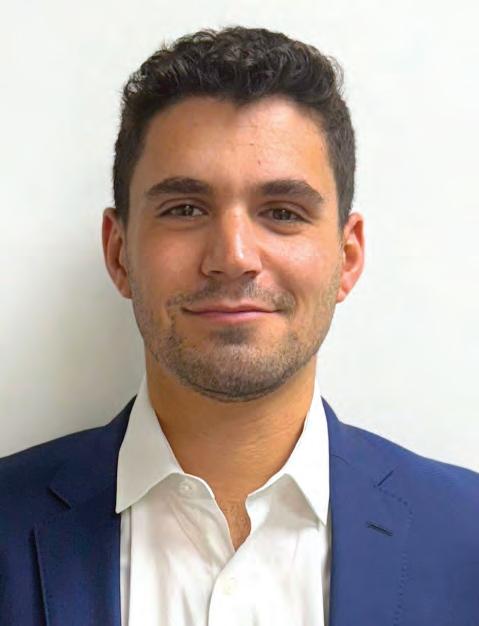
Wakefield in 2020, and then spent time as a summer analyst at Beatty Development Group in Baltimore in 2021. At Beatty, he played a key role in supporting the underwriting for a 27-acre, mixed-use development in Baltimore’s Harbor Point neighborhood, and created a comprehensive pro forma for a proposed multifamily development which he then, as an intern, pitched to potential investors.
When asked about his ambition for the future with Savills, Demuth said he anticipates working on more impactful projects, particularly in New York.
“I’d like to continue working in our integrated consulting strategies practice, hopefully as a partner,” said Demuth, “and continue to help this city thrive and maintain its identity as the greatest city on earth — not only for professionals, but for people to work, play and live in.”
L.G.
Edward DeSimone, 28
Vice president and associate director at Matthews Real Estate Investment Services
Edward DeSimone scored the perfect Wall Street finance job after graduating from the University of Colorado at Boulder in 2019, but he soon switched gears to real estate to chase a more personal connection to his work.
Now, he’s working to expand Matthews Real Estate Investment Services’ presence in the Northeast.
The New Jersey native started working at the Nashvillebased investment firm’s Los Angeles office in 2019, but when Matthews opened its first New York office at 575 Fifth Avenue in May 2023, he returned to his old home. And, while DeSimone specializes in retail investment advisory nationally in his current role at Matthews, he’s focused specifically on expanding retail in the Northeast — and he’s doing it one deal at a time.
“I primarily focus on single-tenant lease sales around the U.S., but I’m back out here trying to focus more on Northeast retail as a whole, including shopping centers and multi-tenant strips,” DeSimone said. “I’m not someone that hits home runs or even triples. I hit a lot of singles and doubles. I do a lot of deals a year.”
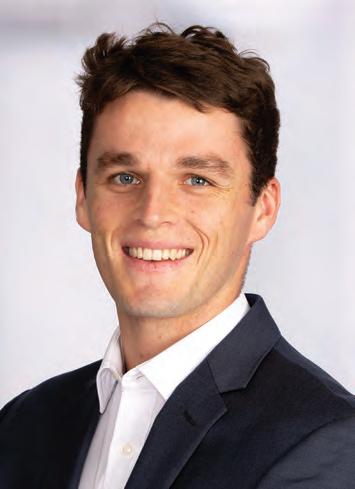

Over the course of his career, DeSimone has closed on more than 145 individual properties. The list includes the nearly $5 million sale of an Applebee’s restaurant in Orlando, Fla.; the sale of seven vacant dollar stores across the U.S.; and the $37.1 million portfolio sale of 14 Jiffy Lube properties spread across the nation.
Moving forward, DeSimone emphasizes his focus on the Northeast as Matthews expands into markets such as New York City, Boston and Philadelphia, while still keeping its Southern and Western roots.
“I think there’s a massive opportunity for us to gain more market share in the Northeast market, across all retail products,” DeSimone said. “So, within the next five years, I’m hoping to really ramp that up and become a much more dominant player up here.” —I.D.
William Demuth.
Edward DeSimone.
Ryan Candel.

Ana Erickson, 24 Associate at Savills
Unlike many of her peers, Ana Erickson has no family background in real estate. Her path into the industry evolved not from familial ties, but from a love of eyelash extensions.
“I’ve always loved lash extensions, so I started my own lash extension business,” said Erickson, who graduated from Barnard College with a bachelor’s degree in political science. “I loved taking that love and sharing it with the world, and building relationships with my clients.”
Erickson decided to blend her interest in developing deeper client relationships with her interest in New York City. She joined Savills in September 2022, after being chosen for the firm’s Junior Broker Development Program.
Erickson works on the brokerage team of Savills TriState Brokerage CEO Mitti Liebersohn, which has been an all- encompassing learning experience.
“A lot of my position is working on transactions for our various office clients,” said Erickson. “My position is unique in that Mitti is also in leadership, so I get a taste for his different responsibilities when it comes to supporting Savills Tri-State and creating a lot of great culture here in New York.”
Erickson worked on the March 2025 lease renewal for Santander Bank’s 192,000-square-foot U.S. headquarters at 437 Madison Avenue, and also on the April 2024 American Eagle Outfitters’ relocation to 338,085 square feet of space at 63 Madison Avenue.
This is the kind of work she hopes to continue on a deeper level moving forward.
“I will always think of the American Eagle transaction as the deal that launched my career, because it was the first deal I really saw from ‘I’m pitching this client’ to ‘The deal has closed,’ ” said Erickson. “It was a very complicated deal during COVID, and dealt with different kinds of financing. But what made it special was seeing over the two-year period it took to do the deal how close you got with those clients. Those are people I still interact with.” — L.G.

Matthew Fogel, 28 Director at KSR
Despite the shadow of the pandemic, Matthew Fogel hit the gas on his career during his senior year at the University of South Carolina and earned his real estate license so he could jump into the market right away.
Taking that early interest in the then up-and-coming KSR would serve him well. It put him in touch with brands making a big splash in the New York City retail market, such as Unapologetic Foods, Crumbl Cookies and Pura Vida.
“It’s been a tremendous six years now for me,” Fogel said. “I went to KSR right after college, and I’ve had the opportunity to grow with the company alongside it. I started six months before the pandemic, and I navigated my way through it, and I saw the retail landscape change. A lot of headlines had gloom written all over them, but things are just changing, and that’s the way business works. Everyone has to adapt.”
Fogel helped Unapologetic Foods, the famed Indian food brand, secure a 3,600-square-foot lease at 107 First Avenue in July 2024, where it would channel the success of its other New York City restaurants such as Dhamaka and the Michelin-starred Semma (which was named the No. 1 restaurant in Gotham recently by The New York Times).
Another brand Fogel helped in its expansion on a nonexclusive basis is Playa Bowls, which greatly expanded its store count as retail made a comeback from the pandemic.
Originally pursuing a psychology degree to enter the same field as his father, Fogel instead chose real estate after deciding that there’s more than one way to help people — namely through philanthropy and sharing business knowledge with the less fortunate. “I figured I could do a lot greater things in the world from a charitable philanthropy aspect,” Fogel said.
Most recently, Fogel worked with a charter school program in the Bronx giving students the opportunity to learn how the commercial real estate industry works and what kind of options they have for career opportunities. —M.H.
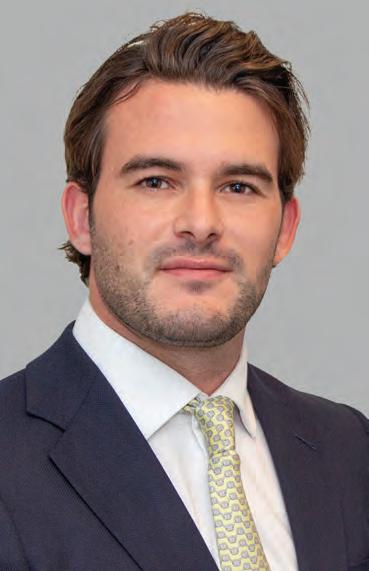
Sam Hoffman, 28 Director at Cushman & Wakefield
The pandemic taught important lessons to many up-and-coming brokers. In the case of Sam Hoffman, who became a director at Cushman & Wakefield last year, he used the downtime to methodically study New York’s commercial real estate market: who owns what, the advantages of niche submarkets, and how large firms built their portfolios.
Hoffman has always been attracted to the personalities and business plans — he was intrigued seeing nascent tech startups pitch their plans during his C&W internships in 2019 and 2018 while attending Trinity College — and he feels it’s translated to having a better handle on business development and valuing assets as he’s become more experienced with office leasing.
“New York specifically has such a deep talent pool,” said Hoffman. “From a relationship standpoint, I’ve seen certain senior brokers stand out, and have really tried to emulate their approach to winning business, and that’s what really gets me going.”
After hitting the ground running after graduating in 2019, Hoffman has risen through the ranks to become an office leader and an international broker, with about 15 percent of his work taking place in European markets.
Currently, his role is strictly business development and client retention, so in the last 18 months he’s been more involved with getting deals over the finish line. These included a deal last year at 1410 Broadway for tech firm Grata’s new office, or the renewal of the Writers Guild of America East headquarters lease at 250 Hudson Street.
At the end of last year, Hoffman helped close a deal for 40,000 square feet across two buildings in London’s prestigious St. James Square for global hedge fund Point72.
“Because of the demand, there just wasn’t much wiggle room on the lease, and it was tough to keep competitors away,” he said, “because it was such a highly sought-after tenant.” —P.S.
Ana Erickson.
Matthew Fogel.
Sam Hoffman.
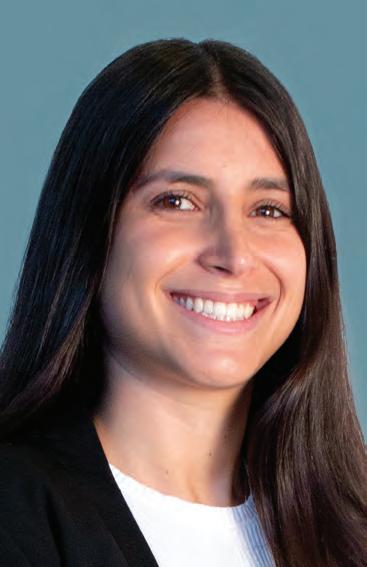
Courtney Hughson, 28 Vice president at CBRE
Courtney Hughson caught the real estate bug after attending college in the South.
She grew up in Westchester County with her father and older sister, who both worked in real estate finance. Hughson chose Vanderbilt University because she was drawn to Nashville’s food and country music scenes and its balmy weather, but her family led her to major in economics.
“I knew I wanted to go down the finance path,” she said. “My dad has been in real estate for my whole life, and I was exposed to real estate at a young age.”
Hughson got an internship in college at Wells Fargo’s large loans group, where she learned about real estate lending, market research, and how deals were structured. Her first job after graduating in 2019 was with CBRE’s consulting group on the tenant rep side, where she modeled and analyzed different transaction structures to help her clients. Six months later, she was working from home after New York City shut down.
“It was definitely a transition, especially being new to the job and having to learn everything remotely,” she said. “There was a big lull in activity, so we were doing what we could to stay relevant with our clients by providing market updates.”
Hughson has since worked with auction house Christie’s, which contemplated relocating its New York office but chose to renew its 373,000-square-foot lease at 20 Rockefeller Center for 20 years. “They wanted to relocate to make a splash, but upon further due diligence and diving deeper we decided a renewal would be the best way forward,” she said. “Given how their operations worked, we weren’t able to find a solution that made financial sense for them.”
Hughson now lives in Williamsburg, where she enjoys hot yoga classes, baking and doing puzzles, which she picked up during the pandemic. Her current neighborhood has some of the best views of the city’s skyline.
“I live not too far from Domino Park and I walk there often,” she said. “The amount of people out here on any given day is surprising. It’s a whole new neighborhood.” —A. Short

Eddie Keda, 25
Managing director at Tri State Commercial Real Estate
Growing up around his father’s shoe stores in Brooklyn, Eddie Keda was exposed to an unrelenting work ethic at a young age — never mind in a business that hinged on moving merchandise.
“There was no such thing as days off,” Keda said. “I was brought up with the mindset of ‘Do it all yourself, get out in the field, don’t slack.’ ”
When Avi Akiva, a partner at Tri State Commercial Real Estate, approached an 18-year-old Keda with an offer to mentor him through the process of entering the world of CRE, the younger man was hesitant.
But that was in 2018, and he’s still in commercial leasing in Brooklyn.
Some of the more notable deals Keda has worked on include K9 Resorts Luxury Pet Hotel, which took a 16,187-square-foot lease at Eliezer Breco’s 295 Front Street in May 2024, as well as a 26,000-square-foot deal with Ember Charter School and a 12,000-square-foot deal with Tarlow Events in the same building.
Ember Charter School was facing a deadline, “so from the time that they saw the space they had around four weeks to sign a lease before the next school,” Keda said. “Anybody in commercial real estate will tell you it’s impossible. You can’t get approvals for a charter school on the upper floor in a four-week span. … Just to get the deal done, we had to get super creative.”
In reality, that deal should have taken about six to eight months to gel, according to Keda.
Keda also worked on a deal on the landlord side that involved famed chef Enrique Olvera when he was establishing a new location for Tacos Atla in Williamsburg, Brooklyn, one of the city’s trendiest neighborhoods. Olvera signed for 2,800 square feet at 142 North Fifth Street in June 2023. —M.H.
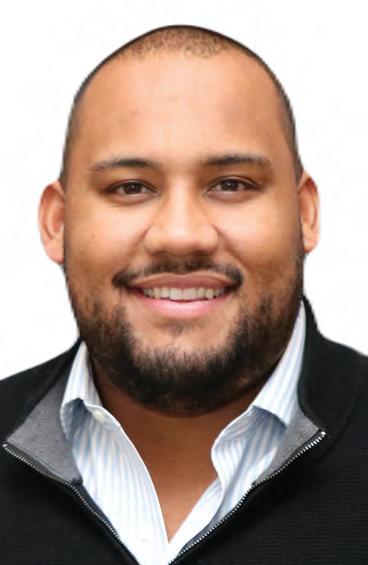
Leo Koné, 28
Associate director at Newmark
Leo Koné has always been head and shoulders above the competition. The Washington Heights native loved baseball but utterly dominated opponents’ offensive lines while at Dalton, becoming one of the rare prep school athletes to play for a Division 1 football team.
“If you look up my highlights, I’m 6-foot-4 and 300 pounds playing against the Upper East Side guys who I work with now at Newmark,” he said. “They’re my best friends now.”
At Wake Forest, the defensive tackle played with future Atlanta Falcons safety Jessie Bates III and roomed with future Jacksonville Jaguars backup quarterback John Wolford. Alas, the NFL wasn’t in the cards. A football injury in college prompted Koné to consider alternatives for his future, and he zeroed in on real estate.
“All of the parents at Dalton were in real estate, and I always loved architecture,” he said.
Koné got an internship at RAL Development while in school and joined Lee & Associates after college. He moved back home when the pandemic happened and was contemplating grad school until a family friend suggested he meet Newmark executive David Falk for a change of scenery. Now Koné works with 10 people, and appreciates the camaraderie of being on a big team again.
“COVID happened and that was a big knockdown, but you have to brush yourself off, line up again, and try to go sack the quarterback,” he said. “The lows are low, the highs are high, but you have to stay even-keeled.”
Over the past year, Koné’s team worked with the Olnick Organization to lease 120,000 square feet at 130 Fifth Avenue in the Flatiron District. This spring, Koné also repped Radar Labs, which moved into 20,000 square feet at 111 Fifth Avenue, the biggest tenant rep deal of his career.
Koné doesn’t tackle anyone anymore. Instead, he attends as many Yankees games as he can and plays softball on a team that just won its league championship. “It was a 10-0 blowout, and I actually pulled my hamstring,” he said. “I hit a home run and pulled it running around the bases.” —A. Short
Courtney Hughson.
Leo Koné
Eddie Keda.


Nick Martin, 26
Director of real estate at Friend of Chef
An upbringing in the restaurant industry preheated Nick Martin for his current role as the real estate director for Friend of Chef, an outfit that offers brokerage services as part of its larger restaurant advisory practice.
The Rhode Island-born Martin was brought up by chefs and eventually ended up studying business at the University of Colorado at Boulder before heading to New York City, where he initially worked for the New
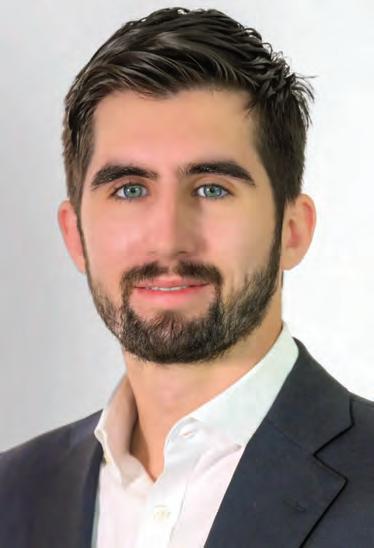
York Yankees before going into residential brokerage at Platinum Properties.
“I think what I’ve found over the last two years of working at Friend of Chef is that I love the people I work with,” Martin said. “Not only my co-workers but all the chefs, hospitality group owners, restaurateurs — the people I’ve been around my entire life. It’s just a very easy connection for me to be on the same level as these people. I’ve done almost anything you can at a restaurant, so I think that sets me up for what we do at Friend of Chef.”
One deal Martin has worked on that forced some creativity was arranging a deal for Las Vegas staple the Golden Steer Steakhouse, which was looking to expand away from its well-known spot on Sahara Avenue just north of the Strip.
The proprietors for the eatery wanted to establish its second location in New York City, eventually settling on 6,000 square feet at 1 Fifth Avenue, also known as One Fifth.
“There are so many ways that things can go wrong in these restaurant deals, whether it’s venting or gas or a specific pipe,” Martin added. “There’s always something that will come up, and it showed me how to actually get a deal done from A to Z.”
Martin views what he does at Friend of Chef as a departure from traditional brokering in that his colleagues aren’t real estate professionals, but rather people who have run their own restaurants, meaning Martin has the opportunity to get the most out of the food and beverage experience. —M.H.
Dorel Melloul, 26
Senior director at KSR
Dorel Melloul has logged some serious hours for one his age. He went to work for brokerage KSR when he was 18, and so now has eight years under his belt already.
The married father of two didn’t waste time. He interned in high school for a couple of summers with Rosewood Realty Group, spending a year abroad, and then
hit the pavement with KSR where one of his accounts is SL Green Realty’s Midtown East portfolio.
“I do like working with retail brands, so I don’t think I would ever work in another field in real estate,” Melloul said. “I love working with retailers and spaces, seeing the synergies between tenants. That’s something that I am very interested in.”
In February, Melloul represented owner Bldg in a deal at 424 Madison Avenue that would establish Bagizza, an eatery that blends bagels and pizza. He also repped SL Green and Star a Kidz Playhouse for 4,722 square feet at 220 East 42nd Street, and negotiated a 4,500-squarefoot lease for Moka & Company at 246 Franklin Street In Greenpoint.
One of Melloul’s favorite deals was for Italian fashion brand Kiton in 2021 at 692 Madison Avenue, where it signed for 3,400 square feet.
“I was touring brands through the space in an N95 mask during the heart of COVID,” Melloul said. “Fast forward a little bit, Kiton came and saw the opportunity to get in early. That block now trades for about $1,000 per square foot, with rare availability, and has undergone a true retail renaissance.”
Some larger lease signings Melloul has worked on include Iyad Hamsho’s lease for 5,000 square feet at 133 Mulberry Street for a restaurant concept known as Osteria Barocca back in February 2023, as well as the more recent deal for Slate Property Group at 610 Columbus Avenue, where he helped secure tenants such as Pilates studio SLT and medical practice Tribeca Pediatrics. —M.H.
Patrick O’Rourke, 29
Senior director of retail services at Cushman & Wakefield
A retail leasing specialist who works for both tenants and landlords, Patrick O’Rourke has racked up an impressive resume of new clients — and new businesses — while seeing retail flourish post-pandemic. It’s been an impressive run for someone who started soon after graduating in December 2018 — he was on the Babson College soccer team that made the NCAA playoffs twice — but had been to New York City only once before.
For years, he’s been part of a Cushman & Wakefield team representing Blank Street Coffee, helping Gen Z’s favorite coffee chain blanket the city as it aggressively expands to take on more established rivals, including a lease last year at One Boerum Hill for the chain’s new Brooklyn flagship.
Last year, O’Rourke also worked on a deal to bring Lidl, the German low-cost grocery chain that also owns the Aldi brand, to Manhattan. The chain struck a 15-year lease for 23,000 square feet at 225 Eighth Avenue with developer MAG Partners to help fulfill a requirement for the development to find an affordable grocer. That meant O’Rourke helped usher in a European brand to the city that now has extensive expansion plans across the five boroughs.
“There were really a lot of intricacies that, collectively as a team, we were able to navigate,” O’Rourke said about the deal, which saw him help land the grocer on behalf of his client, M. “This was a tenant that hadn’t really been in New York, and we were selling a building that hadn’t been built. That takes a unique skill set to pull something like that off.”
He also works on behalf of landlords such as Related Companies, the Olnick Organization, Mount Sinai, MetLife Investment Management and Clarion Partners.
“Each day in retail is different,” he said. “You might be out on the street for four hours, or you’re picking up on new trends that somebody who wasn’t here in the city wouldn’t know about.” —P.S.
Nick Martin.
Dorel Melloul.
Patrick O’Rourke.
Trystan Polsinelli, 29
Senior executive director of commercial at Compass
Trystan Polsinelli is no stranger to the real estate world — he was born into it.
Coming from a real estate family, Polsinelli spent his summers at the University of Tampa interning at Marcus & Millichap and Eastern Consolidated, learning the lay of the land.
After graduating in 2018, Polsinelli joined Compass and had an integral part in launching the brokerage’s commercial division, where he completed $80 million in sales across asset classes in New York City. In 2019, he took his talents to 60 Guilders, where he served as vice president of leasing and sales for five years and managed a portfolio of about 22 properties with a combined value of $2.5 billion across office and retail in Manhattan, Brooklyn and Queens.
Polsinelli returned to Compass last summer as senior executive director, in which he is responsible for the firm’s investment sales, leasing and advisory services in New York City.
“The experience of being involved in the entire life cycle of a deal is crucial, and it certainly separates me from every other broker because I have that perspective from all sides of the table,” Polsinelli said.
Polsinelli also came back to Compass with some major deals under his belt, including selling 120,000 square feet of office condominiums at Midtown’s 345 East 37th Street and 18-20 West 33rd Street. At 20 West 33rd Street specifically, Polsinelli executed the $25 million sale of two office condos to two different buyers, a deal he said was completed in just 14 days.
As for retail, Polsinelli recently completed the $16.5 million sale of a 16,000-square-foot retail condo at 350 Avenue of the Americas to a New York Universityaffiliated community center and preschool operator.
And, while he can dominate office and retail deals, Polsinelli said his real forte is multifamily, as he’s onboarded about 300 multifamily units across the city in his decade in real estate. “I’ve spent long nights putting leases together by hand for all different types of assets, but I think, out of everything, multifamily is going to be the first that comes to mind,” he said.
Over the next five years, Polsinelli said he wants to continue to increase his deal volume and transact across all asset classes. —I.D.
Kate
Roush,
27
Vice president at JLL
Prior to her roles at JLL, Kate Roush thought she would end up in the entertainment world.
Throughout her college days, the Southern California native interned with the likes of Mosaic Media Group, KABC (Los Angeles’ ABC affiliate) and “Good Morning America,” wearing myriad sales, production and managerial hats. After graduating from the University of Michigan in 2019, Roush moved to New York and began working in ad sales for the Walt Disney Company.
Yet, Roush remembers wanting more agency in her own career — and few industries offer the level of selfdetermination as commercial real estate. Although she had little industry knowledge prior to joining JLL in 2021, Roush’s experience in building relationships and client management, along with great mentors at JLL, helped set her up for success, she said.
“When I started at JLL, I was able to take and transfer some of those skills,” Roush said. “One of the beauties of this industry is how people-oriented and relationship-driven it really is. It makes for a very dynamic work
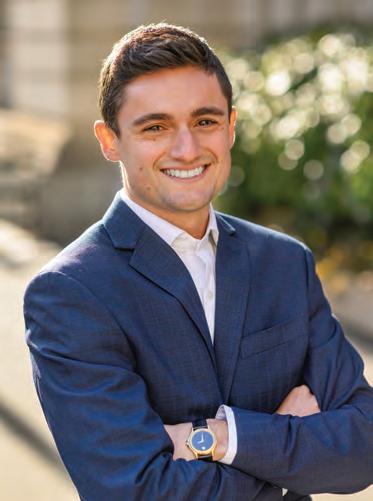

environment. And every day is a little bit different, which you can’t really find in a lot of other industries.”
That right mix of people skills and professional guidance has clearly served her well. Roush now serves as a vice president in JLL’s New York brokerage services group after just four years at the company.
Even within the past six months, Roush has helped represent both tenants and landlords in several nine-figure lease deals across Manhattan. That includes repping Traveler’s Insurance in its 123,000-square-foot renewal at SL Green’s 485 Lexington Avenue at the end of last year. Roush is also part of the team that exclusively handles leasing for Property & Building Corporation’s 30-story 10 Bryant Park, where the team recently snagged a 330,000-square-foot lease from none other than Amazon. —N.T.
Carly Shoulberg, 26
Vice president at Eastdil Secured
In early 2024, the real estate community was a-twitter: Jeff Sutton had sold not one but two properties a stone’s throw from each other on Fifth Avenue for a combined $1.8 billion in a single whirlwind month.
Not bad deals for Carly Shoulberg to have her name attached to.
It “caught the market by such a surprise,” Shoulberg said. “$1.8 billion — there hadn’t been any retail deals in New York in some time” when those deals closed.
Shoulberg works with two of the top names in commercial real estate: Eastdil’s Will Silverman and Gary Phillips. And, while the Fifth Avenue deals were blockbusters, the team has had so many other deals that one could hang a career on: an iStar net-lease portfolio for $3.1 billion; the sale of the Uniqlo retail space at 660 Fifth Avenue for $350 million; the sale of 799 Broadway for $255 million; and the sale of Frank Gehry’s towering 8 Spruce Street apartment building for $930 million.
“I still remember the day we closed on that — Dec. 31,” Shoulberg said of 8 Spruce. “What a fun way to start New Year’s.”
Since 2020, Shoulberg — whose responsibilities center
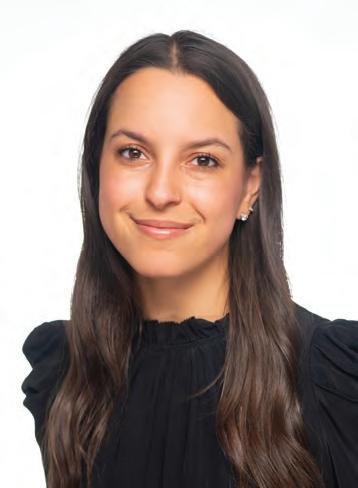
around building client relationships and transaction execution — has been involved in $12 billion in deals.
“I got interested in real estate in college,” Shoulberg said. She had originally started as a communications major at the University of Pennsylvania, but midway through got drawn into real estate and was recruited for Eastdil on campus. But it wasn’t so unexpected a turn: Her family owns real estate in Atlanta, and her mother is a retail leasing broker. (Speaking of Atlanta and its most prominent drink manufacturer, she named her micro-bernedoodle “Cola.”)
“I love doing it all,” Shoulberg said. “What I love about our team is no one is pigeonholed.” Whether it’s Frank Gehry’s architectural masterpiece by the Brooklyn Bridge, or the Fifth Avenue high street retail, Shoulberg has, indeed, done a heck of a lot more than your average 26-year-old. —M.G.
Trystan Polsinelli.
Kate Roush.
Carly Shoulberg.
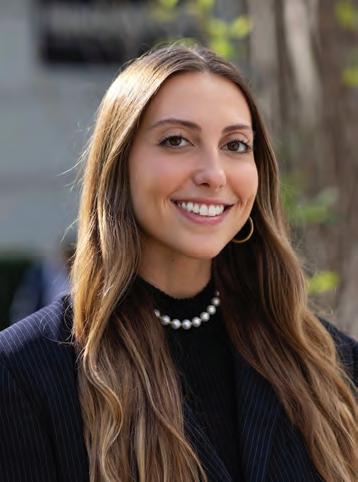
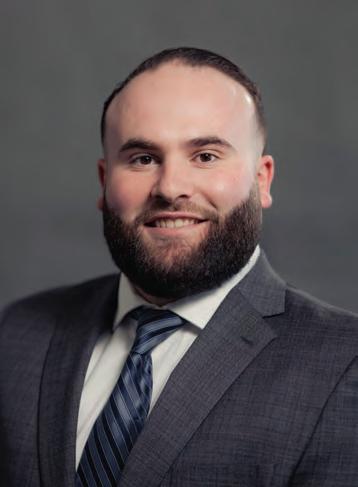
Morgan Singer, 27
Managing director at Ripco
Growing up in Melville on Long Island, Morgan Singer knew a few things. She wanted to work in New York City, but she didn’t want a 9-to-5 desk job. She also knew that becoming a retail specialist bringing fashion outlets and international brands to New York would help her shape the landscape of a city she loved. Her role at Ripco has helped her realize those ambitions.
Singer sees herself as someone with the pulse of the market and who’s worked with a broad array of retail clients, including tenants and owners ranging from local mom-and-pops to high-profile institutional owners.
Her first deal — signing a lease for an AT&T outlet on behalf of Empire State Realty Trust — led to her longest-running business relationship. But she’s also dealt with a variety of brands, both national and international. She has
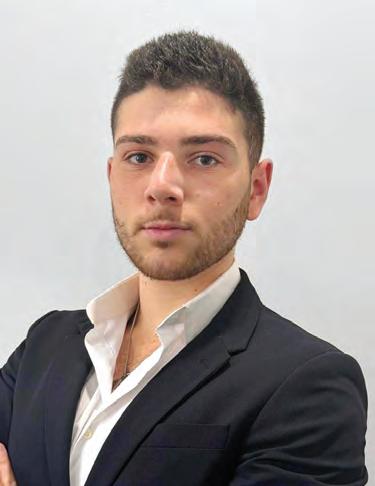
signed leases for Ralph Lauren, Mango and Sur La Table, and worked as a lead market strategist for Chinese fast-fashion brand Urban Revivo, helping it break into the country with its first U.S. store, a 30,000-square-foot location at 515 Broadway, before handling its national expansion.
“I find it very cool to work with brands that I love, and that I wear,” Singer said.
These experiences just earned her election as the chair of the Real Estate Board of New York’s Next Gen in Retail Committee.
Singer has also headed up Millennium Partners’ portfolio on the Upper West Side, helping lease more than 120,000 square feet. Deals include a 30,000-square-foot deal with NYU Langone, a 40,000-square-foot lease with the New York City School Construction Authority, and a deal with Mango in which she represented both tenant and landlord.
“I really think that I have a very creative perspective on things, and I’m able to move away from sort of the traditional real estate thinking,” she said, “and come up with some outside-of-the-box thoughts.” —P.S.
Marc D. Smouha, 22
Founder, CorePoint Real Estate
If you’re a normal go-getter — the kind of person who wakes up every morning with a spring in your step and a desire to conquer the day — there’s a good chance Marc Smouha will make you feel like a lazy bum.
Let’s start with his age and title: 22 years old and founder of his own company.
Take solace, you say to yourself. A company started by a 22-year-old can’t be that impressive.
Actually, that company, CorePoint Real Estate, is already a 10-person firm at five months old, and 22-year old Smouha already has $165 million in ransaction volume under his own belt. (Now ask yourself: WTF?!)
As for the Monmouth, N.J.-born founder, he personally closed over $100 million in the last 12 months, having carved a niche for himself in off-market transactions in industrial real estate in Florida, Georgia and Texas while he was at KSR.
“I thought to myself: Where are all the signs pointing?” Smouha told Commercial Observer when asked how
he found this specialized asset. “In retail, how often am I going to a store today versus 10 years ago? Everything is going online. The future really is in logistics.”
The biggest deal Smouha completed in the last year was for a 115,318-square-foot multi-tenant industrial warehouse in Medley, Fla., which he sold from the Gorey family to Longpoint Realty Partners for $27 million.
“That was really a story of persistence,” Smouha said. “I contacted the seller over a year or two ago. We went back and forth, and back and forth. They said, ‘Hey, Marc, we’re not interested [in selling] — we’d need a really crazy number.’ ” But when Smouha found a buyer looking for a multi-tenant industrial space, he called the Goreys and made the deal.
Smouha was still in high school when he began interning with KSR (he briefly attended Brooklyn College) and real estate was in the blood; one grandfather was a landlord, and another was a property manager of shopping centers.
As for starting a company from scratch? “It’s a lot of administrative things. You don’t realize how much there is to do on the back end. At the same time, it’s really enjoyable — I’m confident in the direction we’re going. We know what we’re building and building well. … We’re in it for the long run.”
Oh, yeah, did we mention that Smouha just became a dad? Just wait until this dude hits 23. —M.G.
Daniel Tack, 27
Salesperson at Pinnacle Realty of NY
When Daniel Tack began his brokerage career at the peak of the COVID crisis in September 2020, it was as challenging as one would imagine.
“It was tough. Prominent brokers were focusing on smaller aspects of our industry because business wasn’t as active,” said Tack. “On one hand, it was really hard to make money. But it was good to be able to take a step back and learn the basics of the business from the ground up. In hindsight, it was very beneficial in learning how to be a broker.”
That said, Tack wasn’t exactly new to the business, He is a third-generation industry professional who first interned at brokerage Pinnacle Realty at age 16. His grandfather, Donald Tack, co-founded Long Island City’s Don Alan Realty Associates. Tack’s father, James Tack, is a partner at Pinnacle.
“Real estate’s in my blood,” said Tack. “I went to school at Penn State and studied in other areas, but I was always drawn back to brokerage.”
Tack’s most prestigious deal to date was the $175 million sale of a 1 million-square-foot development site in Greenpoint, Brooklyn, from Jack Guttman’s Pearl Realty Management to TF Cornerstone. Pinnacle represented both parties.
“Decio Baio and David Junik were the Pinnacle partners on the deal,” said Tack. “We heard a rumor that Jack Guttman would be willing to sell those sites. Because of work I’ve done representing institutional owners throughout New York, they thought I would be a prime candidate to identify buyers that would be interested in purchasing the property. So I was the boots on the ground identifying any and all possible buyers who could close an all-cash deal for that amount of money. TF Cornerstone was one of the big players that made sense.”
Focusing on the future, Tack looks forward to deepening his industry knowledge as he continues to help Pinnacle expand. “I would really like to increase Pinnacle’s focus as one of the leaders in the outer boroughs,” said Tack. “I would like to be a gatekeeper of sorts for institutionally owned property that needs a bootson-the-ground brokerage with real-time market knowledge.” —L.G.
Marc D. Smouha.
Daniel Tack.
Morgan Singer.
Kimberly Troeller, 24 Associate in the equity division at Time Equities
Kimberly Troeller got her taste for deal-making not through closing transactions, but through researching them.
Before joining Time Equities, Troeller was an urban studies major turned intern at JLL, where she studied the post-pandemic flight to quality with the office market research team.
She said she initially wasn’t certain about sales, but her experience studying the office market proved key to her success as an associate at Time Equities, where she courts financial advisers, broker dealers, family offices, high-networth investors and others to raise equity for the firm’s deals nationwide.
“You’re selling the underlying deal, so you have to understand the underwriting in the business plan and the appeal of the market,” Troeller said. “If you don’t have that, what are you even selling?”
Knowing what you’re selling is even more crucial in today’s market, where investors are reluctant to commit their funds to long-term deals, Troeller said. But that hasn’t stopped her.
Troeller, along with the rest of the equity division, helped raise $17 million of equity (to date) for Time Equities’ short-term debt fund and another $25 million in equity for Time Equities’ Diversified Income & Opportunity Fund VI, which has acquired interests in 14 real estate assets across the U.S. Her team also closed $22 million of 1031 exchange equity for a Class A, 163-unit apartment complex in Vancouver, Wash.
Troeller plans to keep using her deep knowledge base to close more deals.
“I don’t want to only be able to go so far with an investor,” Troeller said. “I want to be able to answer any questions they have and really get into the weeds of the deal.”
Troeller is certainly deep into the weeds of CRE. In her free time, she organizes events for Commercial Real Estate Women (CREW) as a member of the networking group’s young professionals committee, jets to and from Urban Land Institute and New York Private Equity Network meetings, and avidly listens to commercial real estate podcasts, including “The Weekly Take” from CBRE. —C.Y.
Rebecca Tuteur, 27
Leasing associate at SL Green Realty
Rebecca Tuteur knows a thing or two about New York City landmarks.
As part of her work at SL Green Realty, Tuteur helped coordinate the construction of 40 new office suites at the Graybar building, the 1.5 million-square-foot tower above Grand Central Terminal.
She has also helped lease out the Sloan & Robertsondesigned, Art Deco property. Tuteur — alongside other SL Green and Cushman & Wakefield brokers — represented owner SL Green last year in a 10,000-square-foot deal for the humanitarian aid organization Concern Worldwide and a 22,442-square-foot lease for education company Penton Learning Systems.
Beyond Grand Central, Tuteur helps manage leasing efforts at 15 SL Green properties across Midtown, SoHo and the Financial District. She had a hand in some of SL Green’s biggest leases of 2024, including Bloomberg’s expansion to nearly 1 million square feet at 919 Third Avenue and consulting firm Alvarez & Marsal’s new 220,000-square-foot office at 100 Park Avenue.
On those two major deals, Tuteur helped support SL Green’s veteran brokerage teams by prepping for tours,

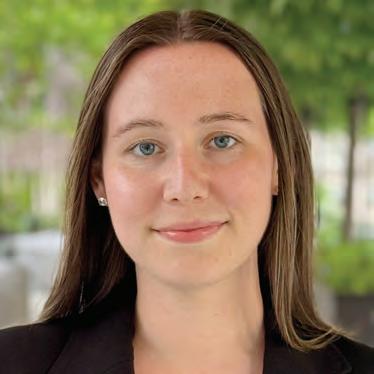
gathering leasing documents, and ensuring that those spaces were move-in ready for the tenants.
“We are the ones that speak to the tenants in the beginning, and we’re promising them all these things,” Tuteur said. “We have to go back to our internal teams to make sure that everyone’s on the same page so we can deliver this space to them, as we said.”
Outside of her life at SL Green, Tuteur helps other commercial real estate professionals get their start in the industry as co-chair of the mentorship program at Commercial Real Estate Women (CREW). At CREW, she connects younger women in commercial real estate with those with decades of experience, and hosts events on interviewing and networking.
Tuteur is also a mentor herself, advising a first-generation Barnard student through Big Brothers Big Sisters New York. —C.Y.
Thomas Usher, 24 Associate at Avison
Young
Thomas Usher’s path into real estate began in his Connecticut high school, when he experienced the joy of a successful cold call earlier than most.
“I was selling knives in high school,” said Usher, who earned a bachelor’s degree in commercial real estate finance from the College of Charleston. “I had a really big sale and I felt a rush from that, and then I was like, ‘How could I emulate this on a bigger scale?’ ”

Usher interned at Matthews Real Estate Investment Services, Hayes Commercial Consulting and Ecotone Renewables before joining Avison Young in 2024.
Usher’s responsibilities as a tenant rep associate for the office sector at Avison Young include site selection, financial modeling, lease negotiations and implementing cost-saving initiatives, but his high school cold-calling background is put to solid use.
“I’m a big canvasser — I canvass pretty heavily on agencies,” said Usher. “That involves cold calls to C-suite executives to find out information on their buildings, or just to start a conversation. We get meetings through that, and hopefully over time they lead to tenant rep deals.”
One major project Usher worked on was the Gantry Point office building in Long Island City, which was purchased by Sotheby’s for $82 million in 2022.
“Winning that as a team was a great feeling, and being able to work for Sotheby’s on their building is a big honor,” said Usher. “I’m excited about it.”
Usher also works on Avison Young’s APF Properties account, canvassing for potential tenants for the owner’s 183 Madison Avenue, 286 Madison Avenue, 28 West 44th Street and 1156 Avenue of the Americas.
Usher says he looks forward to continuing along this path, working in ways that benefit Avison Young’s clients.
“I want to do as much brokerage work as possible. It’s what I’m most passionate about and where I find myself comfortable,” he said. “I love the tenant rep aspect for an agency. You’re helping everybody win.” — L.G.
Rebecca Tuteur.
Thomas Usher.
Kimberly Troeller.

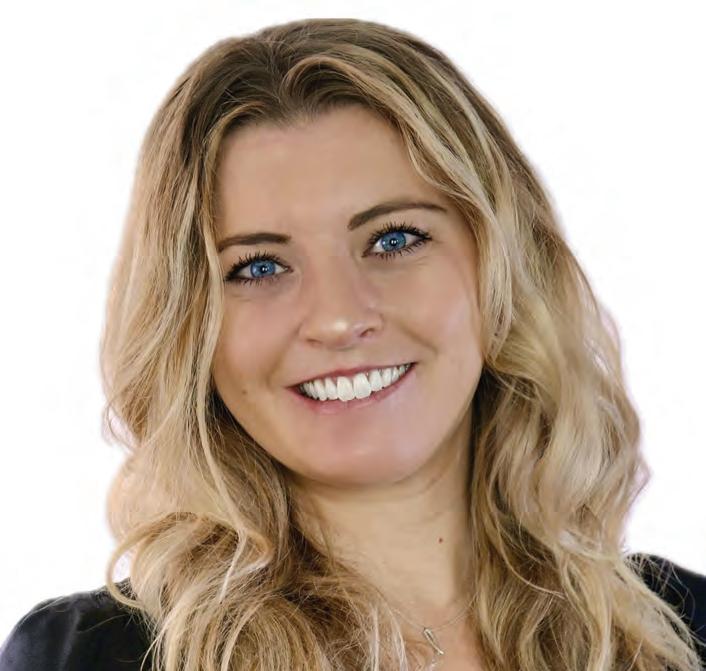
James Valenti, 26 Senior associate at Ripco
James Valenti was given an unlikely crash course in retail real estate while working in a restaurant: He watched one of the owners negotiate leases and work on possible new locations. Eventually, the owner connected Valenti with a friend of his at Ripco, and that helped Valenti get his foot in the door working on Long Island and Queens retail leasing.
“There was a lot of hesitation from business owners, and a lot of uncertainty around brick and mortar, when I started,” said Valenti about his early years amid the pandemic. “Things were a little bit slower for me. That was probably best. Having no background in real estate at all, it helped me learn at a pace that was better for me.”
He’s been a quick study. Over the last four years, Valenti has worked across all different categories of retail, on both the tenant and owner sides of deals, all across Long Island. That has included representing landlords such as Cedar Realty Trust, Jasko Development, Urban Edge and Heidenberg Properties Group.
Valenti’s biggest deal to date was helping to find a 34,000-square-foot space in March for a Picklr, a national pickleball franchise, in the Suffolk County hamlet of Centereach, giving the Utah chain a foothold in the East. He’s also helped with mall staples in markets such as Farmingdale and Dix Hills, including the Savers thrift store chain, Planet Fitness and Phenix Salon Suites.
It’s a good time to be working in retail, he said. Higher tariffs and other economic uncertainty have unnerved some, but he’s generally found that retailers, and his team, are going strong.
“I really like it here, and obviously, as time goes on, hopefully I gain some bigger responsibilities, bigger tenants, bigger landlords, bigger spaces and, the ultimate goal, bigger deals.” —P.S.
Lea Voytovich, 26 Associate at Avison Young
Like many in the industry, Lea Voytovich comes from a real estate family. Her father, Steven Rudolph, worked in development for Chicago’s Klutznick Company.
What’s surprising is that it took a different set of experiences and influences to nurture the daughter’s passion for the field.
“I was researching REITs in China and working on mutual fund research,” said Voytovich of her time interning for Morningstar in Hong Kong. “That really solidified the fact that I wanted to do real estate rather than just have a more typical financial role. Real estate was always the most interesting part of the finance world.”
Her first full-time job, as an acquisitions analyst for Northwood Investors, also brought with it her biggest deal to date, as she worked on the $382 million purchase of two Class A office buildings in Seattle in 2021.
“I ran the numbers and worked in conjunction with a senior analyst, and then I worked on a model with him,” said Voytovich.
In the time since, she has shifted from analysis to brokerage, first at Kassin Sabbagh Realty and then at Avison Young, which she joined in October 2024.
At Avison Young, Voytovich supports property sales across asset classes with a focus on underwriting, market research and transaction management, in addition to helping evaluate investment opportunities and advising clients on office and multifamily assets throughout the region.
“I would like to be a power broker in New York,” said Voytovich. “I decided to switch over to brokerage and focus on New York because there’s so much opportunity here, so I wanted to switch from more national coverage to really getting involved here.”
Voytovich sees herself spending the next decade building a strong network en route to becoming a power player in the New York office market. “I’ve historically worked on office,” said Voytovich, “so I’m hoping to really make a name for myself in the office sales world.” —L.G.
James Valenti.
Lea Voytovich.
Taylor Walker, 28 Senior associate at CBRE
Much of Taylor Walker’s life growing up revolved around lacrosse. The Glastonbury, Conn., native played on club teams and attended camps and clinics in the summer, where her adept play in the midfield drew the attention of Boston College while she was a high school sophomore. Her BC team was so good they played in the national championship game three consecutive years. They prepared by taking their matches one play at a time.
“Emotions were high and it was incredibly intense,” she said. “There was an extra push to try to keep going as far as you could.”
Walker kept the same mentality of preparation and cooperation when she joined CBRE’s Boston office in 2019 after college. Several BC alumni and people connected to her lacrosse team had entered the industry, so it was an easy decision. But moving to New York three years later was more difficult.
“I felt like I could home in and advance in my career and never move, but I thought I needed something bigger than Boston and had a lot of friends who moved to New York after college, so I took the leap of faith,” she said.
Walker joined CBRE’s life sciences team and helped New York University find a 50,000-square-foot lab for its incubator facility in Court Square, Long Island City. She has since been a free agent, splitting her time between being a tenant rep and working with landlords. Last year she helped the owner of 26 West 17th Street lease up four floors of its 120,000-square-foot office.
Walker doesn’t play lacrosse anymore, although she teaches lessons to girls who want to learn the game. But the sport helped her think about the importance of following through on every aspect of a deal.
“You have to be humble, put your head down, and do the hard work to get noticed,” she said. “You should celebrate the little things and know there’s an end goal in mind, but the deal isn’t over until the last 1 percent of it is done.” —A. Short
David Waterman, 27
Associate director at Newmark
David Waterman’s interest in real estate came from growing up in New York, but he had to leave to gain perspective about his life’s path.
The Upper East Side native grew up playing hockey with some of the NHL’s current stars, including Adam Fox and Charlie McAvoy. “Charlie looks the same as he did when he was 12, and he plays the exact same brand of hockey,” Waterman said.
He continued playing hockey, lacrosse and soccer but also followed his interests in photography and the arts. At the University of Denver, professors in the school’s vaunted real estate program showed him the industry was more than leasing space.
“Real estate to me is almost like an orchestra — everybody is playing their role,” he said. “A deal has many different sides, and leasing is a small piece of that.”
Unfortunately, capital markets deals dried up during the pandemic, so Waterman’s father, Brian Waterman, a top Newmark executive, suggested starting as a commercial broker instead. David Waterman has since focused on meeting his office tenants’ unusual needs.
This year, he helped fragrance company Osmo move into a manufacturing, office and distribution facility in Elizabeth, N.J., where workers could use artificial intelligence tools to mix scents. He also found a new space for Morilee, a bridal boutique, at 158 West 27th Street, allowing them to leave their Midtown West design shop. And he worked with Dispatch Energy to identify a New York headquarters for its distributive energy firm that aims to install solar-powered roofs and fuel cells in industrial buildings.
“As businesses mature and the world changes, the needs of tenants are changing, too,” Waterman said. “We have an ability and platform at Newmark to help companies do what’s right for their business and develop a strategy around them.”
These days, Waterman lives in Nolita with his golden retriever, Ellie, and he still joins a weekly hockey game at Chelsea Piers. “I’ve always lived on the credo: The name on the front of the jersey means more than the name on the back,” he said. —A. Short
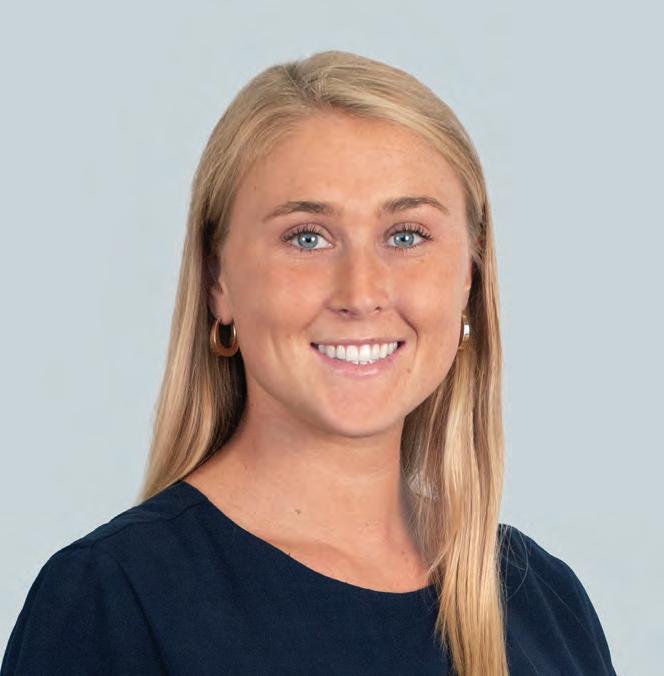

David Waterman.
Taylor Walker.

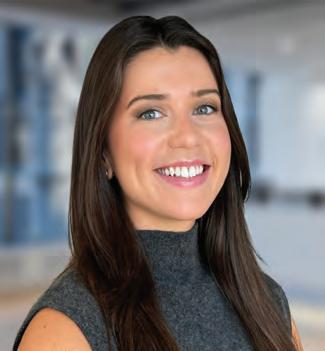
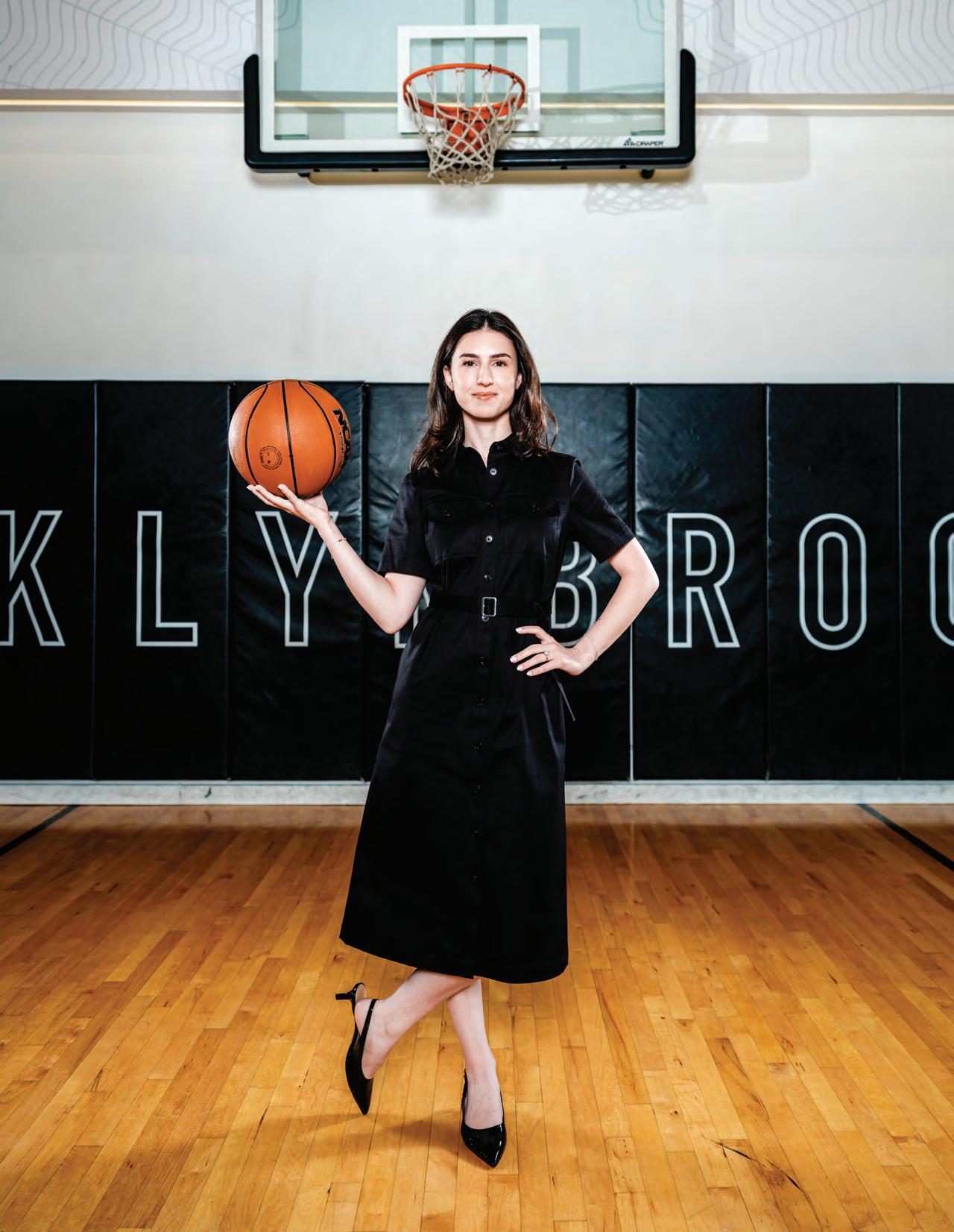
Aliza Herz
By Andrew Coen, Cathy Cunningham, Brian Pascus and Alison Rogers | Photograph by Chris Sorensen
Amir Abdu, 34
Managing director of investments at BGO
In the 10th grade, Amir Abdu’s class took a personality test to determine which job each student was best suited for.
“I guess my answers were too balanced or noncommittal, because my test came back with zero job recommendations,” Abdu said and laughed. “My friends got ‘doctor,’ ‘lawyer,’ ‘engineer,’ and I got nothing. I was never overly concerned about a future career until that point.”
So, Abdu went down the rabbit hole of researching and picking a career for himself, and decided that his dream job was to be an investment banker on Wall Street. He landed internships in Goldman Sachs’ public sector and infrastructure and real estate investment banking groups before joining BGO’s predecessor, GreenOak, in 2015..
Over the past decade, he’s worked his way up the ladder, becoming managing director of investments at BGO in March 2025. Today, he oversees the firm’s U.S. data center and powered land strategy, which brings him full circle to his first internship (and the career that a personality test could not predict).
Further, he’s one of the youngest employees to be promoted to managing director at BGO — for good reason.
Abdu led the largest investment in BGO’s Core Plus Fund, which also happens to be its top-performing multifamily asset, with recent renovations resulting in a 50 percent increase in rental income in three years. He’s also leading BGO’s drive to acquire powered land, or sites with committed power loads. Working alongside BGO co-CEO John Carrafiell, Abdu developed a strategy of identifying powered land that can be repositioned for data center development and has an active pipeline of potential opportunities.
Abdu is also using his well-honed investment acumen to determine when to walk away from deals. Case in point: a cold-storage development project that BGO was working on. When an environmental issue was identified that changed the deal’s risk profile, Abdu recommended the firm exit the deal.
While Abdu may have lots to thank BGO for, there’s one thing that tops it all.
“I met the love of my life at BGO,” Abdu said. “We met at one of our holiday parties. She’s an in-house attorney on our Google team. We had our wedding last summer.”
In his spare time Abdu loves spending time with his wife Estefanía Guillen Abdu and their micro bernedoodle. —C.C.
Legan Bayombo, 30
Senior analyst in equity fund management at Silverstein Properties
Legan Bayombo got his start in construction management after college and quickly learned about the number of stakeholders involved in real estate projects. The experience gave him a pretty unbeatable foundation (no pun intended) in learning the real estate ropes — and the fact that developers held the power when it came to decision-making wasn’t lost on him.
After attending Columbia, Bayombo joined Silverstein Properties in 2022. Today, he helps manage the acquisition, financing, construction and asset management of a $2.4 billion real estate portfolio consisting of nine multifamily assets and one life sciences building in opportunity zones nationwide. He also recommends capital allocation strategies for two REITs and four single-asset fund investment vehicles.
Bayombo joined Silverstein at an especially
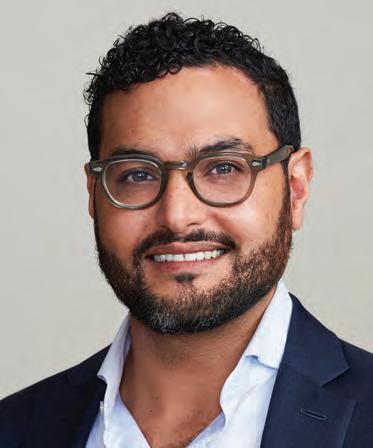
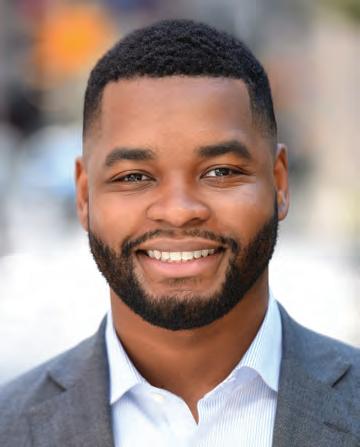
interesting time, just as interest rates were starting to rise. Navigating the impact of that incline on asset values, asset management needs and simply making pipeline deals pencil was a big focus for his team from the offset.
“It was definitely a challenge, but what we’ve been focusing on as a firm is assets that are in markets where we have an expectation of growth, and trying to find a differentiated product in order to get the alpha that we would hope to achieve,” Bayombo said.
And, Bayombo’s closings show there have been plenty of deals to talk about these past few years. He worked on the $215 million project capitalization of 3.0 University Place, a 250,000-square-foot life science building in Philadelphia, as well as the $436 million capitalization of South Pier at Tempe Town Lake, a 722-unit multifamily project in Tempe, Ariz. The latter included $223 million in construction financing and $213 million of equity from Silverstein’s fund.
As for the advice he’d bestow upon anyone considering a similar career path: “Early in your career, I think it’s very important to put your head down and learn as much as you can. Just soak up as much knowledge as possible from your various team members. I’ve been fortunate through being in the seat of an LP in being exposed to so many different asset classes and how capital market trends are influencing different deals in different sectors across the country, and having as much breadth of experience as possible is very important.”
—C.C.
Patrick Boyle, 32 Vice president at Colliers
For the last 10 years, Patrick Boyle has been a pillar of Colliers’ Boston office. Since joining the firm straight out of college in 2014, Boyle has gone from working as a junior analyst in a capital markets group to working with senior brokers as a top producer. Today, he leads his own book of repeat and institutional clients primarily across the Northeast as a Colliers vice president.
“I’d say that our company really blends being an institutional-branded brokerage firm with allowing us to be entrepreneurial and client-focused,” he said. “We don’t get stuck passing things off to the analysts or use these super-layered team structures.”
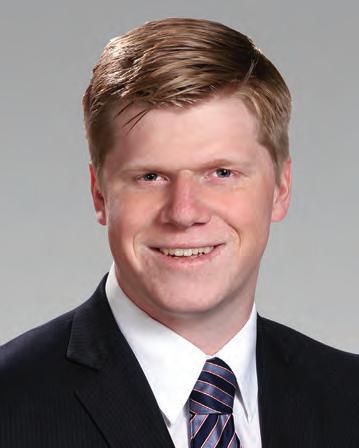
Boyle’s bread and butter is middle-market, private and institutional borrowers who deal across asset classes. His transactions usually fall in the $10 million to $50 million range. And while he’s recently been arranging financing for industrial and multifamily assets, Boyle has plenty of hotel, office and retail transactions under his belt.
In the last year, Boyle arranged a $52 million refinancing of a 370,000-square-foot industrial property on behalf of Bain Capital and Oliver Street in Summit Street in Peabody, Mass.; $28 million in takeout financing for an office property in West Hartford, Conn.; and $34 million to refinance office property at the Custom House Block and Gardiner Building at Long Wharf in Downtown Boston, a historic property that originally opened in 1760.
Boyle credits his client-centered approach to the successful resolution of complex transactions.
“As an intermediary, you need to understand what’s important to the client — every client has different hot buttons in terms of what they like and need,” he explained. “It’s how repeat business becomes so valuable to us. Pretty much all of our clients come back and have us execute across their portfolio.” —B.P.
Amir Abdu.
Legan Bayombo.
Patrick Boyle.
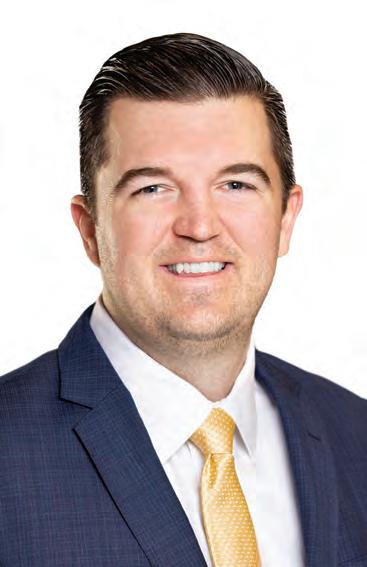
Tim Brousse, 32
Senior vice president at Eastdil Secured
Tim Brousse studied finance at the University of Arizona without commercial real estate on his radar until after his sophomore year, when he connected with the multifamily brokerage world. One of Brousse’s aunts knew a broker at HFF prior to JLL acquiring it, and set him up with an internship at HFF’s office in Newport Beach, Calif.
“I started there, candidly, not knowing what I was getting into but enjoyed all the people I worked with and came back the summer in between my junior and senior year, and did the same thing on the multifamily investment sales side with HFF, and ultimately was offered a position on the finance side post-graduation,” Brousse said. “I never targeted commercial real estate specifically, but it kind of fell into my lap and has been a great journey since then.”
Since joining Eastdil Secured in April 2021, Brousse has arranged several large multifamily financings on behalf of property owners, with more than $13.5 billion of deals closed. He has also led Eastdil Secured’s multifamily agency business through a partnership with PGIM, which has transacted over $5.5 billion over the past four years.
Brousse has encountered multiple market challenges in his young career, from the COVID-19 pandemic, rising interest rates and unknowns from President Trump’s global tariff policy announced on April 2. The experience of going from near-zero borrowing conditions to higher-for-longer interest rates has given Brousse an early education on steering property owners through various market cycles.
“Deals were getting done at a rapid pace with a lot of volume and it was a great time to borrow money, and then fast forward to today — it is a little bit more challenging with the interest rate environment,” Brousse said. “It’s been eye-opening.”
When not closing loans, Brousse enjoys playing golf in the Phoenix region where he lives. He also keeps busy as a parent, with his youngest child 2 months old. —A.C.

John Caraviello, 29 Director at Newmark
John Caraviello says that he learned a lot during his three years at Eastdil Secured, but felt that his upward mobility was capped. He became open to finding a new role with greater responsibility and pitched himself to Newmark. Little did he know, he’d be selected to join the high-powered debt and equity brokerage platform led by Jordan Roeschlaub and Jonathan Firestone.
Caraviello came on board an operation that facilitated $40.1 billion of debt between March 2024 and March 2025, a total that doubled its origination volume from the previous 12 months.
“When I joined Newmark in March 2024, I was thrown right into the fire,” he said. “Literally, the week I joined, we got awarded the opportunity to pitch the [$335 million] refinancing of the Mark Hotel in New York. At Newmark, I was immediately given increased responsibility.”
Caraviello structures large-scale debt and equity financings across the capital stack, asset classes and almost all geographies. Deals that he’s stamped his name on include $315 million financing for Project Ascend, a national portfolio of 43 self-storage facilities that spans 3.1 million square feet and holds more than 21,300 units. He was also involved in a joint-venture refinancing of self-storage properties between TPG Angelo Gordon and Andover Properties, which required placing $275 million of commercial mortgage-backed securities debt from Wells Fargo and Goldman Sachs and a $40 million mezzanine loan from 3650 Capital.
“What’s crucial is executing on behalf of clients … it’s important to give them accurate guidance,” he said. “You’re only as good as your reputation.”
Speaking of reputation, Caraviello is quick to note that he works directly under Roeschlaub, among the biggest names in CRE capital markets.
“Working under Jordy, he’s by far the best salesperson in debt brokerage,” said Caraviello. “He knows everyone in the industry and he’s always on top of things.” —B.P.
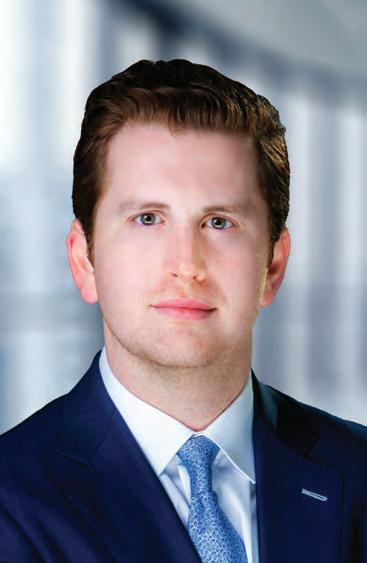
Andrew Cohen, 28
Senior director in capital markets at Marcus & Millichap’s Institutional Property Advisors
“I was ‘eat, sleep and breathe’ commercial real estate from the time I was little, through my father,” Andrew Cohen said when told he had made this list. (His dad is Ken Cohen, a finance executive at Bank of America and a regular honoree on Commercial Observer’s Power Finance list.) “So it’s nice to be recognized on my own.”
Well, that can happen when you work on the nation’s largest office-to-residential conversion.
The conversion of the erstwhile Pfizer HQ in Midtown Manhattan will result in some 1,600 new multifamily units, totaling 1.2 million gross square feet, 950,000 net residential rentable square feet, and 100,000 square feet of amenities.
The road to that started in August 2023. That’s when Cohen joined IPA, a subsidiary of brokerage giant Marcus & Millichap, to support Max Herzog and Marko Kazanjian as they expanded the firm’s capital markets platform. A year later, the team arranged the financing for the acquisition of the two 42nd Street properties that Pfizer had leased from 1968 to 2022.
The development of the parcels is complex, involving shaving off the top of the existing building at 219 East 42nd Street to reinforce a podium that will be topped with a 20-story tower, as well as adding another four stories of amenities at 235 East 42nd. Hence the need for $720 million in proceeds, the largest construction loan in Manhattan so far in 2025 (it closed in May).
Cohen — involved in executing, underwriting and deal placement of the construction loan — notes that the transaction drew “multiple backup offers at ask, testimony to our team knowing who the players are in the space today.”
In addition to his deal responsibilities, Cohen, a George Washington University graduate who lives in a FiDi office-to-residential conversion himself, is also in charge of the expanding team’s analyst pool. “I was yelled at as an analyst,” he recalls. “Now I rule with a stern but fair fist.” —A.R.
Tim Brousse.
John Caraviello.
Andrew Cohen.
Henry Fenmore, 28 Senior associate at CBRE
Henry Fenmore has been on quite the roller coaster of market activity since joining the commercial real estate finance profession in 2019 as an analyst on Deutsche Bank’s commercial mortgage-backed securities group.
From the COVID-19 pandemic, Russia’s invasion of Ukraine, rising interest rates and now unknowns about global tariffs, Fenmore has received his share of education about how to respond to various market conditions.
“It has given me the ability to identify risks and deals that maybe some other people wouldn’t see,” Fenmore said. “I have learned how deals progress through their lifetime and some things to watch out for as the market may turn or dislocate.”
After three years at Deutsche Bank, Fenmore joined CBRE in June 2022 and has utilized his background in CMBS deals to help lift the brokerage’s financing activity. In the last year and a half alone, Fenore has executed large transactions totaling $14 billion, including $6 billion of CMBS volume working in close collaboration with Tom Traynor and Tom Rugg, the brokerage’s vice chairs and co-heads of U.S. large loans.
Fenmore said the most prominent deal he worked on was a $500 million balance sheet loan for SL Green to refinance 919 Third Avenue from a six-bank syndicate led by Credit Agricole and Aareal Bank in April 2023, a time when few office deals were getting financed.
Fenmore credits Traynor and Rugg as being influential mentors, and he also prides himself on teaching junior team members the skills necessary to execute large deals. He also gives back to his alma mater, Southern Methodist University, through his involvement with an executive mentoring program via service on real estate associate board at SMU’s Cox School of Business.
Outside of facilitating deals, Fenmore has a passion for fly fishing (he spent Memorial Day weekend casting with his grandfather in Oregon), and he also enjoys sampling the many restaurants in his home neighborhood of Lower Manhattan when not cooking himself. —A.C.
Adam Freindlich, 30
Vice
president
at MAG Partners
Since Adam Freindlich was from New Jersey and interested in real estate, working for a developer of New Jersey waterfront properties seemed like a pretty good job.
Yet, after three years at Roseland Residential, the Wharton grad went to work at a real estate private equity firm, hoping to learn a different aspect of the business.
After he spent just five days in the office, COVID-19 hit. Freindlich was now relegated to sitting on his couch, trying to bond with his team through online Zoom meetings. So, when the phone rang — and even though the screen said “unknown number” — he answered.
The caller was MaryAnne Gilmartin, a New York real estate legend who had been hired as interim CEO at Mack-Cali, the company of which Roseland was a part. “She wanted to get my take on the people, the company,” Freindlich recalls.
His honesty and forthcoming attitude was enough to impress Gilmartin. She offered him a temporary job two weeks later. Said Freindlich: “It didn’t take that much convincing.”
After the interim gig ended, Freindlich followed Gilmartin to her own development shop, MAG Partners. The firm was wrapping up being awarded a development on the Penn South campus in Chelsea.
And just like that, Freindlich had a great job, one he calls a “master class.” He structures strategic partnerships
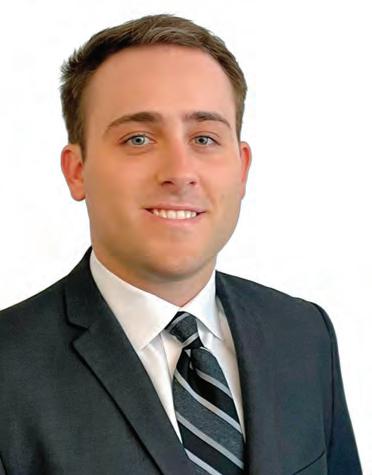

and manages assets through all phases of investment. In June 2025, the Chelsea multifamily project named Mabel and another MAG Partners project, Anagram Turtle Bay, opened for leasing on the same day.
Across the two projects, Freindlich led efforts in conjunction with firm leadership to secure $169 million of total construction loan financing and $124 million in new equity investment. These commitments represented 83 percent of total project capitalization, sourced from MetLife, Global Holdings, and Bank OZK.
The two projects are each about 200 units, but in other ways they are very different. In contrast to the 23-story tower of Turtle Bay, Mabel is seven stories, built horizontally to stay contextual within the environment south of Penn Station.
“Not just to maximize returns but to build the user- centric neighborhood enhancement,” explained Freindlich. “To enhance the neighborhoods, I think that’s our special sauce.” —A.R.
Cecelia Galligan, 26
Associate at Cushman & Wakefield
Merely three years after graduating from the University of Southern California, Cecelia Galligan has already made her mark at one of America’s largest brokerage firms. At Cushman & Wakefield’s New York office, Galligan is part of Vice Chairman Gideon Gil’s capital markets group, an eight-person team that specialize in all aspects of underwriting debt and equity across every asset class.
The team has placed $7.6 billion across capital stacks since Galligan joined in 2022.
“Since being promoted to associate, I’ve taken a more senior role of leading deals from packaging models in financing memos to actually getting on the phone with lenders and pitching opportunities and negotiating term sheets all the way to closing,” said Galligan. “It feels good to be part of each step of the process.”
Standout deals that Galligan has helped lead include a $134 million acquisition financing package for Project Redhawk, a 1.3 million-square-foot, multi-market industrial portfolio of 31 assets across two cities; and working with J.P. Morgan Chase and First Citizens Bank to secure
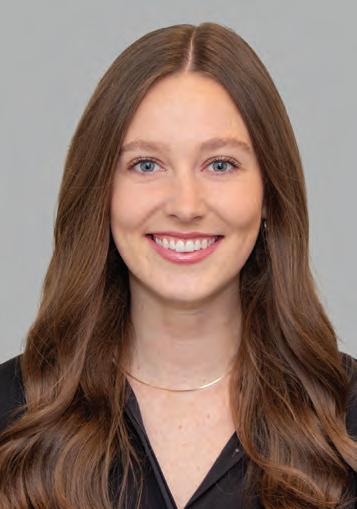
$75 million in construction financing for 255 East 39th Street, a new mixed-use development in Manhattan.
She also helped work out a $200 million cash-neutral refinancing for 500 Fifth Avenue, a 60-story, Art Deco office skyscraper next to Bryant Park that faced a special servicing challenge and CMBS workout.
It’s also not lost on Galligan that she’s already experienced inflation, a regional banking crisis, generationally high inflation, higher interest rates and a trade war. Since she began her career, it’s just been “downturn after downturn,” she admitted, but she noted the volatility has provided her with a rare learning opportunity.
“Sometimes, being in a more complex marketplace is actually a benefit, as lenders are asking questions they might not normally ask because they are constantly on the defensive,” she said. “So I’ve learned a lot having to navigate uncertainty.” —B.P.
Henry Fenmore.
Adam Freindlich.
Cecelia Galligan.
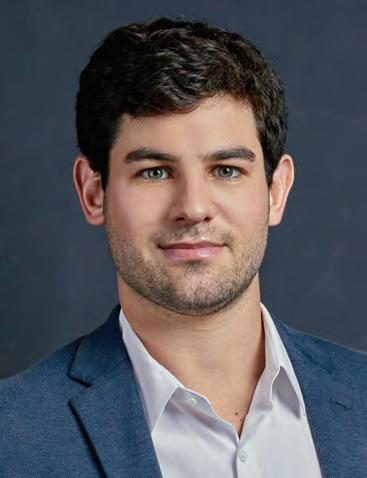
Cory Gottfried, 30 Associate at Mavik Capital
Cory Gottfried joined Mavik Capital in May 2024, and it’s pretty safe to say he has no regrets about his decision.
“It’s an exceptional place,” he said. “There’s a collaborative culture here, and new ideas are genuinely welcomed — that’s been something that’s been really rewarding to me. I came from a bigger, public REIT, and I compare Mavik to my hockey days because I feel like I’m on a team again here, and we’re all moving in the same direction.”
Indeed, Gottfried played ice hockey at Tufts University, where he earned an economics degree. After spending three years at Ladder Capital, he followed the puck — as it were — to Mavik. While 99 percent of his time is spent on the investment side today, he also has the opportunity to contribute across the organization, from asset management to business development to fundraising.
His deals have included acquisition and redevelopment financing for a Sag Harbor, N.Y., retail portfolio, acquired by a local developer without approvals in place for the business plan. While Mavik was initially approached for a mezzanine or preferred equity investment, the firm instead structured a financing package giving the borrower flexibility to execute the plan successfully, and without added execution risk.
“At Mavik, they really push everyone to think outside of the box, and I think that’s something I’ve learned over my past year,” Gottfried said.
Gottfried got his real estate start in high school, working for a residential contractor, which sparked an initial interest in construction. From there, he secured an internship on the construction team for Brookfield’s One Manhattan West. “That was an amazing experience to work on a multibillion-dollar project at such a young age. I picked out some of the tiles that are in the lobby, so I hope people like them,” he said.
While working on the construction side, Gottfried became fascinated with who was ultimately providing the dollars to facilitate the projects. “That’s what led me to Ladder, which led me to Mavik, and it’s been a great career path so far,” he said.
Outside of work, Gottfried plays in men’s league hockey. And, while the bumps continue both in the market and on the ice, he’s taking it all in stride. —C.C.
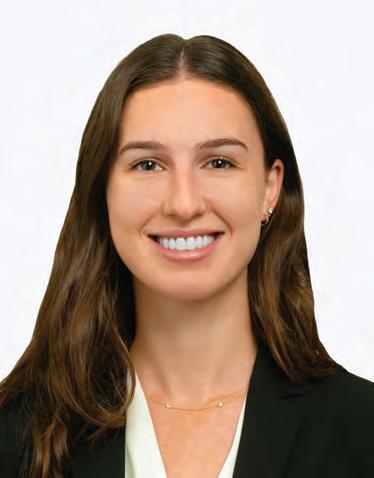
Aliza Herz, 27
Senior associate at Blackstone
Multifamily and industrial are at the top of portfolio wishlists for much of the industry. For Blackstone, they’re high- conviction themes, and Aliza Herz has already spent significant time working on both.
Today, Herz is part of the team that oversees Pure Industrial, Blackstone’s Canadian logistics portfolio company. Previously, she helped oversee LivCor — also a Blackstone portfolio company — which specializes in multifamily housing. Herz’s current role encompasses leasing, operations, budgeting, development, refinancing, valuations, balance sheet and liquidity management, and dispositions.
“What I love about my job is that no day is the same, and every day I learn something new,” Herz said. “It helps me to appreciate all that goes into building a strong business and driving results across various dimensions.”
The same goes for Herz’s time working on the multifamily side, where she primarily works on transactions. “It gave me deal experience, and I learned how to navigate tough negotiations and drive a process to get to the best outcome for the assets, for the business and — of course — for our investors.”
Herz’s notable transactions include the $1 billion sale of an 11-complex apartment portfolio to Equity Residential in August 2024. The deal was the largest U.S. multifamily purchase by any public REIT in the past seven years (as of the transaction announcement date).
Herz graduated from the University of Michigan’s Ross School of Business, where she was a key member of Michigan Business Women and a strong supporter of women’s causes. The past five years at Blackstone have presented plenty of market highs and lows, with tariffs causing the most recent bumps. For Herz’s business, trade uncertainty means tenants are taking longer to make decisions.
Blackstone’s people are ultimately what attracted Herz to the company in the first place — she recalls her initial instinct of her interviewers being “incredibly smart and hardworking, but most importantly, truly kind human beings that wanted me to succeed.”
And, she leans into the words of the firm’s president during tougher times in the market.

“Jon Gray always says, ‘Stay calm, stay positive, and never give up,’ ” she said. “There are good times and there are bad times, but staying focused on what drives value helps you find clarity and make the right decisions in times of dislocation. It’s always worked for me.”
—C.C.
Jackson Irwin, 30
Director at Walker & Dunlop
For Jackson “Jack” Irwin, heaven is other people.
“In business school, we had a few real estate classes that sparked my interest,” he said. “I liked the sales side of it. I’m a very social person.”
Commercial real estate financing and advisory allowed him to marry his finance degree and his easy skill at forming relationships. In the eight years he’s been at Walker & Dunlop, he has had six separate positions. Irwin started in government- sponsored enterprise underwriting, became the liaison to Aaron Appel’s vaunted capital markets team, and then joined that team, where he is now a generalist.
“I love the brokerage personalities,” Irwin said. “I love the craziness and the chaos.”
The past couple of years have been a difficult interest rate environment for CRE, but Irwin sees cracks in the ice. “I think we’re now in an environment of ‘higher for longer’ and people are just trying to get deals done,” he said. He also noted it’s a “super-liquid environment from a debt perspective.”
Even back in the bad old days of higher rates, Irwin was firing three-pointers, such as working on the $754 million bridge loan — plus condo inventory loan — for the Aman New York. The project occupies Fifth Avenue’s Crown Building with 22 condos and 83 hotel rooms. The prices have been eye-popping, with one penthouse condo notching more than $10,000 a square foot. Then, last year, the Appel team arranged a $1.2 billion refinancing for One High Line, the Bjarke Ingels-designed project formerly known as The XI.
The future of the luxury market? “I think there is more room to run,” said Irwin, who relaxes by cooking Italian specialties such as pasta all’Amatriciana during his downtime. “New York is New York — it’s the mecca of finance. From a real estate perspective, you should never bet against it.” —A.R.
Aliza Herz.
Jackson Irwin.
Cory Gottfried.
Steven F. Jemal, 31 Managing director of originations at S3 Capital Partners
Sometimes real estate is a family business. For Steven F. Jemal, it’s something that he learned watching his uncle, Isaac Seruya. “He used to buy shopping centers,” said Jemal. “I shadowed him for two years.”
The interest led to an internship at Cohen Equities. “I think they [Meir Cohen and Teddy Chattah] just wanted someone to drive them around while they looked at properties, but after three days they realized I was a terrible driver,” Jemal said. “So they put me in the back seat making notes while the other intern drove.”
Next was a job at Hirshmark Capital, which he held during his junior and senior years at Yeshiva University. “I went to all my classes in a suit,” Jemal remembered.
After graduation, he went to work for Shawn Safdie at S3. “It was a different kind of origination,” Jemal said thoughtfully. “Hirshmark was more opportunistic, and S3 is more loans to seasoned developers focusing on construction — but real estate is all about people, so I had the soft skills and trained on the job.”
In 2016, the same year he started at S3, he met Celi, who would become his wife. She had grown up in Florida, and he would accompany her to Hallandale Beach, Fla., for family visits. “Since I would go there to visit my in-laws, it was an easier market for me to start originating,” Jemal said. “We just closed a deal at Oasis Hallandale, which was really cool because that’s a site I would walk by.”
That deal, which was sealed in May, was a $112 million loan for a 250-unit tower. Jemal’s been busy: In the three and a half years since he started working in Florida, he has originated nearly $1 billion in the state.
Jemal continues to have a lot of balls in the air — he and Celi have two kids, ages 1 and 4 — but he hasn’t let that slow him. Overall, in the past 18 months, Jemal has been involved in more than $1.6 billion in overall loan originations. —A.R.
Erkan Kilic, 30 Principal at Blackstone
OK, so headlines aren’t everything (whispers the journalist), but if you don’t know Erkan Kilic personally, you’ll certainly know some of his deals.
Over his seven-year tenure at Blackstone, Kilic has worked on more than $26 billion of investments across 30 transactions, including the Signature Bank deal. Kilic helped Blackstone’s entry into a joint venture with CPPIB, Rialto and the FDIC to acquire a $17 billion loan portfolio from the bank. He also worked on Blackstone Real Estate Debt Strategies’ purchase of a $1 billion loan portfolio from PBB.
The Signature deal was a career-defining deal for Kilic, due to the sheer scale of the transaction and speed of execution required. “We only had about eight to 10 weeks to close, and it encompassed 3,000 loans across multiple property types, geographies and borrower profiles,” he said. “In order to submit a binding bid on a $17 billion portfolio, we had to think outside the box. Everything was moving really fast, and we had to land the plane under immense scrutiny.”
Kilic’s resume also includes impressive work on the affordable housing side. He played a pivotal role in both establishing and expanding Blackstone’s affordable and low-income housing tax credit equity platform, April Housing, driving $300 million of investments across three transactions in the process. Working on affordable housing investment has fundamentally

reshaped how he thinks about risk, scalability and impact, he said.
“It taught me how to build a new investment vertical from the ground up, and everything from structuring affordable transactions to aligning with internal and external stakeholders,” he said. “It gave me a lot of exposure to public-private partnerships and policy-driven capital, which is increasingly relevant as housing affordability becomes a defining issue in real estate. Blackstone’s entry into that market made a huge impact, and I’m really proud of what we built.”
Kilic grew up in Istanbul. “Istanbul has undergone a significant transformation due to earthquake-driven zoning changes I saw firsthand,” he said. “Entire neighborhoods were reshaped, and real estate wasn’t just about buildings, but about public safety, economic resilience and quality of life. It left a big impression on me at a young age, and I realized that real estate is the largest asset class in the world, but it’s still governed by legacy thinking and outdated structures. I wanted to be in the field and work somewhere where I could drive meaningful change.”
Sounds like Kilic has firmly accomplished that goal.
—C.C.
Andrew Kim, 34
Director of transactions at Invesco Real Estate
Andrew Kim is no stranger to real estate. His grandfather built single-family homes, and his father now
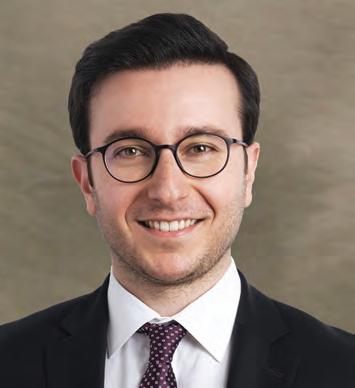

runs a commercial and residential brokerage firm in Philadelphia.
“I love to say that real estate is in my blood,” Kim said.
After attending Columbia Business School, where he was awarded the Pension Real Estate Association Scholarship and the Alexander Bodini Memorial Real Estate Fellowship, Kim found himself attracted to Invesco’s multidisciplinary approach. Since joining the $90 billion alternative asset management firm five years ago, Kim has moved from the acquisitions side to the credit investments team full-time. Today at Invesco, he originates, underwrites and evaluates credit across all asset classes.
He believes that the single best part about working at Invesco is the firm’s collaborative culture and the people who have mentored him every step of the way.
“I have been very fortunate to learn from many talented, accomplished individuals who I consider to be mentors throughout my career,” Kim said. “While certainly not an exhaustive list, I’m especially grateful for Yorick Starr, Charlie Rose and Teresa Zien.”
Two of the biggest deals he’s worked on include closing a $180 million loan secured by an eight-asset, 2.1 million-square-foot logistics portfolio, and securing $770 million worth of loan facilities backed by Brooklyn residential properties for an institutional private equity firm.
“This deal showcased the power and reliability of the Invesco platform,” said Kim. “We have a fantastic, collaborative culture. We’re all highly motivated to see our firm succeed.” —B.P.
Steven F. Jemal.
Andrew Kim.
Erkan Kilic.

Jesse Kopecky, 30 Vice president at Greystone Capital Advisors
During his time at the College of Charleston in South Carolina, Jesse Kopecky would meet a few times per week with a local real estate developer. The mentorship stirred in Kopecky his first desires to work in high-level commercial real estate, and taught him that the debt side of the business drives almost all transactions.
At Greystone, Kopecky works with one of the nation’s top multifamily debt providers and a specialist in Fannie Mae, Freddie Mac and Federal HUD housing loan originations. Over the last six years, Kopecky has settled into the advisory side of the business, where he handles structured finance, ground-up development, and third-party operator (TPO) bridge loans.
Basically, this young Swiss Army knife works directly with clients to solve their capital needs.
“The pillars of Greystone resonated with me, and the culture is really strong,” he said. “I’ve met really amazing people across the whole business, and it has felt like a great place to learn and expand my career.”
The standout deals that Kopecky has helped lead include the massive $564 million refinancing for Douglaston Development and Ares Capital of 3Eleven, a

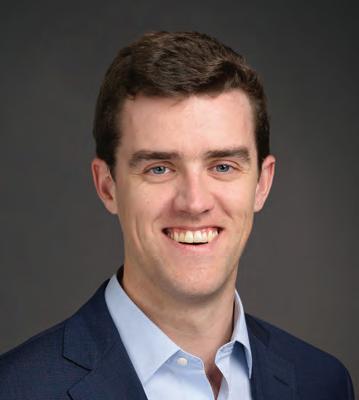
60-story, 938-unit high-rise in Hudson Yards — a deal that doubles as the single largest financing Greystone’s ever done. There’s also a $287 million debt and equity placement he helped arrange for Douglaston at 1057 Atlantic Avenue, a deal that will help build a 456-unit affordable housing property in Brooklyn.
As an increasing number of developers turn to private credit for their capital solutions, Kopecky is happy to be at a firm that can answer the call.
“There needs to be an openness to the evolution of the business and where capital flows are coming from,” he said. “I’m surrounded by extremely smart and successful advisers, and it makes my job a whole lot easier when you have a support system that’s as experienced as it gets.” —B.P.
Andrew Lanzaro, 33 Director in seniors housing and health care at Berkadia
What a difference a week makes. Andrew Lanzaro’s burning desire to play Division I lacrosse led him to Lafayette College (go, Leopards!). During his senior year, he took a one-week externship with a classmate’s parent
at their firm, a lender to the seniors housing sector.
“I got offered a job there,” said Lanzaro. “I had been thinking maybe sales and trading. Ten years ago, no one set out to say, ‘I’m going to seniors housing.’ ”
But the niche — which allows some creativity on the front end in structuring deals, as well as the ability to produce happy clients — stuck. When Berkadia was looking for an analyst 10 and a half years ago, Lanzaro took the job.
He is now partnered with Jay Healy, whom he’s supported for seven years. “I always tell the younger people you have to make yourself invaluable, and that’s what I try to do,” said Lanzaro. “When I get a task, I try to do it quickly and do it right, and also to take something off their plate. That way, if I left, they would have to do it.”
Lanzaro, who has had four job titles in his tenure, was promoted to director six months ago. Of course, there’s also a proactive side to climbing the ranks, and Lanzaro’s easy demeanor combined with a willingness to digest and comprehend 100-plus-page federal housing manuals has helped. His most recent success was a refinancing for The Park at University Village, an independent living facility, and The Inn at University Village, an assisted living facility, both in Washington state. The $102 million bridge loan proceeds took out an existing construction loan, preferred equity from a real estate investment trust, and a partner note from a major investor.
Berkadia itself funded the subordinate debt, for which it intends an agency exit. “In a sense, Berkadia is our client,” said Lanzaro. “My partner Jay and I spend time structuring deals to make sure they’re a sound credit, and they’ll get taken out the way that we say they will.” —A.R.
Aidan McLaughlin, 30 Director of originations at Nuveen Green Capital
Growing up in Kennebunkport, Maine, Aidan McLaughlin developed a passion for hobbies like fly fishing and duck hunting. These prompted him to minor in environmental studies at Middlebury College to go along with an economics major. McLaughlin then found the ideal pairing for his combined interests when he joined Greenworks Lending (now Nuveen Green Capital) closing commercial property assessed clean energy (C-PACE) loans.
McLaughlin’s career growth since joining Nuveen Green Capital as an analyst in 2018 has come in tandem with the rise of the lender and of the C-PACE sector overall, which entered the year nearing $10 billion of loans since Greenworks closed the first rated C-PACE deal in 2017. He moved to Portland, Ore., in 2021 to help lead C-PACE originations on the West Coast, with much of his time devoted to educating borrowers about a new financing vehicle that is still unfamiliar to many.
“It has its challenges and ups and downs, but overall it’s been a really positive experience, especially in the Northwest, where sustainability is huge,” McLaughlin said. “The development communities here are really strong. So once you start getting in, it starts to spread as people start understanding the program better.”
Since his westward move, McLaughlin has managed a number of transactions, including the first C-PACE deal in Alaska. He has closed around $250 million of loans in the past two years, including a $47 million C-PACE loan in early 2024 as part of an overall $89 million construction financing package for VP Companies to build a retail winery development in Woodinville, Wash.
“Our primary goal is to continue to work with institutional borrowers and institutional lenders, and build out C-PACE into more of a household name,” McLaughlin said.—A.C.
Aidan McLaughlin.
Jesse Kopecky.
Andrew Lanzaro.

Powell Robinson IV, 30
Vice president in real estate lending at DekaBank Deutsche Girozentrale
Powell Robinson’s first two internships were on a New York City trading floor and at a Greenwich, Conn.-based shopping center real estate investment trust. He loved the tangibility of real estate: “You can touch, feel, understand it; there’s a narrative,” he said. “As opposed to the name of the game in trading, which is get paper off your desk.”
Knowing he wanted to be in finance (his dad is a finance executive), he started at DekaBank in 2019. Headquartered in Frankfurt, the bank has 5,000 employees but just eight in New York — four for equity and four for debt. “My team, three of us debt originators, cover the entire U.S. $3 billion portfolio,” Robinson noted.
The team will generally do seven to 10 new originations a year totaling from $500 million to $1 billion. Most deals are in office, with industrial, hospitality and retail filling out the rest.
With such a focus on office, things were pretty quiet post-COVID for a couple of years. “When I would get a good quality office deal in, one that was beyond my ability to finance myself, I would dial someone in my Rolodex, and I would say the word ‘office,’ and the conversation would cease,” Robinson recalled.
The pipeline has recovered. “These days we’re comfortable around a hold amount of $100 million,” Robinson said. “If it’s an $85 million office financing, I can do that myself with the client.”
A larger deal would be last year’s refinancing of Brookfield’s One Liberty Plaza, a 2.3 million-square-foot Lower Manhattan office tower. “In the original deal, the total loan amount was $900 million,” said Robinson. The new loan amount is $750 million, with all 13 banks in the funding consortium having taken a pro-rata share of paydown. Robinson is as passionate talking about the numbers as he is talking about the clients. “The most fun part of the job — the reason why after six years I still love what I do — is that there’s a real duality to it,” Robinson said. “Half the time I am behind a computer screen, figuring out how the numbers come together. The other half of the time I’m client-facing, I’m social.” —A.R.

Clayton Ross, 30 Director in capital markets at JLL
“I was shining shoes all throughout college, doing my math homework, and then shining shoes and polishing brass for inspection,” said Clayton Ross of his time at The Citadel, South Carolina’s public military college. “In order to get through knob year [the first year, when cadets, among other challenges, shave their heads] you have to have a lot of vision. So I’d say military school teaches perseverance and attention to detail.”
And then an internship at a real estate brokerage after his junior year introduced him to the joys of developing business models, and he pivoted heavily into finance.
The combination of analytics and his military training have stood him in good stead at JLL, where he is on its capital markets team. In 2023, Ross and his cohorts were tasked with the selldown of a $1.4 billion piece of Signature Bank’s portfolio. The “multi-book,” as he called it, consisted of performing multi- family loans, and the team ended up placing it with three separate buyers.
“That one was heavy in the numbers, and then having conversations with market participants,” Ross said. “A lot of sleepless nights with that one.”
Of course, he was going to night school at the same time, finishing his MBA at Fordham’s Gabelli School of Business just last year.
Ross has recently been acutely focused on lender finance. A specialty is note-on-note financing, which he described as a “growing lane for the industry.” He’s also proud of having helped advise JLL alumnus Mike Tepedino — “that’s ‘Tango Echo Papa’ ” he tells CO — arrange a joint venture for his real estate lending firm, Blue Light Capital. Many details are under a nondisclosure agreement, but the raise amount of $500 million isn’t.
Ross described his activities as a juggling act, balancing academics (“If you’re not learning, you’re not relevant in this market”), work and relationships. For a numbers guy, he has a high awareness of, and dedication to, his relationships with his clients.
“It’s part of wanting to do a good job.” Ross said. “Just because you win a piece of business doesn’t mean the job’s over, right?” —A.R.
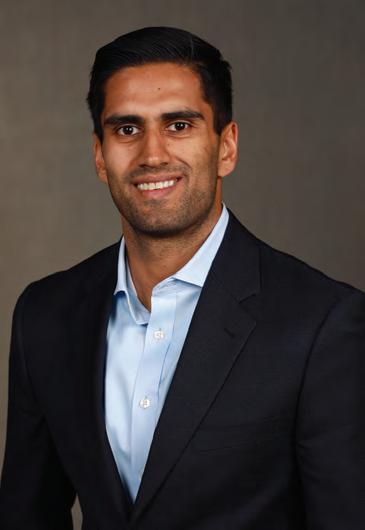
Shivam Shah, 30 Vice president at Hillcrest Finance
Even as far back as his undergraduate days, Shivam Shah knew he wanted to work in commercial real estate finance due to the tangible nature of its hard assets and the intensity of its deal flow. Little did he know that at Hillcrest Finance, an alternative asset manager that Shah joined seven years ago, he’d work directly under Kathleen Corton, who pioneered commercial mortgage-backed securities in the 1990s with Ethan Penner at Nomura Holdings.
“She really has been a great mentor to me,” said Shah. “I was assisting her as an analyst in an associate position on deal originations, and as I’ve grown more into the role, I took on more responsibility in the closing and origination of loans.”
Today, as a vice president and a senior originator, Shah works hand in hand with Corton, the firm’s chief investment officer and co-CEO, on middle-market mezzanine loan opportunities, as well as on subordinate debt deals and even large first- mortgage loans, an origination volume that has given Shah the rare opportunity to understand every level of CRE debt.
“Starting off in higher leverage positions has gotten me to see all spectrums of the capital stack, which has been pretty interesting,” he said with a smile.
Deals of note that Shah has closed in the last year include a $60 million first mortgage to convert a 268,000-square-foot office in San Mateo, Calif., and a senior mezzanine loan within a $430 million acquisition debt package of a nine-asset multifamily portfolio across four states. All told, since joining Hillcrest, Shah has closed $1.4 billion in financings across 21 transactions.
“Everyone in CRE is a deal junkie,” he said. “It’s about figuring out the best use of capital for your investors — time is money.” —B.P.
Powell Robinson IV.
Clayton Ross.
Shivam Shah.
Jonathan Tan, 29
Senior vice president in real estate finance at Goldman Sachs
Jonathan Tan’s exposure to global cities helped shape his pursuit of commercial real estate finance.
Tan grew up in Hong Kong before attending Harvard University, and then landed in New York City for a job with Goldman Sachs’ structured finance desk. That’s where he learned to appreciate CRE as an asset class.
“Our team covered really all asset classes ranging from infrastructure to consumer credit, and for me that was a great crash course in how asset-backed finance works,” Tan said. “By 2018, I wanted to focus more specifically on an asset class. I’ve lived in big cities my whole life, so real estate to me, I think, was an obvious choice because you can see and feel in these cities probably more than most places how much real estate shapes how we live.”
Since joining Goldman Sachs’ real estate financing group in 2018, Tan has focused on large loan originations for both commercial mortgage-backed securities (CMBS) and balance-sheet deals. He has grown sharply during his seven-year run managing CRE deals at Goldman Sachs and now spearheads data center lending coverage for the investment bank.
One of Tan’s highest-profile deals involved executing a $485 million acquisition loan in late 2024 for DigiCo REIT’s purchase of the 190,000-square-foot 800 Devon data center property in Chicago from Prologis and Skybox.
“We were able to securitize that data center construction loan in the CMBS market, and that’s the first time that’s been done,” Tan said. “These more innovative deals are often challenging because you’re solving many of the problems for the first time, but those deals are also for me the ones which have been the most interesting and the most rewarding.”
When not closing large loans, Tan enjoys reading about history and browsing the used books at the Strand in Manhattan. —A.C.
Jack Tawil, 26
Originator at Dwight Capital
Graduating college during the height of the COVID-19 pandemic changed the trajectory of Jack Tawil’s commercial real estate finance career.
Tawil, who graduated from Baruch College’s Zicklin School of Business in 2020, initially had a job lined up facilitating CRE acquisitions at a large family office, but that job fell through due to the global health crisis. He managed to find another opportunity through a contact at Dwight Capital, and since joining the lender has developed a specialty over the last five years for originating multifamily loans insured by the U.S. Department of Housing and Urban Development (HUD).
“Everything was up in the air back then and nobody knew what was going to happen in June of 2020, and I kind of pushed my way into Dwight and the finance, mortgage banking world,” Tawil said. “HUD financing is a pretty niche product, and I don’t think I would have picked it back then, but it has been great.”
Tawil has specialized in sourcing a variety of HUD-backed loans, and has so far financed more than 3,000 residential units. He now has a pipeline of roughly $600 million in loans.
The largest dean Tawil closed involved a $166.53 million HUD 223(f) loan in 2022 on behalf of Capital Foresight for seven Southern California apartment complexes comprising 1,154 units.
While HUD loan activity has slowed in the last three years due to elevated interest rates, Tawil has still managed to stay busy. Being hit with a market challenge early in his career proved beneficial, forcing him to think more outside the box in getting transactions across the finish line.
“When rates started rising so quickly, everything you had been working on for the last two, two and a half years was totally dead and you had to start over, so it was like starting day one on a new job,” Tawil said. “You had to put 10 times more effort in for half the results, but it pushed us to get creative and pushed us to get aggressive. And it’s finally coming to fruition.” —A.C.

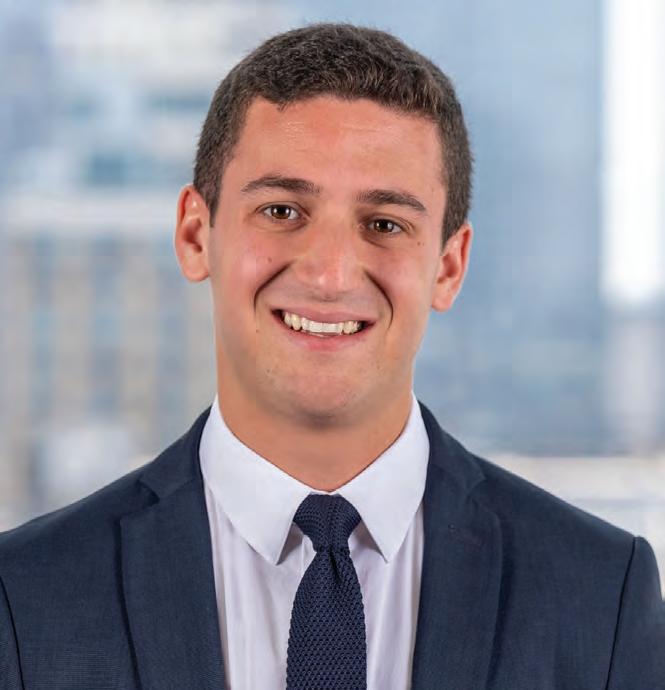
Jonathan Tan.
Jack Tawil.


Arnav Vaid, 27 Associate in real estate acquisitions at AmTrustRE
Growing up in India in a family that had developed commercial properties in Mumbai, Arnav Vaid couldn’t help but be drawn into the world of acquisitions and property development, particularly the mathematical and creative elements of the business.
“As a curious person, I’d ask a lot of questions and knew it was an interesting field because there’s a tangible asset at the end of the day,” he explained. That curiosity brought him to New York City, where he studied at the Schack Institute of Real Estate at New York University. For the last two and a half years, Vaid has grown his career at AmTrust, a family-run firm that specializes in office properties in New York and Chicago, and holds a portfolio of more than 12 million square feet. He now works directly under the firm’s president, Jonathan Bennett.
“A family office using family capital, you don’t have to answer to investors or a particular investment thesis — you have flexibility and opportunity to grow,” said Vaid. “In less than three years, I’ve gone from being a part-time analyst to a full-time associate and running the acquisition process under Jonathan, and having a significant involvement in the business’ asset management.”
Major deals Vaid’s been involved in include quarterbacking the firm’s $65 million acquisition of 360 Lexington Avenue, a 268,000-square-foot office tower in Midtown Manhattan that AmTrust purchased for one-third of its previous price. Within six months of closing the deal, AmTrust has seen occupancy in the tower increase from 60 percent to 80 percent.
Vaid argued that the deal is the perfect encapsulation of his firm’s strategy of remaining cautious during market highs but choosing to move opportunistically during periods of dislocation.
“It’s a patient, calculated strategy that has positioned us well for long-term success,” he said. —B.P.
George Zhang, 30 Investment associate at Teacher
Retirement System of Texas
George Zhang got his first taste of real estate while studying architecture at Washington University, but it was during his time as a grad student at Harvard that something truly clicked.
“Real estate is the perfect intersection between business and architecture,” he said. “I had an itch to go into finance and really understand its wider ecosystem.”
After working for a Dallas-based developer, Zhang took the opportunity to join Teacher Retirement System of Texas (TRS) three years ago. Today, Zhang is involved with the investment and management of the organization’s $30 billion global real estate portfolio and has contributed to $2 billion in new fund and principal investments.
Notable transactions Zhang has worked on include $300 million in seeding commitments to three new investment funds to provide growth capital and co-GP joint venture capital for real estate operating companies. Business plans for the JVs range from neighborhood retail to New York multifamily portfolios.
The past year has presented plenty of volatility as well as opportunity for the industry, and Zhang has had his work cut out analyzing changing trends. Part of his purview includes the red-hot data center sector, with TRS having committed around $1 billion to data centers within its real estate portfolio alone.
“There are cyclical trends as well as sectoral shifts,” Zhang said. “AI is moving very fast and a direct impact is definitely being felt on the data center demand side, but there’s a question of what it means for traditional real estate sectors like office — so, are people still going to value in-person office experiences? Thinking about these second-order shifts that could happen has been a big focus.”
TRS serves around 2 million teachers across Texas, and TRS’s mission is a big part of what Zhang loves most about his role.
“Every single investment decision we make will directly impact the check the teachers get,” Zhang said. “Frankly, I didn’t have as deep of an appreciation for this until I joined TRS. We manage about $200 billion and our target return is about 7 percent. In order to meet our return target, we have to make $50 million in extra returns each trading day. So that’s what inspires me — our mission, the scale of the impact, and also the intellectual challenge of it all.” —C.C.
Arnav Vaid.
George Zhang.
Grand Central Madison
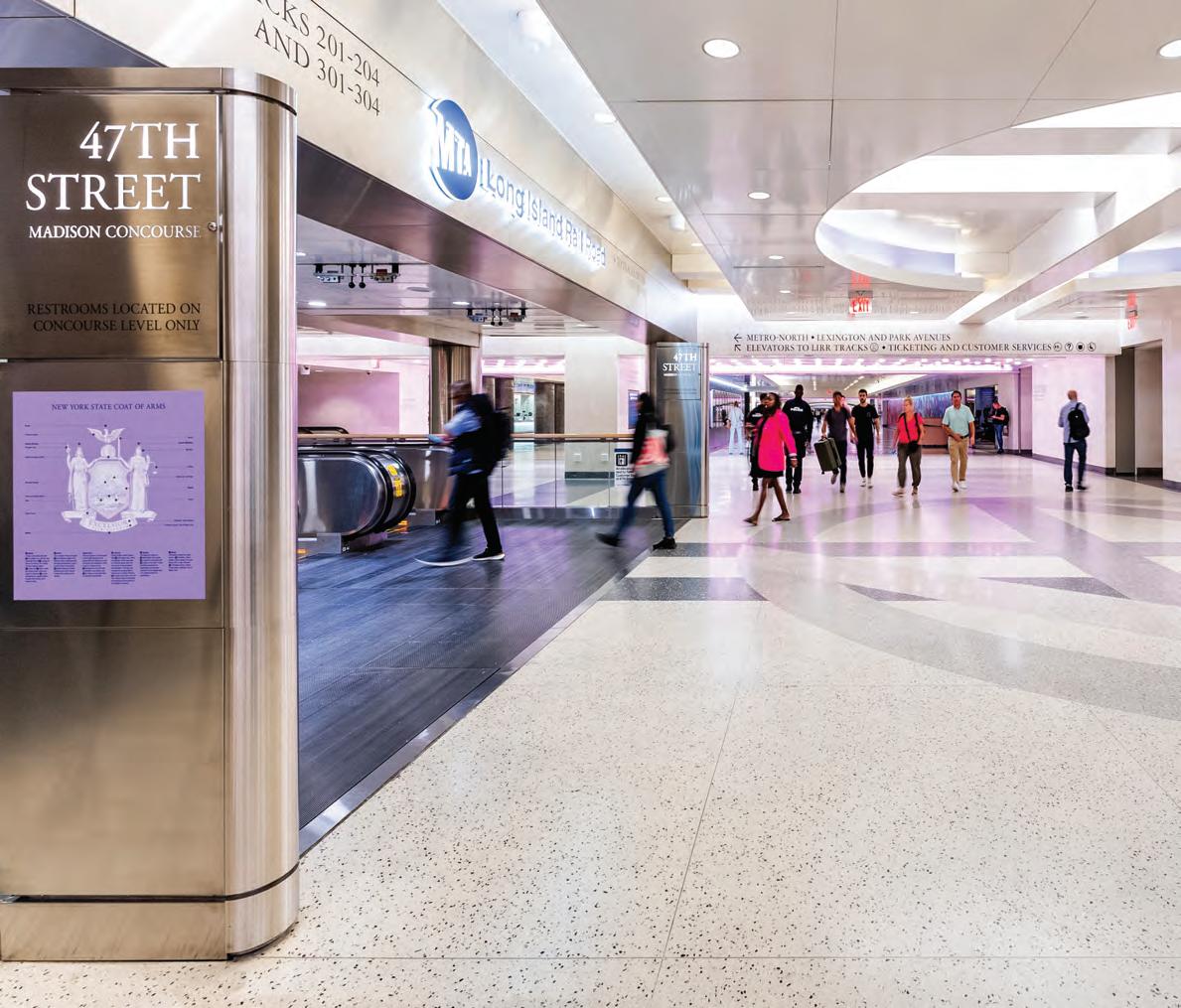
Retail space available
The Metropolitan Transportation Authority is soliciting proposals for tenants for six spaces in Grand Central Madison. This lease offering will provide a one-of-a-kind retail experience for everyday customers taking the Long Island Rail Road to and from Grand Central.
Issue date: May 28 | Submissions due: July 16


Commercial Observer tagged along with CBRE large loan broker Henry Fenmore on June 16 to get a sense of a day in the field for the rising star.
By Andrew Coen | Photographs by Ann Hermes
enry Fenmore has developed a vast background in commercial real estate finance since embarking on his career in 2019 after graduating from Southern Methodist University. Fenmore spent three years as an analyst with Deutsche Bank’s commercial mortgage-backed securities (CMBS) group before joining CBRE in 2022, where he has found a niche as a debt broker on the firm’s large loan team. The 28-year-old has executed large transactions totaling $14 billion, including $6 billion of CMBS volume, working out of CBRE’s Midtown Manhattan office in the MetLife Building on Park Avenue. Commercial Observer tagged along with Fenmore on June 16 to observe what a typical day looks like at the brokerage giant.
6:15 to 8 a.m.
It’s 6:15 a.m. and Henry Fenmore is up and at ’em. He often begins his day with a morning run with colleague Arman Samouk, fellow senior associate at CBRE.
The Southern California native typically leaves his apartment in the Financial District just after 6 a.m., and meets Samouk at CBRE’s office. The duo then embarks on a jog through Central Park — three to five miles, depending on the day — before returning to CBRE to shower and change.
“It helps clear my mind and gets me into the swing of things,” Fenmore said of his running routine. “It gets me into my work mindset.”
8:30 to 9:30 a.m.
Fenmore often finds his way over to Pershing Square, a restaurant directly across the street from Grand Central Terminal, to meet with clients or visit with his younger brother John, an associate at Sumitomo Mitsui Banking Corporation. In his three years at CBRE, Pershing Square has become Fenmore’s go-to for a number of meals and meetings.
“Every week or every other week I try to have breakfast here, either with a client or a lender, and catch up about what we are working on and what they are seeing in the market and potentially trying to bring in new business with them,” Fenmore said. “This is definitely my spot, as it’s very centrally located.”



After breakfast, Fenmore puts on his headset and gets fully into work mode with a confidential client call to go over term sheets and negotiate a deal. Fenmore’s workspace typically features at least five other brokers, and the room is busier in June with five or six college interns working alongside the team.
“I go through term sheet discussions with clients and lenders, discussing different provisions in the loan documents that we are negotiating,” said Fenmore. “This involves a good part of our day.”

11:30 a.m. to 12:10 p.m. Just before noon, Fenmore gathers interns and junior analysts together in a conference room for a training session he organized as a way to educate the team about various aspects of the commercial real estate market. For Monday’s meeting, he gives an overview of the CMBS market. Fenmore got his expertise in the subject while working as an analyst on Deutsche Bank’s CMBS group prior to arriving at CBRE in June 2022.
Fenmore credits Tom Traynor and Tom Rugg, CBRE’s vice chairs and co-heads of U.S. large loans, with being instrumental in teaching him the ropes to climb as a broker. Fenmore pays it forward not only by training CBRE staff but also with his involvement on a mentor real estate associate board at SMU’s Cox School of Business.
“I do a lot of those teach-ins and classes and try to help people get up to speed and have a general understanding of what we do,” Fenmore said. “It’s really rewarding for me.”
10 to 11 a.m.

12:30 to 1:30 p.m.
After walking three-fourths of a mile to the Rockefeller Center area, Fenmore meets with Erik Swenson, a lender at Nuveen Real Estate, and two originators from a European bank for lunch at Avra restaurant. The group, all good friends, discuss market observations, how recent deals are getting structured, and potential future financings.There’s also nonbusiness topics, like planning a golf outing.
“It’s a good mix of personal stuff while also talking about deals,” Fenmore said. “It’s fun to have those relationships.”

1:30 to 2:30 p.m.
Fenmore arrives back at CBRE’s office for a weekly meeting to go over the team’s deal pipeline and reflect on transactions closed over the last week. Much of the discussion at these meetings centers around the status
2:45 to 5 p.m.
of loans in the works and strategizing how to get them over the finish line. The meetings are always held on Mondays as a way to kick-start the week.
“It’s a way to prime the week,” Fenmore said. “It is a way of making sure all of our deals are up to date and everything is moving forward.”
With no additional meetings or building tours scheduled (as will often happen on a typical workday) Fenmore takes advantage of the day’s first down time to catch up on emails and follow up with clients about deals. Fenmore always tries to slot some part of his day to allow for time to respond to around 300 emails he receives each day.
“It is good to set aside an hour, maybe two hours, just to get caught up,” Fenmore said.

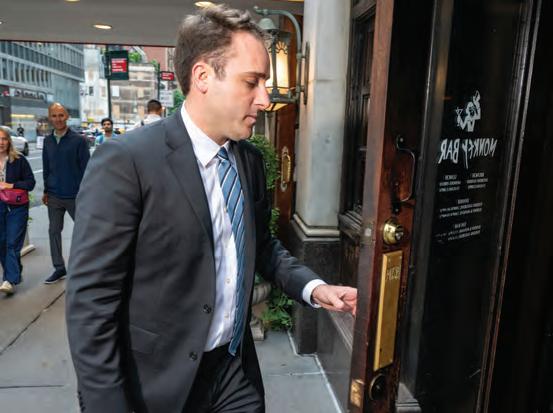
5:15 to 5:30 p.m.
After responding to the deluge of emails, Fenmore leaves his office for a business dinner with Peter Griesinger, who joined CBRE’s institutional debt advisory team in May after six years at Newmark, where he facilitated a number of large multifamily loans. Fenmore has struck up a close relationship with Griesinger in his short time at the firm, and he converses with his new teammate during the half-mile walk to the Monkey Bar on 54th Street.
“He’s bringing strong multifamily execution expertise from Newmark where he was focused on agency and other multifamily loans,” said Fenmore of Griesinger. “His background gives the team experience that will give us the competitive edge in executing multifamily transactions.”

5:30 to 7:30 p.m.
Fenmore and Griesinger arrive at Monkey Bar at 5:30 and walk past the darkly lit bar area toward the back dining room to grab a table for four. A few minutes later, Ryan Naumes and Emmy Cross from Barings arrived to kick off a drinks and dinner outing that features deal talk combined with lighthearted conversations on various topics.
“We’re in the process of closing a couple of deals with Barings, and it’s good to catch up during those processes,” Fenmore said. “Industry connections and friendships are the main reason I joined the industry, and CBRE has given me the platform for building meaningful relationships with clients and lenders that are important for my team and personal success.” Fenmore heads home at 7:30 p.m. and typically hits the hay around 11, although sometimes he works later so he can hit the ground running the next day.
By Tom Acitelli, Julia Echikson, Larry Getlen, Max Gross, Amanda Schiavo and Nicholas Trombola | Photograph by Chris Sorensen
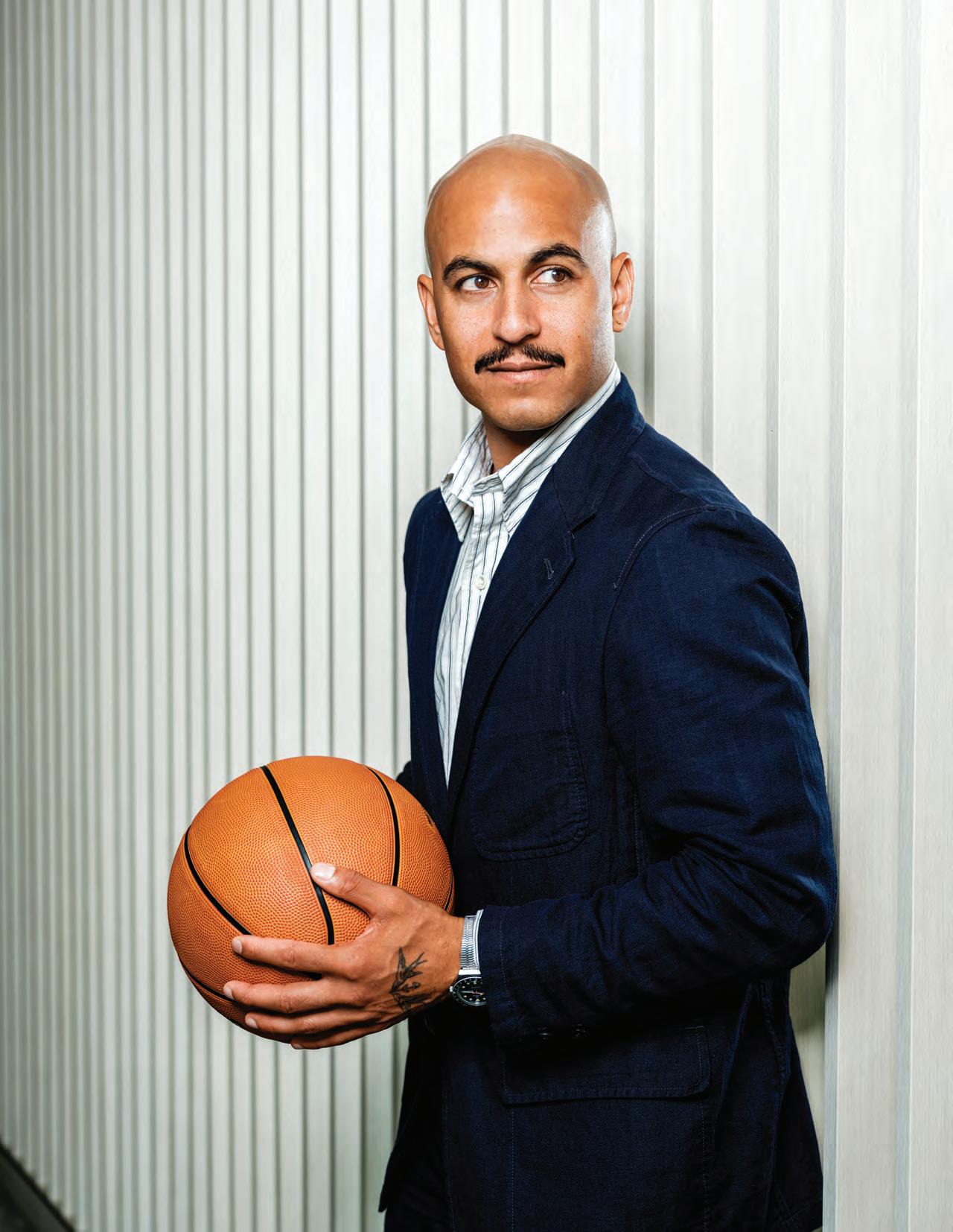
Tyler Winograd.
Alexander Aghravi, 30
Senior project manager at the Moinian Group
Alex Aghravi landed a job at the Moinian Group after graduating from Penn State University in 2016, and was thrown into the deep end almost immediately.
Aghravi’s first project at the firm — one of the country’s largest privately held real estate investment companies — was to help close out the development of Sky, Moinian’s 71-story, 1,175-unit multifamily behemoth in Midtown Manhattan. Roughly 20 percent of the building was leased at the time, but Aghravi’s job was to evaluate the remaining work of every other unit, one by one, to get them across the finish line.
“I used to take an elevator from the lobby to the top floor and walk down the stairs of the entire building, go in every single unit, and update progress,” the Long Island native said. “Oh, this one is missing a vanity, the floor needs to be repaired, the fridge isn’t working — a complete punch list. So I know the ins and outs of that building.”
These days, as a senior project manager, Aghravi leads ground-up and redevelopment projects for Moinian, as well as capital improvements across the firm’s roughly 3,000-unit New York City residential portfolio. Aghravi has focused more recently on office-to-resi conversions. That includes altering about 80,000 square feet at 90 John Street into 114 residences, a project completed in January and now nearly fully leased, as well as reconfiguring 100,000 square feet at 17 Battery Place into 138 apartments, which Aghravi said is approaching its occupancy approval. He is currently working on the pre- development phase of another 230-unit conversion project.
“We need more supply on the market, and with the city on board we’re making a major push to solve the housing crisis,” Aghravi said. “It’s really exciting to be a part of that and see these spaces transform from offices into beautiful apartments, and help New Yorkers find a home.” —N.T.
Jocelyn Barahona, 30
Architect at Elkus Manfredi Architects
When Jocelyn Barahona was a little girl, she’d travel between her hometown of Los Angeles and her parents’ birthplace in El Salvador. It was seeing the contrasting characteristics of the homes and buildings in both places during these trips that kindled her interest in architecture.
“No one in my family was an architect at the time, but just being able to see how culture influences the built environment got me curious about the industry,” Barahona said. “That’s really what piqued my interest. Honestly, I was like, ‘OK, clearly lifestyle and architecture go hand in hand.’ ”
In 2021, Barahona joined Elkus Manfredi, where she has mostly been working on research facility projects. One that holds a special place for her is the Boston Children’s Hospital project at 421 Park Drive in the Massachusetts capital. As an architect on this project, she led the fit-out design efforts for its research and laboratory facility and worked closely with the hospital’s research team to ensure all of their needs would be met.
She also advocated for and implemented natural light features in the vivarium procedure rooms for animal testing — an uncommon feature, but one she believes is highly appreciated by the people who work in institutional buildings.
“We’re very lucky to be able to work with Boston Children’s. Working with them is very different from working with a developer,” she said. “It’s really nice that you’re not working on something that’s speculative. It’s based on what their current needs are, and how we can make that happen.”
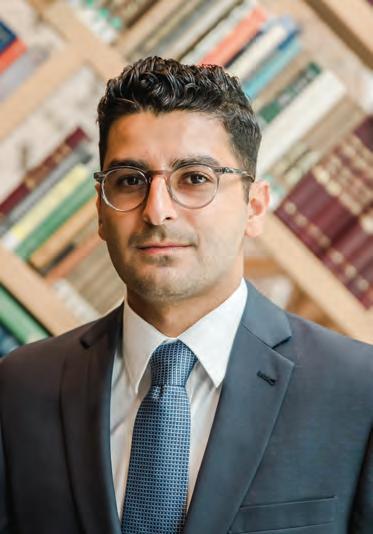
Looking toward the future, Barahona could see herself leading as a principal at a firm, helping to manage the business side, including bringing in new talent and helping shape strategy.
“I would like to be able to be a little bit more influential,” she said. “Not just someone who’s working at a firm, but someone who is helping shape that firm.” —A.Schiavo
Tom Bentsen, 29
Director of engineering at One Madison Avenue for SL Green Realty
Tom Bentsen went big with his job change in August 2022.
He transitioned from the prominent engineering firm JB&B to SL Green Realty, New York City’s largest office landlord. Specifically, Bentsen came on to direct the engineering work at SL Green’s One Madison Avenue, probably the city’s most closely watched adaptive reuse project. Largely completed in late 2023, it included adding a 26-story office building to the address’ 19th century podium.
To this day, Bentsen is responsible for the 1.4 million-square-foot One Madison’s mechanical, electrical, plumbing, fire protection and management systems. His One Madison work also required coordinating with the commissioning provider and construction manager, and their subcontractors, on a pull-the-plug test in June 2024 — that is, simulating over several hours a complete breakdown in energy supply to the tower, whose anchor tenant is IBM and whose other tenants include cryptocurrency exchange Coinbase and cybersecurity firm Palo Alto Networks. (Spoiler: The test went off without a hitch.)
“Now I’m trying to actually make these systems run as efficiently as they can and still hold the contractors from the past accountable for the work, to get that done properly,” Bentsen said.
Meanwhile, Bentsen also works on what he describes as mini-projects — including a dedicated outdoor air system for One Madison and related air pressurization issues
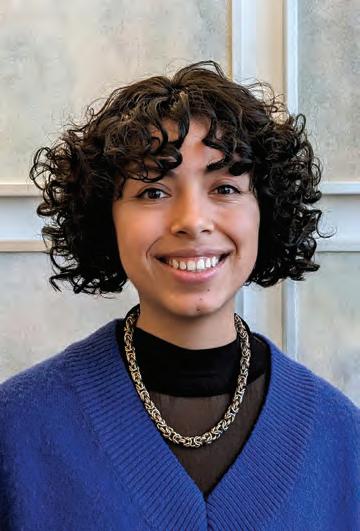

— and responding to any problems that might arise. Bentsen grew up on Long Island, and said he always wanted to work in the big city. He turned an interest in thermodynamics into a mechanical engineering degree with high honors from Binghamton University. His JB&B experience introduced Bentsen to the wider field beyond the HVAC work he was most familiar with. And he said the pandemic, which forced him (and a lot of others) behind a computer more, gave him an appreciation for turning designs into realities — something he can do in his current role.
“For now,” Bentsen said, “I’m really interested in how pen and paper — or computer and software — meet the physical world of our operations.” —T.A.
Alexander Aghravi.
Jocelyn Barahona.
Tom Bentsen.

Samantha Bromberg, 27 Senior environmental planner at STV
Urban environmental reviews are often stressful, highpressure acts. They require coordination with engineers, architects and other permitting teams to make sure that the documentation stands up to legal scrutiny — not to mention public scrutiny. And all of it usually done under tight deadlines.
Samantha Bromberg is no stranger to these challenges. As a senior environmental planner at STV, she has overseen high-profile projects, including the replacement of the Draw One Bridge in Massachusetts. Not only does the commuter rail bridge out of North Station connect two major metropolises, Boston and Cambridge, but it’s also historic and next to busy Interstate 93.
Bromberg had to balance the contractors’ proposed needs and methods while also minimizing the effects on the environment and community. Perhaps most difficult of all, the planning portion of the project had to be done before President Donald Trump took office and could imperil the project’s federal funding.
“There can be pressure, especially when there’s a push to start construction soon,” Bromberg said. “But I like high- intensity jobs.”
Despite all the hurdles, the replacement project is proving to be a success — or, at the very least, Bromberg’s part is. Last year, the redevelopment won $472 million in federal funding, making it the largest federal award the Massachusetts Bay Transportation Authority has received to date.
Now Bromberg has moved on to her biggest project, which will be in New York. She can’t say much about it, but it’s proving to be exciting because the contractor is coming on board and construction will start soon.
“This is a big one, and one of the projects that’s nearest to construction that I worked on,” Bromberg said. “On a lot of environmental reviews, you can be planning for years before a project is ever constructed and there are boots on the ground. It’s nice to see a project through to completion.” —J.E.
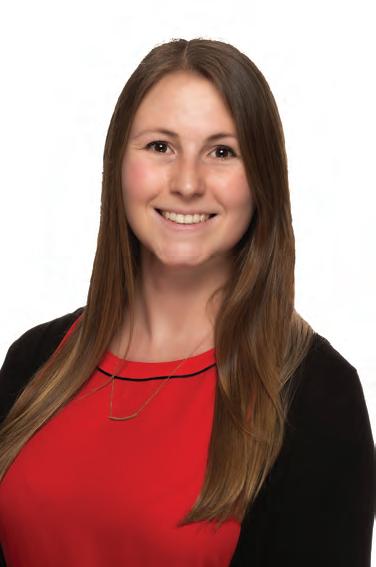
Colette DiLauro, 33
Senior project engineer at Langan
What are you doing for July 4th weekend?
That was the question Colette DiLauro’s London-based supervisor asked her a few years ago. It was June, and she didn’t have anything special in mind.
I don’t know, she answered.
Do you want to go to Greece? her supervisor asked.
Yeah, she answered. I have no other plans.
Of course, her boss wasn’t inviting her to a really, really inconvenient Fourth of July barbecue. Rather, DiLauro was gearing up to take on the development of a 300-acre park that needed stormwater systems and green infrastructure.
“My view was: take this challenge head on,” DiLauro said. “I’ll take anything head on. The bigger the challenge, the more rewarding when you get through the project.”
The challenges were definitely there. “In Greece, all their infrastructure was 500 years old. They had no infrastructure for stormwater. They were very skeptical. I had to make them comfortable with it.”
Naturally, a Greek engineering job is an exotic assignment for a Westchester County native who now lives in New York City with her husband (who’s also an engineer, and whom she met by the watercooler on her first day at Langan), but DiLauro might have a better one: She’s currently waking up at 6 a.m. for meetings on a soccer stadium in Saudi Arabia, where she is the project lead on a 10-person team.
“Civil engineering is consistent throughout the world,” DiLauro said, “but the way people communicate is different. You have to be persistent in getting answers. Maybe people don’t want to feel so pushy — but ... it helps out not just our teams but the project as a whole.”
One shouldn’t think that the Lehigh graduate is only about international jet-setting. She has done projects closer to home, too, like the Resorts World casino in Jamaica, Queens. “I feel comfortable in New York. I know what to expect.” —M.G.
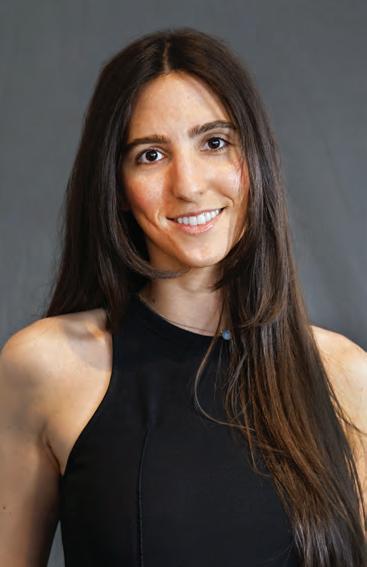
Dana Gamliel, 30
Project manager and project architect at HLW
Growing up, Dana Gamliel knew she was destined for a career in architecture. She was always artistic and was raised in a household of engineers, after all.
Gamliel has been working for HLW for two and a half years, and has managed projects in the multifamily and adaptive reuse spaces. She also helped the car wash brand Mojo — which says it’s on a mission to redesign the car wash experience — create a customized look to help spread a cohesive message at all its locations.
For Gamliel, building connections with the clients she works with is a critical component of what she does.
“I’m really driven by relationships. I like to surround myself with smart, forward-thinking people, and so I applied that to the workplace,” she said. “I started seeing that back at me through the different clients we work with, the project types I was exposed to, and I found a really great place to apply those skills and that part of my personality in project management, as well as managing client accounts, working with other architects and designers, and collaborating with other engineers and consultants.”
All of those minds and personalities bring different perspectives to a project, she said, which is part of the fun of the job. The result of these minds coming together to see a tangible result of their hard work is something special, she added.
The “pride and joy” of her career so far is the Mojo car wash project, Gamliel said. She got to bring Mojo’s new brand identity to life. She designed an “architectural kit of parts,” which Mojo rolled out across its more than 150 locations. This kit consisted of a mix of elements, including new construction, retrofitting and adaptive reuse.
“There’s a few of [the car washes] being built right now, and that’s a great feeling,” Gamliel said. “This was also a really long client relationship that I had owned. So I feel very, very connected to them, and connected to their mission and what they’re doing.” — A.Schiavo
Samantha Bromberg.
Colette DiLauro.
Dana Gamliel.
Maggie Giaccone, 33 Senior associate at TPG
Maggie Giaccone likes to tell stories. Not in images, film or text — but in real estate. The senior associate at TPG draws up offices with flair. Just look at the offices of the French spirits company Remy Cointreau in New York’s Midtown.
Giaccone designed Remy’s U.S. headquarters to look like “its own cellar,” Giaccone said. “The team at 3 Times Square is just as important as the true cellar masters because they are the people who market the product and get it on shelves.”
And Giaccone delivered. She, along with her team and the client, created an elevator lobby where the ceiling curves to resemble an underground bottle cellar. Once inside the office, they added white Venetian plaster to contrast.
“This client is very proud of its heritage and brand, and wanted to build this story along with me,” Giaccone said.
Another example is Clear. When the biometric travel company moved to Chelsea, Giaccone applied a similar ethos. The company, whose ID-confirming kiosks are stationed in major airports, wanted a space that would be minimal and frictionless to reflect its brand.
Giaccone and her team placed dichroic glass in the lobby, which can display different colors depending on the lighting. The design feature functions not only as a physical manifestation of the company’s name, but also reflects the sky’s different colors. They also added C-shaped lights above a staircase to resemble the Clear logo.
“Design is like a puzzle,” Giaccone said. “It’s not just the pretty pictures, but about how specific strategies behind planning make something holistic and functional.”
Giaccone’s love for design dates back to her childhood. “Growing up, I’d attempt to redesign my room and then ask my mom if I could redecorate our bathrooms. I just wanted to create.” —J.E.
Samantha Kane, 34,
Senior project architect and senior associate at HLW
When most 5-year-olds are handed some Legos, they’ll usually create planes, cars or animals. Not Samantha Kane. At 5, the future architect knew exactly where she’d be in 30 years, having built an entire apartment out of Legos.
“[At the time] I thought, ‘I want to make buildings,’ ” she said, “and I have just genuinely never changed my mind.”
Nothing would deter her from that goal, not even the advice of some architects who visited her high school — which had a drafting and architecture program — telling her it was a tough pursuit thanks to long hours that allowed for little social life and even less sleep.
“There was a real mindset in the industry [at the time], and especially in school, that you had to work 24/7, and, if you’re not staying up all night, you’re not doing enough,” she said. “That was kind of a culture shock. I think if I hadn’t been warned about it, it would have been even more of a shock.”
Armed with that warning, she vowed to approach her architecture career differently.
“Do everything at your own pace,” she advises people. “When it came to getting my license, I felt that this advice was really helpful. There’s no [rule that] you have to do it by this day.”
Throughout her career, Kane has worked on some exciting projects. These include the 100,000-square-foot
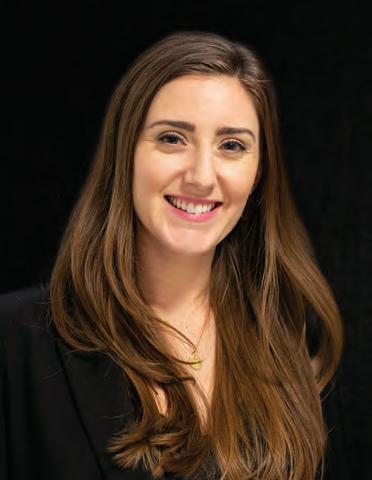
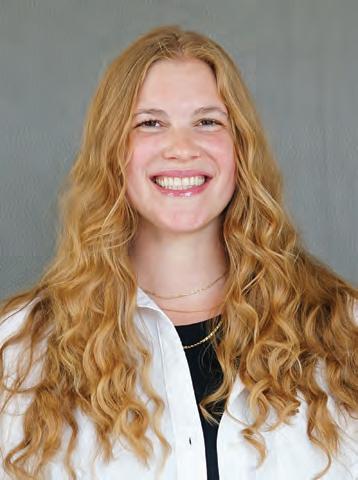
rebuild of the North American headquarters of Japanese conglomerate Kyocera in Fairfield, N.J., and the 306,000-square-foot headquarters project for Eisai, an oncology- and neurology- focused pharmaceutical company.
But the pride and joy of her work so far has been the buildout of audio book company Audible’s office in Newark, N.J.
“It was years ago at this point, but it felt like a turning point in my career,” Kane said. “It was the first time I really felt ownership over a set of construction documents. It was right after I got my license. It was the first time I was handling the process totally on my own.” —A.Schiavo
Lexie Mayewski, 30 Project manager at MGAC
The concepts of empowerment and community are key for MGAC’s Lexie Mayewski.
Mayewski was inspired to enter a STEM field from an early age. When she was 10 years old, at a Girl Scouts event, Mayewski was told that the world needed more women in engineering. It really was that simple — she believed she could, so she did.
“I was like, ‘That sounds great. I’m going to do that,’ ” the Catholic University alum said.
Following a roughly two-year stint as a project engineer for the Whiting-Turner Contracting Company and about three years managing projects for CBRE, Mayewski transitioned to a project manager role at MGAC, a boutique construction and development consultant based in Washington, D.C. Mayewski focuses on historic preservation and restoration projects within the education space, which she simultaneously finds challenging and rewarding due to each property’s unique quirks and the impact those restorations have on the local community.
“What really drives me is the community factor and helping others connect easily with one another,” Mayewski said of the immediate impacts of modernizing old academic properties. “We’re renovating a building from the 1920s, bringing it up to speed with today’s technology, today’s best learning environments, but with a historic building. I really love the notion that we don’t
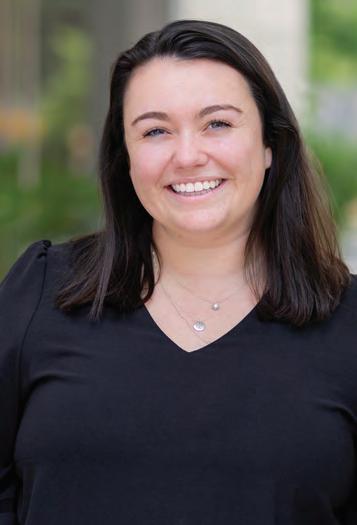
have to knock down old buildings. We can really restore them to their full glory.”
Mayewski recently led the $97 million restoration of D.C. Public Schools’ John Francis Education Campus, a 110,000-square-foot academic property built in 1927. She also led the $63 million renovation of the 1920s-built Raymond Elementary School in D.C.’s Petworth neighborhood as well as the development of a new, roughly 371,000-square-foot residential and dining building at the University of Maryland.
Mayewski is passionate about lifting up others in her field as well. Along with establishing MGAC’s Women’s Initiative Network, she’s also on the board of the Catholic University Alumni Association and the school’s Construction Advisory Council, as well as on the board of directors for Women in Construction. —N.T.
Samantha Kane.
Lexie Mayewski.
Maggie Giaccone.

Peter Mon, 27
Assistant project manager at
Skanska
Peter Mon’s formidable career trajectory started modestly. The Long Island native worked on sites as a laborer after high school.
“I realized at that time that construction was my passion,” he said.
So he switched up his focus at Farmingdale State College to study construction management engineering technology. He finished his degree in December 2019, while simultaneously working for a contractor on a New York City Department of Transportation project along Riverside Drive. Mon jumped at an opportunity to join construction giant Skanska in a Boston-area role in 2020.
His work there — first as a project engineer and, since a March promotion, as an assistant project manager — have included major infrastructure projects. Mon was part of the construction of a new mass transit rail stop in the Boston suburb of Brookline, work for which wrapped in early 2022 and was connected to Skanska’s expansion of a nearby high school.
Mon was also an engineer on one of the bigger transportation projects in Massachusetts in ages. The South Coast Rail project unspooled a direct commuter rail link between Boston and New Bedford, Mass., roughly 37 miles away, for the first time since 1958. The first train rolled out in March.
Now Mon’s main day-to-day work is on Route 146 between Providence and Worcester, Mass., where Skanska is tasked with making a 16-mile stretch that tens of thousands of automobiles traverse daily safer and less congested. As assistant project manager, Mon has a wide remit. That includes managing crews, including subcontractors, as well as the undertaking’s schedule. Plus, Mon has a say in the cost of the work — and one more thing that he says he is particularly pleased about and with which he hasn’t normally been involved.
“We’re responsible not only for building the project but also designing it,” Mon said.
The Route 146 project is scheduled for completion in summer 2026. After that, Mon said he wants to tackle similarly variegated work, including coordinating directly with project stakeholders. —T.A.
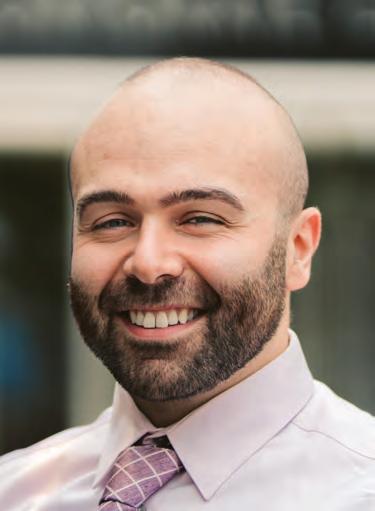
Robert J. Nilsen, 28
Project Designer at H2M Architects + Engineers
Robert J. Nilsen is on his way up — quite literally.
The Staten Island native, who did his undergraduate work at Rensselaer Polytechnic Institute and graduate work at Harvard, is currently revamping hundreds of elevators around Gotham for the New York City Housing Authority.
“I’ve come to love it,” Nilsen said. “It’s oddly specific, but that makes it more interesting. You’d be surprised how many common misconceptions [there are about elevators]. That they’re scary. It’s like a black box. But there are so many safety mechanisms — it’s safer than escalators.”
Nilsen is involved in everything from design, to permitting (he reviews the relevant codes and ensures buildings are compliant), to construction sets on this big NYCHA project. But Nilsen’s career history is not limited to elevators, despite his fondness for them. Back in 2021, Nilsen also helped turn Midtown’s Lord & Taylor building into Amazon’s New York City headquarters.
“That was ultimately the biggest project,” Nilsen said of what he’s worked on. Collaborating closely with the city Landmarks Preservation Commission, he helped restore the building’s Italian Renaissance Revival cornice and other parts of the exterior.
“It exposed me to working with existing conditions. What really shaped me from that project — working on such an iconic building — was there was so much attention to refining and refurbishing,” he said. “I didn’t really understand historic preservation — how much effort goes into it, and the predetermined methods of repair. In school, a lot of what you do is hypothetical new construction. But a lot of my career, thus far, is working on existing construction and repairing it.”
Nilsen credits his grandfather, a welder who worked for the city’s Sanitation Department, for sparking his interest in this crossroads of construction, engineering, civic projects and design. His grandfather mentored a number of people at the department, one of whom went on to teach Nielsen how to weld.
“In his spare time he liked making sculptures,” Nilsen said of his grandfather. “If it’s genetic, it was transferred to me. I have a tattoo of a flower he made.” —M.G.

Pamela Iriarte Noya, 28
Associate architect at STV
Between the summer of her junior and senior years of high school, Pamela Iriarte Noya started calling architecture and design firms.
She lived in a small town in Georgia — having been born in Bolivia and grown up in Miami — and decided to ask the local architects if they needed help around the office from a cheap (read: free) and eager student. “Architects really like to deter students,” Noya said. “They tell you about the exams, and the five years of schooling, and the internships.” In Noya’s case, they didn’t even get as far as issuing the warning. Nobody was interested. So she set her sights higher and began calling firms in Atlanta.
“One firm said, ‘Sure, come on in a few days a week,’ ” Noya said. She would bus to Atlanta two or three days a week and soak in what she could. When it was time for college, she went to the Pratt Institute’s five-year architecture program.
With that kind of patience and dedication, it’s no wonder she wound up as an architect at STV, and within six months was promoted to associate architect.
Since coming to STV, she has designed the flood protection for the Metropolitan Transportation Authority’s maintenance yards, produced the schematics for the Baltimore Therapeutic Treatment Center (price tag: $817 million), and led the design improvements on 12,000 square feet of the front-facing customer service space at Moynihan Train Hall, adding more seating and increasing the efficiency of the staff areas.
“We were able to use VR technology,” Noya said. “We have a visualization team. I really worked closely with them to create these options.”
Most recently, Noya has been working with the Massachusetts School Building Authority to assess the condition of some 1,580 schools in the state and make mechanical, structural, electrical and architectural recommendations.
As for the future? “I would love to design spaces for communities — libraries, museums,” the Astoria, Queens, resident said. “I like a good building where the public is invited to come in.” —M.G.
Peter Mon.
Robert J. Nilsen.
Pamela Iriarte Noya.
Scott Rubin, 32 Senior associate at Cerami & Associates
Driven by a passion for music and engineering, Scott Rubin has spent his 11-year career working as an acoustical engineer at Cerami & Associates, helping architects and developers understand how sound will impact their buildings and the business conducted within them.
“The beauty of that is it allows you to use both sides of the brain and it is also a more creative engineering, and allows us to play around with architecture and design but also think logically about solving certain engineering problems,” Rubin said. “It allows me to pursue both passions.”
That ability to combine the science of engineering and the creativity of sound design helped Rubin (and his firm) in the development of the Walt Disney Company’s new New York City headquarters at 7 Hudson Square. The space houses not only some of the company’s corporate employees, but is also where long-running talk show “The View” and other Disney and ABC productions are taped.
In addition to the noisy backdrop of New York City, 7 Hudson Square sits over a subway, which added another acoustical challenge to its development.
“Those different studios are actually in the basement of the building,” Rubin said. “So the most sensitive room is next to the loudest noise source. So we had to figure out how to isolate the building from the subway.”
Isolating a building from a loud city comes down to understanding the environment through site studies and using materials such as rubber, neoprene — a synthetic rubber that is more durable — and springs, he said. “Those types of materials absorb the sound or the vibration, and it absorbs it and doesn’t allow it to transmit from one material to the other,” Rubin said.
The Disney project was just one unique development Rubin has worked on. He was also part of the team on 270 Park Avenue, set to be the new global headquarters for J.P. Morgan Chase.
Going forward, Rubin has his eye on a certain career prize. “My personal Everest is to become a leader at the firm,” he said, “and have my own group, and really be at a leader level, which I am close to.” —A.Schiavo
Daniel Russo, 33
Project manager at Douglaston Development
Imagine a knock on your door. There’s a young guy in a suit with an offer too good to be true: Let us renovate your apartment for free to improve your living conditions.
But when Douglaston’s Daniel Russo is the one knocking, you can be sure it isn’t a con.
Setting out on his career, Russo knew he wanted to work in housing and provide people with high-quality, safe and — especially — affordable places to live. One way he is able to do this is through occupied rehab projects, which involve going into units where people are living and renovating around them. He said it is a rewarding field, but sometimes frustrating.
“There’s a tremendous amount of distrust because folks have been living in poor housing conditions for such a long time,” Russo said. “And then we come along and say, out of the goodness of our hearts, we’re going to make your housing conditions dramatically better, and there’s going to be no ask of you as a resident. There’s going to be no raises in your rent. You’re going to get to stay here. And people don’t believe you.”
One such project Russo and the Douglaston team are working on is the revitalization of the Sack Wern Houses in the Soundview section of the Bronx. About 800 residents live in 411 units on this 5-acre campus. It is an ongoing

process, but Russo believes in maintaining effective communication throughout to create a positive relationship with the residents whose homes you are entering.
“It can be frustrating because some people just don’t trust you, and they have plenty of good reasons not to,” he said. “They’ve been sold things that sound too good in their housing conditions for a long time. But that project is about 11 months into construction. At the start, we tried to democratize the process across the board … so residents would have input. And then see some of those decisions actually come and be materialized in their units.” —A.Schiavo
Sigal Shemesh, 31 Sustainability lead at SOM
Construction isn’t necessarily an environmentally friendly industry. After all, by many estimates, the sector contributes to about 40 percent of total global greenhouse gas emissions. But Sigal Shemesh is trying to change that as a sustainability consultant.
“I influence architectural design to be the most optimized that it can be from a sustainability standpoint,” Shemesh said. “So, when our architects design a building, is it the best version to reduce the amount of carbon?”
Thanks to her work at SOM, one of the world’s most prominent architecture firms, she’s already got sizable projects to tout.
Take a university building in the Middle East. Architects had drawn up an oblong-shaped building. Shemesh convinced them to rotate the structure east to west. The change reduced the solar exposure by about 60 percent, creating a more energy- efficient building.
“Just by literally moving the building, you’re able to have a really subtle impact on design, but have a really drastic impact on reducing energy consumption,” Shemesh said.
Back in the New York area, she convinced clients the Edelman Fossil Park & Museum and the New York Climate
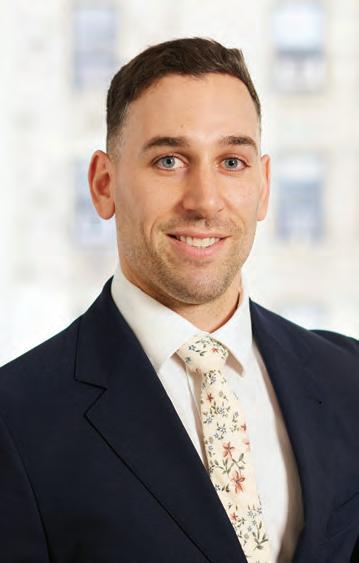

Exchange project on Governors Island to seek the Living Building Challenge, one of the most aggressive and aspirational sustainability certifications.
“The clients already had super-high [sustainability] aspirations, but didn’t really know how to highlight that to the public,” Shemesh said. “I was able to reframe the pursuit of the Living Building Challenge as the best showcase of their own aspirations.” (The park has secured the certification.)
Her work is sure to proliferate. She’s teaching classes at Columbia University, her alma mater, and New York City College of Technology. “It’s something that I’m proud of,” Shemesh said. “It’s a bit of a milestone.” — J.E.
Scott Rubin.
Daniel Russo.
Sigal Shemesh.
Shuo Tang, 33
Project architect at Fogarty Finger
Shuo Tang developed a love for architecture in his native China before earning a master’s in advanced architectural design from Columbia.
“Growing up, I could see construction and development all around me,” said Tang. “That really excited me, and I wanted to get involved in this process. There are so many different kinds of geometry and design in architecture. It’s something I always appreciated, from European churches to more contemporary styles.”
Tang received his undergraduate architecture degree from Zhejiang University in Hangzhou, China, and did architectural internships at Naturalbuild in Shanghai and !Melk in New York before joining Fogarty Finger in 2018.
One major project Tang has worked on for Fogarty Finger is Nevins Landing, a 621,400-square-foot, mostly residential project in Gowanus, Brooklyn.
Tang emphasizes several design elements intended to bond the project to the surrounding community. Given the vast amount of space on the property between its two towers, an arcade was designed — think arches, not video games — as a community gathering space. And several of the building’s architectural elements were intended to recall the area’s deep industrial history.
“We always create tenant-friendly buildings, but for this we wanted to go a step further to create a neighborhood- and community-friendly building,” said Tang. “We also wanted to respect the famous industrial history of Gowanus. There are a lot of art elements in the historical buildings there. We wanted to bring that element into our building. So you can see arch windows for the residential units, and an arch storefront on the ground floor.”
Tang has also worked on Hanover House, a 34-story mixed-use project in Downtown Brooklyn.
He looks forward to continued innovations with more projects that enhance communities.
“Things develop so fast that I can’t even imagine what the world will be in five years, especially with AI,” said Tang. “I want to continue with the company’s design philosophy of being tenant-friendly, community-friendly and also developer-friendly, and I don’t want us to repeat ourselves. We want to have innovative elements in every building we design.” —L.G.
Alexandra Teniuch, 28 Structural engineer at DeSimone Consulting Engineering
Alexandra Teniuch woke up one morning to discover she no longer wanted to be a doctor. The idea of sticking people with needles and cutting them open gave her the heebie-jeebies. So she pivoted into the world of structural engineering, where she could focus her love of physics and calculus on creating extraordinary things.
“I had a really wonderful physics teacher in high school who pushed me my junior and senior years — when I was trying to figure out what would be the best career path for me given my skill set — to pursue engineering,” she said. “If you had told me at a very young age that I was going to be an engineer, I probably wouldn’t have thought so.”
But after graduating from Northeastern University in 2019, she joined DeSimone Consulting Engineering, where she has provided high-level structural analysis, drawing review, fabrication and coordination for some of the company’s most impressive projects.
Those have included the Olympia residential tower in Dumbo, Brooklyn. Teniuch served as a key member of the structural design team for the building shaped like a billowing boat sail.
“That was actually one of my first projects when I started at DeSimone,” she said. “The floor plates actually not only grow smaller as you go up the building, but it kind of twists to create that exterior profile going up like the bow of a ship.”
Managing the complex loads that came along with the Olympia’s curved form and step-and-turn profile was a challenge that required novel solutions. Tenuich worked with the structural team to supplement the traditional vertical column style with sloping columns that were positioned along the building’s height. This innovative approach balanced the divergent load distribution that was caused by the building’s shape, ensuring a structural stability that also met the architect’s original vision.
“I like the relationship between architect and engineer,” she said. “I sometimes think that the architect pushes the envelope, which puts the engineer out of their comfort zone. But, then, that in tandem gives you a really beautiful end product.” —A.Schiavo

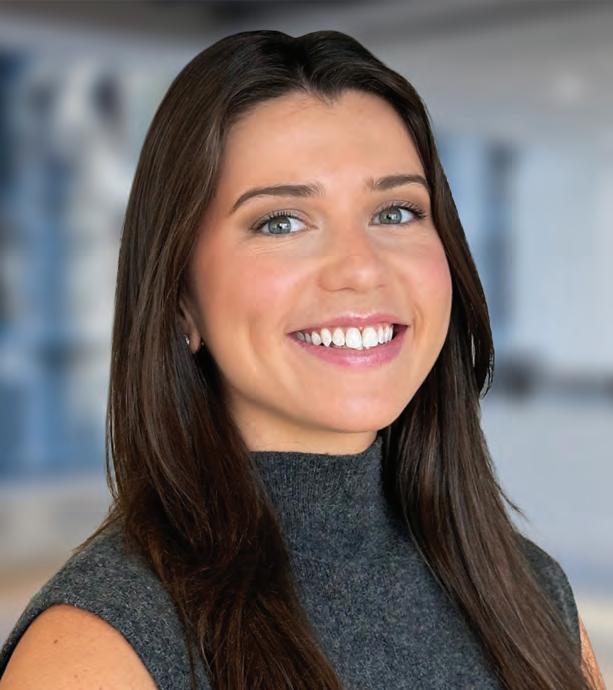
Shuo Tang.
Alexandra Teniuch.
Joe Trumbetti, 31
Project manager in construction and development at RXR
Joe Trumbetti believes in being a jack of all trades.
The New Jersey native began his career as a civil engineer, joining AECOM Tishman not long after earning a master’s from Johns Hopkins in 2017. Three years at Tishman exposed Trumbetti to skyscraper construction in Manhattan, but something was missing. He eventually realized that engineering wouldn’t necessarily expose him to less technical, “softer” skills in the design and building realms.
So, Trumbetti transitioned to a whirlwind design-build manager role at ARCO. Experiencing a project “from cradle to grave,” he said, flicked on the developer’s lightbulb.
“I got exposed to the entire development life cycle, and that’s what got me hooked,” Trumbetti said. “I realized there’s so much more to it than just bidding a job, getting a contract, scoping out the work, awarding it, managing it and turning it over. There’s a whole life that happens before and after that.”
Trumbetti is currently a project manager for RXR, where he leads development construction services on more than $700 million of ground-up development, and supports another $400 million in the pipeline. Two of his current major projects include Ave Hamilton Green, an 850,000-square-foot, mixed-use development in White Plains, N.Y., and a new, 17-story headquarters in Downtown White Plains for the New York Power Authority.
Trumbetti says he loves watching a project grow from its infancy, an experience made all the more visceral thanks to a 16-month-old son at his home in Westchester County.
“Being involved in projects from the earliest stages to the later stages helps you to be a more well-rounded developer, in my opinion,” Trumbetti said. “A lot of considerations that are made during design, during construction, are sometimes made in a vacuum. Having been involved in the process, from acquisition all the way to disposition or occupancy, you learn about a lot of the consequences of some of those decisions, good or bad. … It helps you be a better decision-maker, in my opinion.” —N.T.
Tyler Winograd, 34
Studio director at Gensler
Tyler Winograd’s design philosophy was shaped in part during his tenure with Danny Meyer, when Winograd served as a marketing project manager for Meyer’s Union Square Hospitality Group.
“I led efforts around new concepting for restaurants and bars. Danny had an idea, and we brought it to life by hiring branding agencies, architecture firms and other design- adjacent groups,” said Winograd. “That’s where I first started interacting with the design of the built environment, and what it meant to bring ideas to life conceptually. It’s where I realized that I wanted to be on the creative side of this business.”
At Gensler, Winograd leads the retail and consumer experiences practice, heading a team of strategists and designers in conceptualizing physical environments that elevate consumer experience and business results.
Winograd leads retail and consumer experience for clients such as Adidas, CVS, Mars, J.P. Morgan Chase and RXR. He drove the effort on the reimagining of Claire’s, leading research and design on the chain’s “Store of the Future” proto- type, which reinvented its branding and which has become the highest-grossing store in the chain.
He also worked on the new SoHo flagship store for the Eric Emanuel clothing brand, a retail outlet designed as a
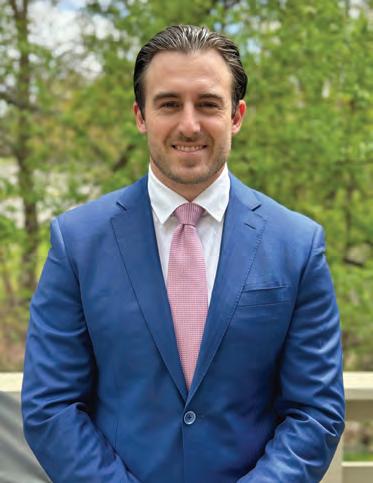

sculpture gallery that blends retail features with an exhibitory bent. Winograd cherished the project for its supersized impact.
“Eric Emanuel represents an amazing partnership,” said Winograd. “It’s a boutique retail brand that is super hot right now, pushing the conversation around the design of both their products and their stores. That’s probably been our most impactful project this year, especially for the conversation around retail design in New York.”
Winograd looks forward to the Gensler studio continuing having a stage-setting impact in retail design and consumer experience.
“I would love to be a leading voice in the lifestyle design conversation,” he said. “I want to grow this studio not just by numbers or revenue, but by creating the most impactful, conversation-leading retail design studio I can.” —L.G.
Carolina Zapata, 34
Senior project manager at Shawmut Design and Construction
Carolina Zapata feels as though she has a “degree in quirks.”
The New York-based Zapata specializes in historical restoration work for Shawmut. She has led, or contributed to, projects for the Metropolitan Museum of Art, Saint Ann’s School, Columbia University, the Buckley School and New York-Presbyterian Hospital, among others. What makes the work compelling, Zapata said, are the unique problem-solving challenges that each restoration project commands.
“My job is to manage the quirks, understand which are more detrimental than the next, and just assess risk and bring all teams together,” Zapata said. “Every day you may find an existing chase that was buried behind a wall that’s not represented on any drawing because it hasn’t been touched in 100 years. … Those are the kinds of things that excite me — buried artifacts, and just understanding how they built things back then, and quite literally tying in those old construction methods to the methods that we use today.”
One of the biggest projects of her career so far exemplifies that style of singular work. Zapata and her team were responsible for the restoration of the Church of
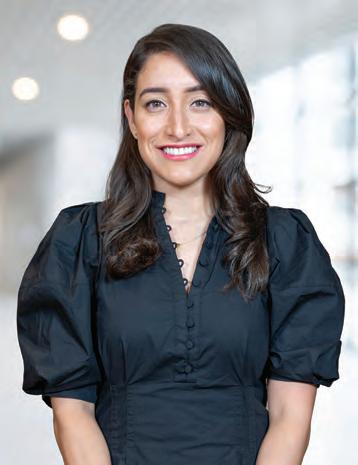
the Epiphany on New York’s Upper East Side, a roughly 180-year-old complex which spans some 29,000 square feet. The sheer amount of work is daunting on paper, let alone in person: new mechanical, electrical and plumbing infrastructure, façade restoration, circulation core with a new elevator and stairwells, installing an organ and sound system, just to name a few. The project was completed in May 2022, despite pandemic delays — and the team discovered an unexpected flue that altered its structural understanding of the project.
“The architects, structural engineer and my team just did a really great job problem-solving on the spot,” Zapata said. “Working with our subcontractor, we were able to advance that as quickly as possible … and I think that just comes from my company’s experience in doing this type of work.”
With a bit of prompting, Zapata admitted that her work is sometimes akin to archaeology.
“I’m not going to update my email signature, but I think it is very similar,” she said, laughing. —N.T.
Joe Trumbetti.
Tyler Winograd.
Carolina Zapata.
Publicy & Privately in Partnership
Experts at a CO forum remind us that NYC’s biggest and most transformative projects usually involve collaboration
By Amanda Schiavo | Photographs by Greg Morris
artnership, resilience and support were just a few of the themes at Commercial Observer’s Infrastructure and Public Projects Forum, held June 11 at City University of New York’s Graduate Center Recital Hall.
Hosted by Natalie Sachmechi, an associate in the nonprofit education and government practice at JLL, the forum brought together experts from across New York City for discussions on critical design and construction projects that are reshaping the five boroughs through public-private partnerships.
“These partnerships are the heartbeat of our city, and they’re the heartbeat of New York’s transformation,” Sachmechi said as she opened the event. “When you think about public-private partnerships, think about beautiful new airport terminals, the development of One Vanderbilt, the new Grand Central Station, Long Island Rail Road, the renovation of Penn Station, the High Line, Hudson River Park — all of these things.”
Panelists at the forum discussed newer projects than what Sachemic listed, including the revamp of terminals and other parts of John F. Kennedy International Airport, the planned Port Authority Bus Terminal, the progress of some all-electric buildings throughout the city and more. These projects are the envy of other cities, according to Carlo Scissura, president and CEO of the New York Business Congress
“I was talking to a friend of mine — I won’t mention which city she lives in — but she said, ‘We just want one of your projects, just one would transform our city,’ ” Scissura said. “When you are thinking about the things that are happening … it’s a moment in our history that is transformative.”
The JFK and Port Authority projects took center stage at the forum. But before the different panelists covered those projects, Brian Gardner, chair of the construction services department at Cole Schotz, introduced Thomas Foley, commissioner of the city’s Department of Design and Construction, to talk about some smaller projects from around the city.
These projects include the Orchard Beach Maintenance and Operations
Building in the Bronx, and the Shirley Chisholm Recreational Center in Brooklyn, which features a swimming pool that was designed and constructed by the same team that did the swimming pools for the last Olympic Games in Paris.
Following Foley’s remarks, a panel came together to discuss the JFK and Port Authority projects. The speakers were Omar Alrawi, project director of New York Aviation Group; Justin Ginsburgh, managing director of infrastructure properties and development at JetBlue; Maria Martinson, executive vice president at AECOM Tishman; Jacquelene McCarthy, director of aviation redevelopment at the Port Authority of New York and New Jersey; Palmina Whelan, capital program director at the new Terminal One at JFK; and Sharon Novak, president and CEO of electrical contractor Electra USA
The Terminal One project at JFK is part of the Port Authority’s $19 billion undertaking to revamp the airport, which Novak called “the entrance into the city.” It takes a lot of collaboration between public and private entities to get an undertaking of this magnitude off the ground — pun intended.
“The relationship between the Port Authority as a private entity and our airline partners, our private developers, et cetera, is a complex one,” McCarthy said. “We need to make sure our expectations between [all] groups are clearly communicated throughout that process. That means having recurring meetings making sure that there’s our [public works] or that there’s performance criteria that’s clearly understood by both parties.”
It is expected that the Terminal One project will be completed by 2030 and be the largest terminal at the airport, with 23 gates and more than 300,000 square feet of retail. But JFK isn’t the only “triple P” project the Port Authority is working on.
The Midtown bus terminal — described in its current condition by Gov. Kathy Hochul as a “hellhole” — is undergoing a $10 billion revamp that will accommodate larger buses and a greater number of them, and make the entire facility more accessible and aesthetically pleasing.
“The current bus terminal is kind of like a fortress, trying to keep the invading armies of I don’t know who out, but it’s not welcoming,
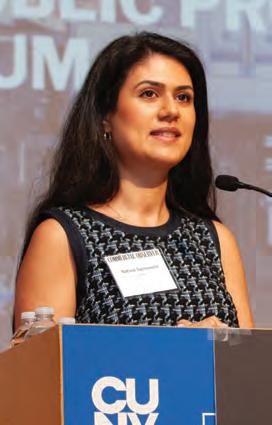
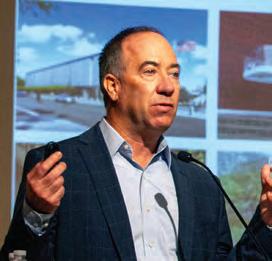
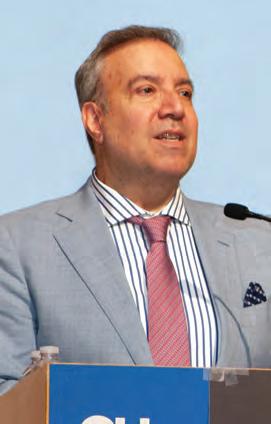



MIND YOUR PPP’s AND Q’s: Industry experts gathered at City University of New York’s Graduate Center Recital Hall on June 11 to discuss the design and construction projects that are transforming New York City’s five boroughs today, including the Port Authority Bus Terminal and JFK Airport.
Natalie Sachmechi.
Thomas Foley.
Carlo Scissura.
Palmina Whelan.
From left to right: Jonathan Gouveia, Michael Kornspun, Matthew Rooney, Richard Roberts and Rick Gropper.
Jamie Torres-Springer and Sheila Pozon.
and it’s not attractive to the local residents,” Hersh Parekh, deputy chief of intergovernmental affairs for the Port Authority, said during a fireside chat with Sheila Pozon, partner with Herbert Smith Freehills Kramer. “So we’re also going to be looking to make this terminal meet the needs of the community.”
(Pozon also moderated a chat with Jamie Torres-Springer, president of Metropolitan Transportation Authority Construction & Development.)
The inclusion of minority- and women-owned businesses (MWBE) on these and other projects was another key theme of the forum, another facet of the public-private partnerships that city government can help enhance.
“I’ve worked for some great leaders,” said Michael Garner, chief business diversity officer for the Mayor’s Office of Minority and Women-Owned Business Enterprises “All of them have a commonality, and that is making sure that city and state contracts are awarded in a way that’s inclusive, but give MWBEs the support services that they need in order to create an environment that’s conducive to their recruitment and their growth.”
Research shows that a diverse pool of collaborators brings together unique perspectives to enhance development.
The forum also featured a panel on how public-private partnerships can collaborate to improve the dreary affordable housing situation in New York City. The speakers were Jonathan Gouveia, chief real estate officer and executive vice president for the New York City Housing Authority (NYCHA); Rick Gropper, co-founder and principal of Camber Property Group; Michael Kornspun, managing director of development for Fairstead; Richard Roberts, principal and chief business development officer for Red Stone Equity Partners; Matthew Rooney, principal and CEO with MDG Design & Construction; and Ashley Dinardo, senior principal at Cozen O’Connor
The discussion focused on leveraging public-private partnerships to develop affordable housing in New York City. By now, New York’s long-standing housing crisis is widely known, but finding a solution is an enduring challenge. Still, each of the panelists’ organizations is working toward creating more affordable housing options across the city, particularly through public- private partnerships.
“NYCHA has historically been looked at as this problem for the city, that certain administrations didn’t want to touch it at all,” Rooney said. “Some people say, ‘Oh, we’ll just throw dollars at it to try to solve the issue.’ But [we have to look] at NYCHA as more of an asset to the city. There is no other source in the city of land that could be used — not even just for housing, but for solving a lot of the other issues that the city is looking at.”
Designing new homes — whether they are affordable or market-rate — requires considerable thought regarding the buildings’ sustainability elements.
And that was exactly the focus of one of the forum’s panels, whose speakers included Robert Goodwin, design principal at Perkins & Will; David McCarthy, vice president with Alloy Development; Michael Reed, director of building transformation at the New York State Research and Development Authority; Jeff Rios, senior vice president at engineering firm WSP; Jessica Waldorf, director of policy implementation for the New York State Department of Public Service; and Kelly Westby, managing director of building operations, decarbonization and efficiency at energy consultancy Steven Winter Associates
The panelists discussed the current and the future state of all-electric buildings in New York, the financing of these projects, as well as the need for holistic collaboration between architects and engineers and the challenges of integrating new systems into existing buildings.
The day wrapped up with two separate discussions on how the New York City waterfront has been evolving. Cole Schotz’s Gardner returned to the stage to chat with Melissa Burch, executive vice president and chief operating officer for the New York City Economic Development Corporation, about the EDC’s efforts to revitalize New York’s waterfront, particularly the Brooklyn Marine Terminal
“Many folks know New York City for its iconic skyline. I would say our waterfront is equally iconic and maybe less appreciated and understood, but we are a coastal waterfront city of 520 miles of waterfront … more than some of the [country’s] most acclaimed coastal cities,” Burch said. “This is a huge asset for our city.”
Burch’s commentary was the perfect segue into the last panel of the day, which also focused on waterfront revitalization. The speakers were Nate Grove, chief of waterfront and marine operations for the New York City Department of Parks and Recreation; Shari Hyman, vice president and chief strategic relationship manager for Turner Construction; Kimberlae Saul, vice president of planning and design for the Battery Park City Authority; and Aislinn McGuire, managing director for the Contractors’ Association of Greater New York.
The discussion focused on the revitalization of the waterfront, environmental protection, and creating space for recreation and commerce, as well as on the importance of public-private partnerships and stakeholder engagement. It brought the event home with those same themes from earlier in the day of resilience and partnership.
“In the past several years, we’ve definitely seen a concerted effort and focus on revitalizing and developing the waterfront,” McGuire said, “and balancing the goals of environmental protection, resilience and development, and navigating the myriad federal, state and city agencies that are involved in these processes and marketing.”

ALL-HANDS
MEETING: Panelists drove home the importance of public-private collaboration and the inclusion of unique, diverse perspectives in bringing critical projects — such as the creation and preservation of critical affordable housing developments — to fruition in New York City and beyond.
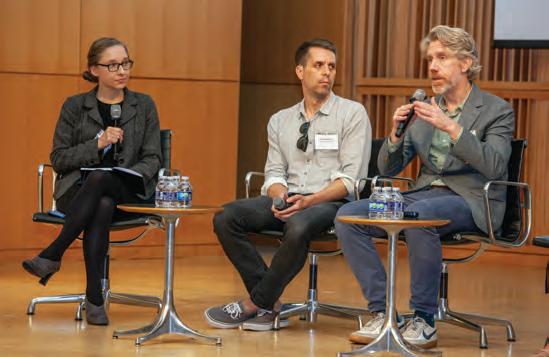


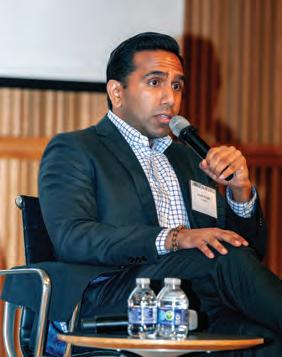
Melissa Burch.
Michael Garner.
Hersh Parekh.
Left to right: Kelly Westby, David McCarthy and Michael Reed.
From left to right: Aislinn McGuire, Nate Grove, Kimberlae Saul and Shari Hyman.
The Plan

WHO’S WHAT AT 140 WEST 81ST STREET
DEVELOPERS: CMC
DEVELOPMENT GROUP, PINNACLE ARCHITECT/INTERIOR DESIGNER: DXA STUDIO CONTRACTOR: BUILDERS GROUP


By Amanda Schiavo
They say a person’s home is their sanctuary. For the future residents of the fiveunit condo building under construction at 140 West 81st Street in Manhattan, that can be taken literally.
Since 1893, the Upper West Side building has housed several religious organizations, most recently the Mount Pleasant Baptist Church. But by 2013, the structure had fallen into a horrible state of disrepair.
The church teamed up with DXA Studio and CMC Developers in 2014 to not only restore the Romanesque Revival structure, but also convert it into luxury condominiums where people can live in homes once occupied as church sanctuary space. At the same time, they wanted to preserve a modern sanctuary space,
classrooms and offices for the church. The complex conversion project is currently 90 percent complete.
The facade of the building still resembles a church. You could walk by it 100 times and never realize people were living there in luxury residences, especially when you look at the most eye-catching part of the exterior, the rose window.
This remarkable stained glass work of art is original to the building but has been restored. Work included a new Honduran mahogany frame and metal structure, and the removal of religious iconography.
The 3,608-square-foot Rose House — as the fifth-floor unit is known — features four bedrooms and four and a half baths. The great room, where the rose window is located, will no doubt be the focal point of this home. Place a comfortable chair or chaise under the window, and it becomes


the perfect spot for coffee and a good book, especially when sunlight comes streaming through.
“The rose window that we restored is the identity of that unit,” Sando Thordarson, principal at DXA, said while touring the building with Commercial Observer.
Each unit has its own identity. There is the four-bedroom Garden House, which spans 2,802 square feet and features four bathrooms plus a 1,775-square-foot garden terrace.
The Grand House stretches 3,903 square feet and also features four bedrooms, as well as four and a half baths. It is called the Grand House because it is a large, double-height space.
The Collector’s House features four bedrooms and four and a half baths across 3,522 square feet. The Light House
sits on the penthouse floor and has 4,025 square feet of interior space across two floors, plus 352 square feet of outdoor terrace.
The Light House features a library mezzanine that would make the perfect cozy reading hideaway, especially on a rainy day. Introverts will feel very much at home.
“In terms of the finished package, the kitchens are insane,” Thordarson said when describing the elements of each unit. “There is a 36-inch fridge and freezer, and the baths and powder rooms have an opulent slab and somewhat minimal aesthetic.”
Completing the penthouse is the last task before the units head to market, priced between $8 million and $10 million. The building will also feature a small gym and a tenant storage area.
GO TELL IT ON THE MOUNT: This former church (most recently Mount Pleasant Baptist) was converted into five luxury condos with an eye toward preserving the original stained glass work. However, there are new details throughout, including modern kitchens with 36-inch refrigerator and freezers. The penthouse is called the Light House for obvious reasons, and features a library mezzanine.

June 24 | Paramount Club, New York | 8:00 AM
Don’t miss your opportunity to hear from major retailers, restaurateurs, hospitality chains and the real estate industry’s preeminent leaders as they share key strategies for stabilizing the industries that have been tackling constant twists and turns in an everchanging market.
KEYNOTE KEYNOTE
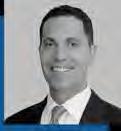
MIKE O’NEILL Vice Chair Cushman & Wakefield

DAYSSI OLARTE DE KANAVOS President & COO Flag Luxury Group

MICHELLE SCHRANK Strategy & Design Director Journey

ALEX SMITH Vice President of Real Estate, Americas Kering Americas, Inc.

DANIEL LESSER Co-Founder , President & CEO LW Hospitality Advisors

JOSEPH DELLI SANTI Chief Investment Officer MCR

SURI KASIRER President Kasirer, LLC MODERATOR

KEVIN MCCRAIN Managing Partner, Real Estate Brookfield

BRANDON SINGER Chief Executive Officer & Founder MONA Retail Holdings, LLC


NOURI BEESEMER Senior Director of Hospitality Strategy Related Companies

STEPHANIE MCGOWAN Managing Director Blackstone

HARRION SITOMER Chief Investment Officer SL Green Realty Corp.

LEE BLOCK President RTL

JOÃO OLIVEIRA Director of Business Development Restaurant Associates

JONATHAN A. ADELSBERG Partner; Co-Chair, Real Estate Department; Chair of Leasing Herrick, Feinstein LLP MODERATOR
HOST SPONSOR



JAKE ELGHANAYAN Principal TF Cornerstone

FRED POSNIAK SVP, Leasing ESRT

CLARA FELDMAN Partner & Chair, Luxury Brands Blank Rome LLP MODERATOR

PETER RIPKA Co-Founder/Partner RIPCO Real Estate
EDWARD P. HOGAN Executive Vice President of Retail Leasing Vornado Realty Trust

JOEL ROSEN President GFI Hospitality


DANIELLE LESSER Partner & Chair, Business Litigation Morrison Cohen LLP MODERATOR
ABE SCHLISSELFELD National Real Estate Industry Leader CBIZ MODERATOR
SPONSORS









